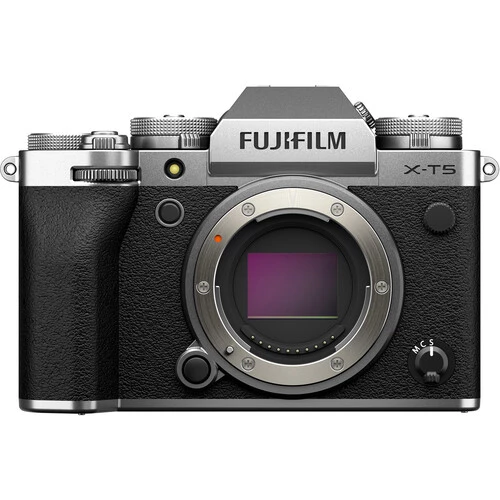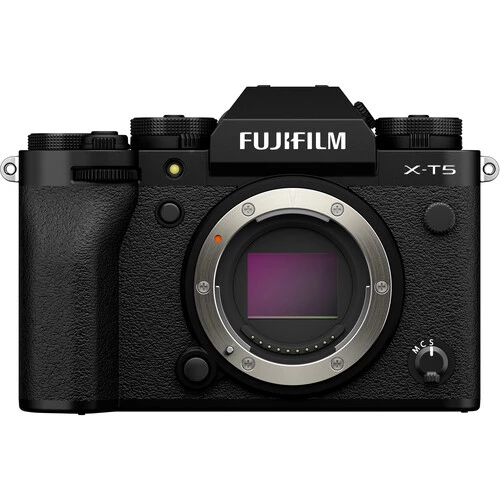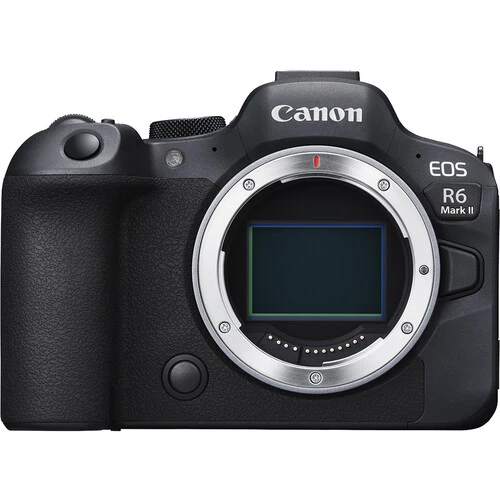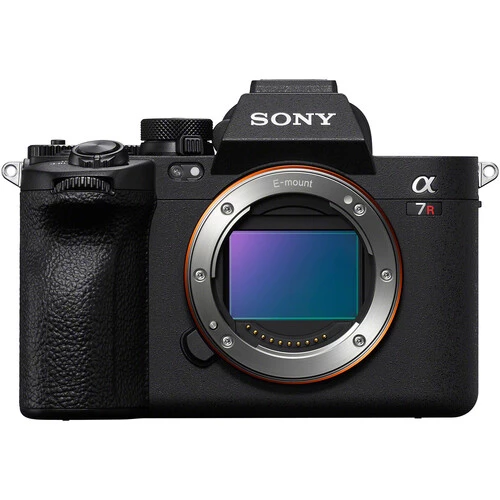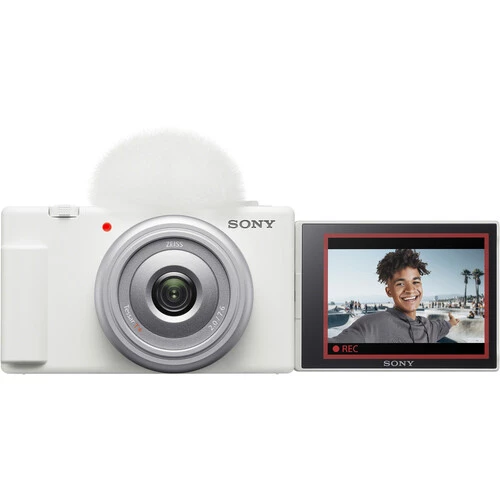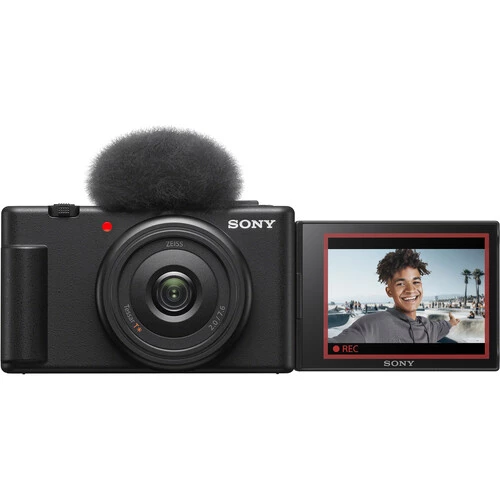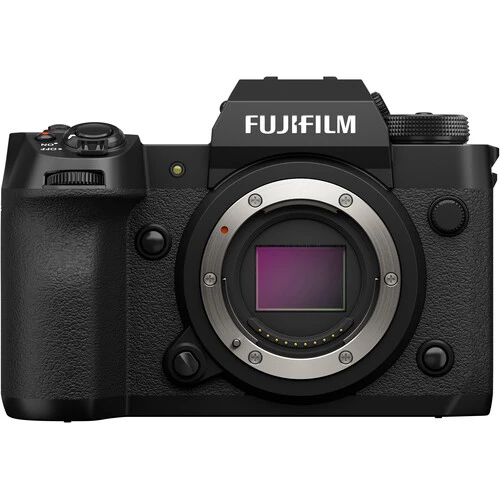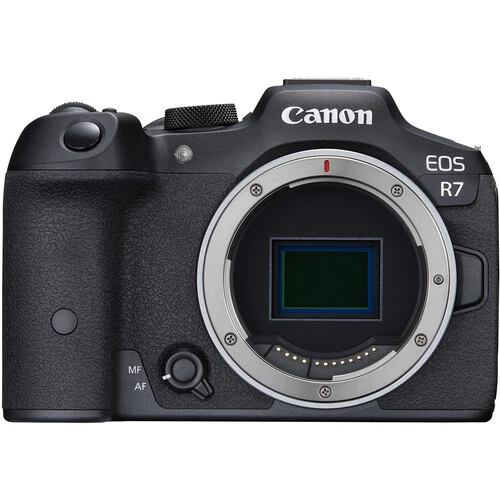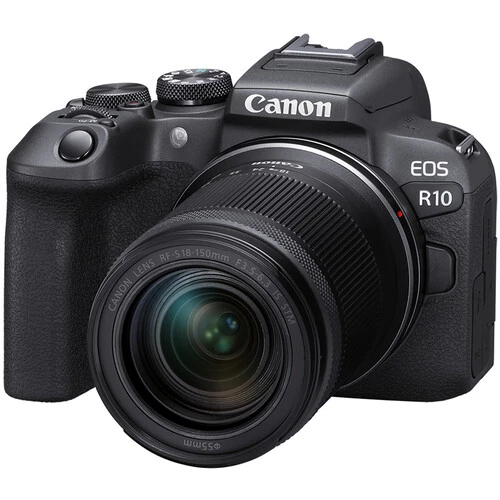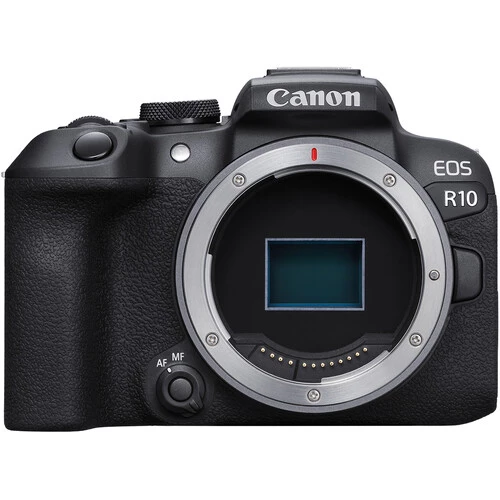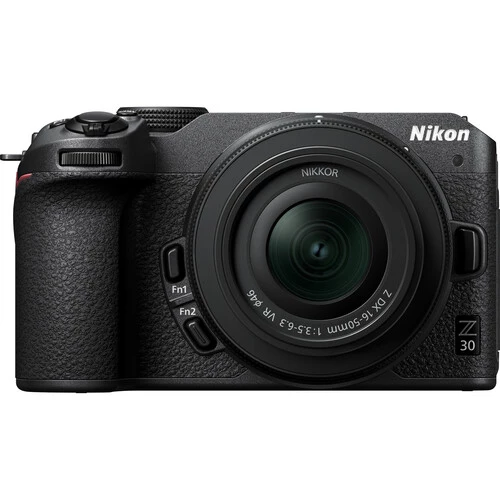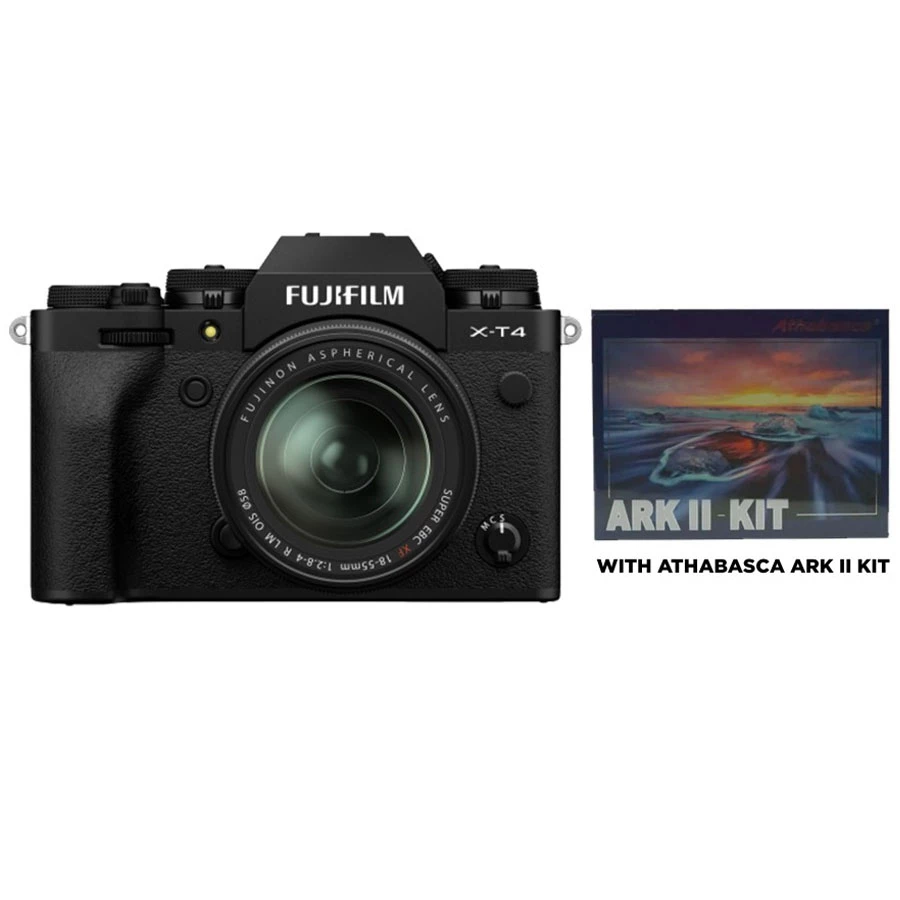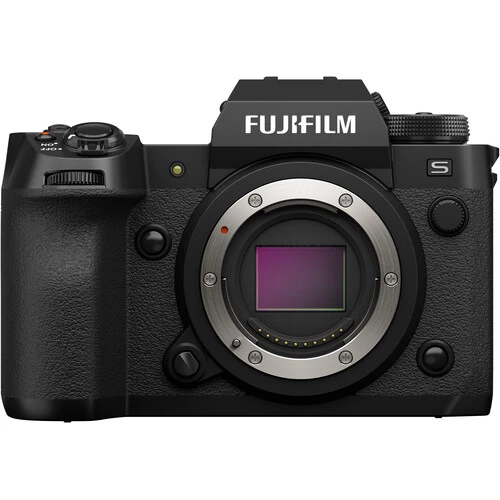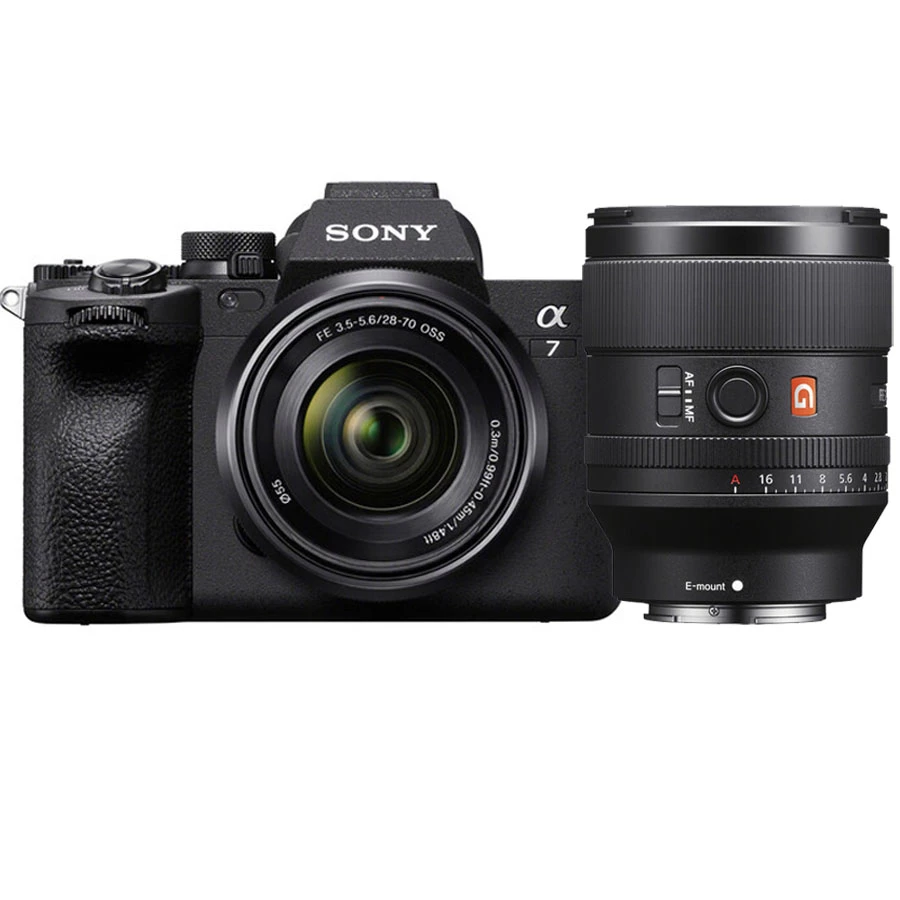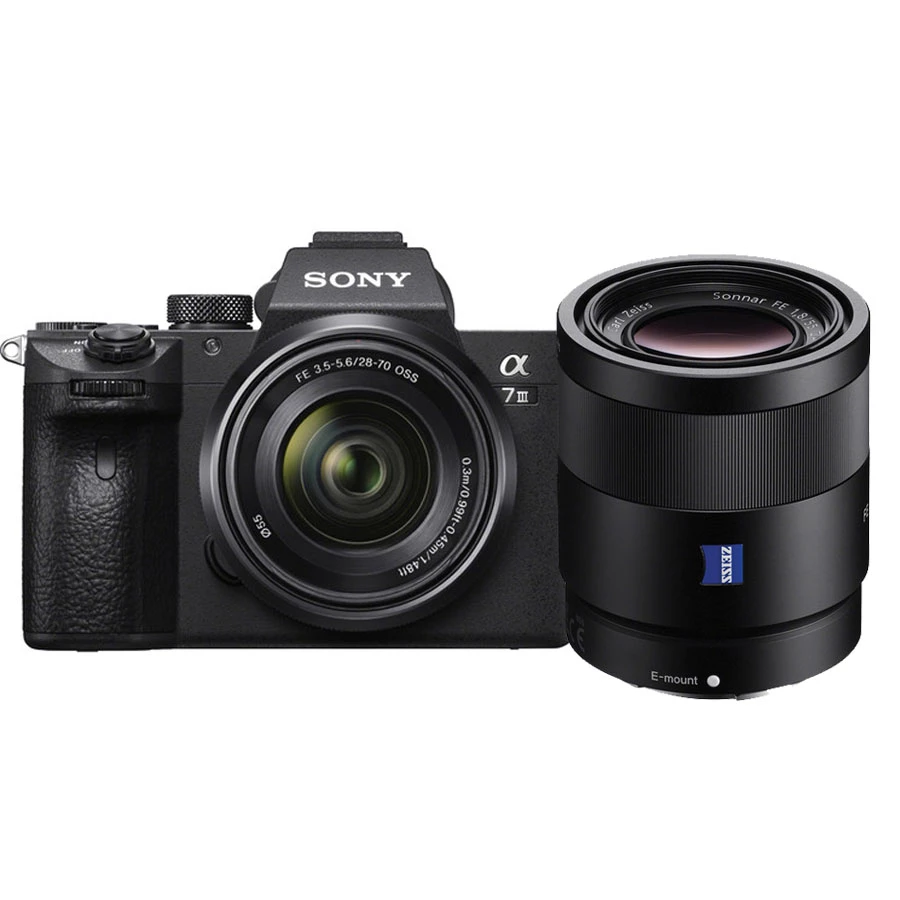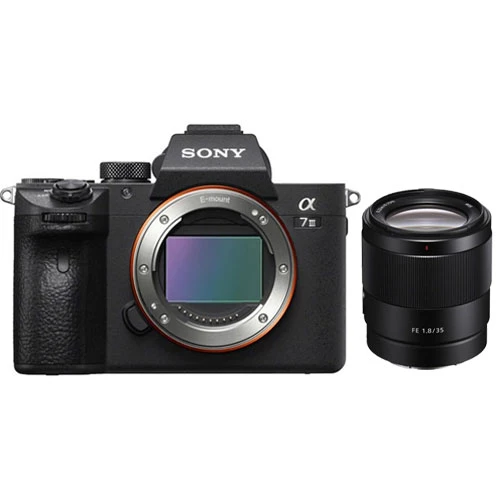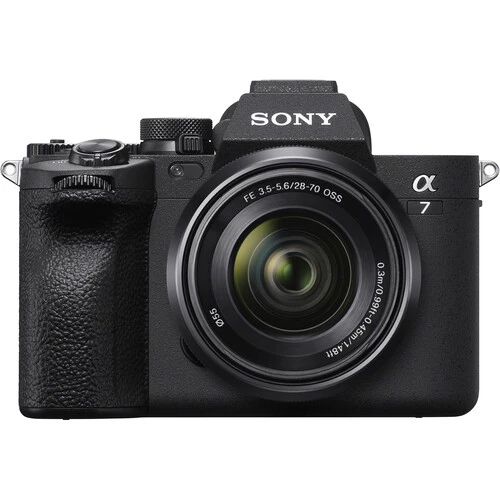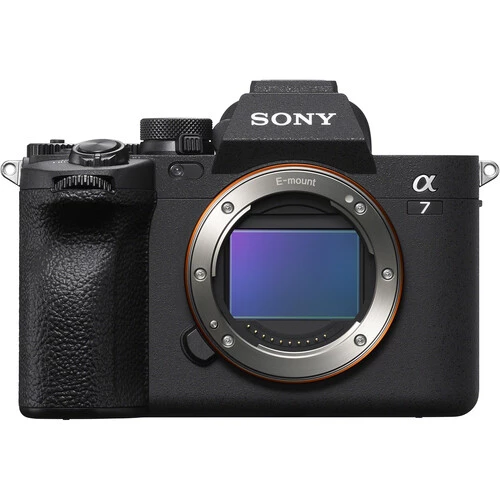FUJIFILM X-T5 Overview
Key Features
- 40MP APS-C X-Trans CMOS 5 HR BSI Sensor
- 4K 120p, 6.2K 30p, FHD 240p 10-Bit Video
- 7-Stop In-Body Image Stabilization
- 425-Point Intelligent Hybrid AF System
- 3.69m-Dot OLED Electronic Viewfinder
- 3" 1.84m-Dot Tilting Touchscreen LCD
- 20 fps E. Shutter, 15 fps Mech. Shutter
- 160MP Pixel Shift Multi-Shot
- Bluetooth and Wi-Fi Connectivity
- ProRes & Blackmagic RAW via HDMI
A portable and powerful multimedia mirrorless camera, the FUJIFILM X-T5 features the newly developed 40MP APS-C X-Trans CMOS 5 HR BSI sensor for simply stunning results. Comparable in size to the original X-T1 and lighter than its predecessor, this camera provides a classic, dial-based layout and cutting-edge technology that includes a seven-stop in-body image stabilization system, Pixel Shift Multi-Shot mode for 160MP files, and action-freezing shutter speeds up to 1/180,000 sec from the electronic shutter. In addition to its versatile suite of stills capabilities, the X-T5 is also a highly capable moviemaking machine, recording up to 6.2K in 4:2:2 10-bit color internally or 12-bit ProRes RAW and Blackmagic RAW via HDMI.
40MP APS-C X-Trans CMOS 5 HR BSI Sensor
Offering the ultimate in image quality, the X-T5 features a 40MP X-Trans 5 HR CMOS sensor in a compact, lightweight body that maximizes functionality and portability. Imaging performance is in no way compromised by the camera's diminutive proportions. Instead, the X-T5's improved image processing algorithm delivers outstanding results and is packed with details right across the native ISO range.
Powerful Video Capabilities
A dynamic camera with powerful video functions, movies can be recorded internally at up to 6.2K at 30p in 4:2:2 10-bit color, plus there's a 4K HQ mode which oversamples 6.2K footage for superior 4K output. This higher video resolution unlocks 2x digital zoom functionality, providing additional in-camera versatility without a noticeable drop in quality.
External Raw Recording
Both F-Log and F-Log2 recording are possible, with the latter providing an expanded dynamic range of 13+ stops. Additionally, 12-bit ProRes RAW and Blackmagic RAW can be output via HDMI to Atomos and Blackmagic devices accordingly.
425-Point Intelligent Hybrid AF System
Featuring outstanding autofocus performance, the X-T5 utilizes 425 phase-detection points and is now sensitive down to -7 EV for working in truly low-light conditions. Also, backed by deep learning, an AI adaptive algorithm means this focusing system is better suited to automatically detect and track animals, athletes, birds, cars, motorcycles, and moving subjects.
In-Body Image Stabilization
Thanks to the camera's in-body image stabilization (IBIS) system, quality-sapping camera shake is minimized. Built-in 5-axis sensor-shift image stabilization helps to minimize the appearance of camera shake by up to 7 stops. This system works in conjunction with most X Series lenses, including non-stabilized ones, and benefits working with slower shutter speeds and when shooting in difficult lighting conditions. Additionally, digital image stabilization can also be used during video recording to further aid in steadying footage, especially when recording handheld.
Pixel Shift Multishot
Utilizing the camera's IBIS system to precisely shift the sensor, Pixel Shift Multishot automatically records 20 separate frames with one press of the shutter release. Resulting files are combined using Pixel Shift Combiner software to quadruple the camera's resolution and produce a detail-rich, 160MP file. Perfect for commercial applications or digital archiving, it's also ideal for any static subject where image quality is of primary importance.
Built for Speed
The X-T5 provides powerful image making performance to ensure it's ready for action, no matter how fast your subject is moving. A top electronic shutter speed of 1/180,000 sec and a maximum mechanical shutter speed of 1/8000 sec will stop any subject in its tracks, while a lag time of just 35 ms gives an almost instantaneous response when the shutter release is pressed. Keep a finger down, and the X-T5 will record images at up to 15 fps with the mechanical shutter, or 20 fps with the electronic shutter. Either way, no important moment will be missed.
Film Simulation Modes
Film Simulation modes allow you to reproduce the look and feel of several of FUJIFILM's film types, including Provia, Velvia, Astia, Classic Chrome, PRO Neg.Std, PRO Neg. Hi, Classic Neg., Nostalgic Neg., Eterna Cinema, Eterna Bleach Bypass, Acros, Acros + Ye Filter, Acros + R Filter, Acros + G Filter, Black & White, Black & White + Ye Filter, Black & White + R Filter, Black & White + G Filter, and Sepia.
Enhanced Body Design
- Large OLED electronic viewfinder features a crisp 3.69m-dot resolution for bright, clear, and detailed eye-level viewing. Additionally, this EVF offers 0.8x magnification for an easy-to-view image that is further enhanced by improved suppression of parallax and distortion compared to its predecessor. The 100 fps refresh rate, meanwhile, allows virtually blackout-free image making.
- Large 3.0" 1.62m-dot LCD touchscreen for intuitive operation and playback, and the tilting design greatly benefits working from high and low shooting angles.
- Utilizing an NP-W235 battery, up to 680 frames can be recorded from a single charge, plus the mechanical shutter guarantees 500,000 actuations, delivering long-term accuracy and reliability.
Connectivity
- Micro-HDMI port for outputting video to an external recorder or monitor.
- USB 3.2 Gen 2 port supports tethering, data transfer, and in-camera battery charging.
- 3.5mm external microphone port for greater control over audio recording.
- PC sync port for flash sync.
- 2.5mm remote port for using wired remote controllers.
- Integrated Bluetooth and Wi-Fi connectivity allows for wirelessly sharing images to a mobile device or to use the device to remotely control the camera.


Fujifilm X-T5 Overview
Key Features
- 40MP APS-C X-Trans CMOS 5 HR BSI Sensor
- 4K 120p, 6.2K 30p, FHD 240p 10-Bit Video
- 7-Stop In-Body Image Stabilization
- 425-Point Intelligent Hybrid AF System
- 3.69m-Dot OLED Electronic Viewfinder
- 3" 1.84m-Dot Tilting Touchscreen LCD
- 20 fps E. Shutter, 15 fps Mech. Shutter
- 160MP Pixel Shift Multi-Shot
- Bluetooth and Wi-Fi Connectivity
- ProRes & Blackmagic RAW via HDMI
A portable and powerful multimedia mirrorless camera, the FUJIFILM X-T5 features the newly developed 40MP APS-C X-Trans CMOS 5 HR BSI sensor for simply stunning results. Comparable in size to the original X-T1 and lighter than its predecessor, this camera provides a classic, dial-based layout and cutting-edge technology that includes a seven-stop in-body image stabilization system, Pixel Shift Multi-Shot mode for 160MP files, and action-freezing shutter speeds up to 1/180,000 sec from the electronic shutter. In addition to its versatile suite of stills capabilities, the X-T5 is also a highly capable moviemaking machine, recording up to 6.2K in 4:2:2 10-bit color internally or 12-bit ProRes RAW and Blackmagic RAW via HDMI.
40MP APS-C X-Trans CMOS 5 HR BSI Sensor
Offering the ultimate in image quality, the X-T5 features a 40MP X-Trans 5 HR CMOS sensor in a compact, lightweight body that maximizes functionality and portability. Imaging performance is in no way compromised by the camera's diminutive proportions. Instead, the X-T5's improved image processing algorithm delivers outstanding results and is packed with details right across the native ISO range.
Powerful Video Capabilities
A dynamic camera with powerful video functions, movies can be recorded internally at up to 6.2K at 30p in 4:2:2 10-bit color, plus there's a 4K HQ mode which oversamples 6.2K footage for superior 4K output. This higher video resolution unlocks 2x digital zoom functionality, providing additional in-camera versatility without a noticeable drop in quality.
External Raw Recording
Both F-Log and F-Log2 recording are possible, with the latter providing an expanded dynamic range of 13+ stops. Additionally, 12-bit ProRes RAW and Blackmagic RAW can be output via HDMI to Atomos and Blackmagic devices accordingly.
425-Point Intelligent Hybrid AF System
Featuring outstanding autofocus performance, the X-T5 utilizes 425 phase-detection points and is now sensitive down to -7 EV for working in truly low-light conditions. Also, backed by deep learning, an AI adaptive algorithm means this focusing system is better suited to automatically detect and track animals, athletes, birds, cars, motorcycles, and moving subjects.
In-Body Image Stabilization
Thanks to the camera's in-body image stabilization (IBIS) system, quality-sapping camera shake is minimized. Built-in 5-axis sensor-shift image stabilization helps to minimize the appearance of camera shake by up to 7 stops. This system works in conjunction with most X Series lenses, including non-stabilized ones, and benefits working with slower shutter speeds and when shooting in difficult lighting conditions. Additionally, digital image stabilization can also be used during video recording to further aid in steadying footage, especially when recording handheld.
Pixel Shift Multishot
Utilizing the camera's IBIS system to precisely shift the sensor, Pixel Shift Multishot automatically records 20 separate frames with one press of the shutter release. Resulting files are combined using Pixel Shift Combiner software to quadruple the camera's resolution and produce a detail-rich, 160MP file. Perfect for commercial applications or digital archiving, it's also ideal for any static subject where image quality is of primary importance.
Built for Speed
The X-T5 provides powerful image making performance to ensure it's ready for action, no matter how fast your subject is moving. A top electronic shutter speed of 1/180,000 sec and a maximum mechanical shutter speed of 1/8000 sec will stop any subject in its tracks, while a lag time of just 35 ms gives an almost instantaneous response when the shutter release is pressed. Keep a finger down, and the X-T5 will record images at up to 15 fps with the mechanical shutter, or 20 fps with the electronic shutter. Either way, no important moment will be missed.
Film Simulation Modes
Film Simulation modes allow you to reproduce the look and feel of several of FUJIFILM's film types, including Provia, Velvia, Astia, Classic Chrome, PRO Neg.Std, PRO Neg. Hi, Classic Neg., Nostalgic Neg., Eterna Cinema, Eterna Bleach Bypass, Acros, Acros + Ye Filter, Acros + R Filter, Acros + G Filter, Black & White, Black & White + Ye Filter, Black & White + R Filter, Black & White + G Filter, and Sepia.
Enhanced Body Design
- Large OLED electronic viewfinder features a crisp 3.69m-dot resolution for bright, clear, and detailed eye-level viewing. Additionally, this EVF offers 0.8x magnification for an easy-to-view image that is further enhanced by improved suppression of parallax and distortion compared to its predecessor. The 100 fps refresh rate, meanwhile, allows virtually blackout-free image making.
- Large 3.0" 1.62m-dot LCD touchscreen for intuitive operation and playback, and the tilting design greatly benefits working from high and low shooting angles.
- Utilizing an NP-W235 battery, up to 680 frames can be recorded from a single charge, plus the mechanical shutter guarantees 500,000 actuations, delivering long-term accuracy and reliability.
Connectivity
- Micro-HDMI port for outputting video to an external recorder or monitor.
- USB 3.2 Gen 2 port supports tethering, data transfer, and in-camera battery charging.
- 3.5mm external microphone port for greater control over audio recording.
- PC sync port for flash sync.
- 2.5mm remote port for using wired remote controllers.
- Integrated Bluetooth and Wi-Fi connectivity allows for wirelessly sharing images to a mobile device or to use the device to remotely control the camera.


Canon R6 Mark II Overview
Key Features
- 24.2MP Full-Frame CMOS Sensor
- 4K60 10-Bit Internal Video, C-Log 3
- External 6K ProRes RAW Recording
- Dual Pixel CMOS AF II
- 12 fps Mech. Shutter, 40 fps E. Shutter
- Sensor-Shift 5-Axis Image Stabilization
- 3.69m-Dot OLED EVF
- 3" 1.62m-Dot Vari-Angle Touchscreen LCD
- Dual UHS-II Memory Card Slots
- Multi-Function Shoe, Wi-Fi and Bluetooth
The Full-Frame All-Rounder
Matching strong photo performance with apt video capabilities, the Canon EOS R6 Mark II is a versatile mirrorless body for the multimedia creator. An updated 24.2MP CMOS sensor pairs with updated processing for more improved AF, impressive 4K 60p 10-bit video, and faster overall performance. Also, the camera body has been updated for more intuitive handling, including a redesigned top plate for easier access to different shooting modes.
24.2MP Full-Frame Sensor and DIGIC X Processing
Updated Full-Frame Sensor
Hitting a sweet-spot in terms of resolution, the R6 Mark II incorporates a new 24.2MP CMOS sensor that's versatile for both photo and video applications, performs well in low-light conditions, and yields striking and accurate colors.
DIGIC X Processor
Borrowed from the R3, the R6 Mark II's upgraded processing suits the multimedia nature of the camera. Capable of processing high speed bursts as well as high-res 4K video, the DIGIC X supports up to 40 fps continuous shooting with a silent electronic shutter or 12 fps with a mechanical shutter, with AF and AE readings before each frame. There is also a 30 fps RAW Burst mode, which offers pre-release capture to record moments that happened up to 0.5-sec before you press the shutter.
Also, improved processing leads to improved low-light performance, with the sensitivity range now extending from ISO 100-102400, and expandable to ISO 204800 for working in very difficult lighting conditions.
UHD 4K Video Recording
Beyond stills, the R6 Mark II's sensor also offers high-res UHD 4K 60p internal video using the full width of the sensor and the ability to work with 10-bit sampling with Canon Log 3. A 6K recording area can also be used for oversampled 4K shooting at 30p for improved sharpness, reduced moiré, and lower noise. And, for slow-motion playback, 180p recording is supported at up to Full HD resolution.
HDR-PQ recording is possible, too, for in-camera HDR production and external recording, via the micro-HDMI port, which supports a clean 6K output at up to 60 fps. Also, unlimited recording times are possible, too, and the R6 Mark II features both mic and headphone ports, as well as a multi-function shoe for wide accessories compatibility.
External 6K Raw Recording
Using the micro-HDMI port, raw video recording is possible when paired with a compatible external recorder. ProRes RAW up to 6K 60p is possible using the full width of the sensor as well as 3.7K raw recording with a crop.
Autofocus and Image Stabilization
Dual Pixel CMOS AF II
- Advanced Dual Pixel CMOS AF II system features 1053 automatic AF points that cover the entire sensor area and provide notably fast, responsive, and precise focusing performance.
- This phase-detection focusing system also has enhanced subject detection and tracking, benefitted by deep learning technology, with the ability to intelligently recognize people, animals, and vehicles. Subject tracking will automatically lock onto these subjects and maintain sharp focus while shooting, even throughout burst captures and when recording video.
- Dual Pixel AF II's low-luminance limit focuses down to an impressive -6.5 EV for accurate focusing even in nighttime conditions.
Sensor-Shift Image Stabilizer
An In-Body Image Stabilizer (IBIS) corrects up to 7 stops of unwanted camera shake when shooting handheld, helping to shoot handheld in low-light conditions and reduce shake when recording videos. This 5-axis system can be also used in conjunction with lenses featuring optical image stabilization to compensate for up to 8 stops of camera shake depending on the specific lens in use. Additionally, Movie Digital IS uses the optical and sensor-shift stabilization methods along with digital IS to help acquire steadier footage while moving.
Body Design
EVF and Vari-Angle Touchscreen LCD
- High-resolution 3.69m-dot 0.5" electronic viewfinder provides a bright and detailed means for eye-level viewing and the quick 120 fps refresh rate offers natural motion rendering for a more realistic viewfinder experience.
- Rear 3.0" 1.62m-dot LCD touchscreen features a vari-angle design that benefits front-facing recording, such as for vlogging needs, as well as working from high and low shooting angles.
- Refined body design incorporates four distinct control dials across the body for intuitive tactile control and a joystick controller is used on the back of the camera for fast and intuitive focus point selection and menu navigation.
Reliable and Intuitive Handling
- An updated top plate design repositions the On/Off dial and Photo/Video mode dial for more intuitive handling.
- Built for everyday use, this camera touts a dust- and moisture-sealed body constructions that's suitable for working in inclement conditions.
- Dual SD memory card slots offer file-saving flexibility and both are rated for UHS-II card speeds to support fluent 4K video recording and high-speed continuous shooting.
Flexible Connectivity
Wired and wireless connectivity options are available, allowing for multiple methods of transferring photos and videos, as well as for remotely controlling the camera.
- USB-C 3.2 Gen 2 port for in-camera charging and file transfers; this port also enables using the camera as a Full HD 30p webcam with support for UVC/UAC protocols
- 3.5mm headphone and external microphone ports
- Micro-HDMI port for working with an external recorder
- Bluetooth and 5/2.4 GHz Wi-Fi for wireless transfers and remote camera control from mobile devices
Next-Generation Multi-Function Shoe
An update to a conventional hot shoe, the Multi-Function Shoe adds a row of pins at the front of the design to permit greater accessory functionality as well as provide power to select accessory types that traditionally rely on separate batteries. This updated shoe is compatible with select accessories, including the EL-5 Speedlite, ST-E10 Speedlite Transmitter, DM-E1D Stereo Microphone, and AD-P1 Smartphone Link Adapter, as well as the AD-E1 Multi-Function Shoe Adapter to provide compatibility with legacy shoe-mounted accessories.
Sony A7R V Overview
Key Features
- 61MP Full-Frame Exmor R BSI CMOS Sensor
- BIONZ XR & AI Processing Unit
- AI-Based Real-Time Tracking AF System
- 8K 24p, 4K 60p, FHD 120p 10-Bit Video
- 4K 16-Bit Raw Output; S-Log3/S-Cinetone
- 9.44m-Dot EVF with 120 fps Refresh Rate
- 3.2" 4-Axis Multi-Angle Touchscreen LCD
- 10 fps Shooting with AF/AE Tracking
- 8-Stop 5-Axis Image Stabilization
- Dual CFexpress Type A/SD Card Slots
Exmor R BSI Sensor and BIONZ XR Processor
61MP Full-Frame CMOS Sensor
Featuring a back-illuminated design, this full-frame 61MP Exmor R CMOS sensor offers a mixture of incredible resolution with high clarity, low noise, and a wide 15-stop dynamic range. The sensor's structure promotes impressive image quality and a copper wiring layer dramatically improves data transmission speed for creating 14-bit, high-resolution 61MP stills with a native sensitivity range from ISO 100-32000, which can be further expanded to ISO 50-102400.
Improved Processing Engine
A new BIONZ XR processing engine offers up to 8x greater processing performance compared to previous generations, which enables faster overall performance, impressive image quality with wide sensitivity and dynamic ranges, and more fluent processing that's capable of handling a bevy of AI tasks and intelligent AF alongside imaging processes. This processing system also reduces rolling shutter and other motion distortions for clean rendering of moving subjects.
In terms of shooting speeds, the sensor and processor enable up to 10 fps shooting, at full resolution with a mechanical shutter, for up to 583 consecutive compressed raw frames, with full-time AF/AE. If shooting JPEG only, more than 1000 frames can be recorded in a single burst.
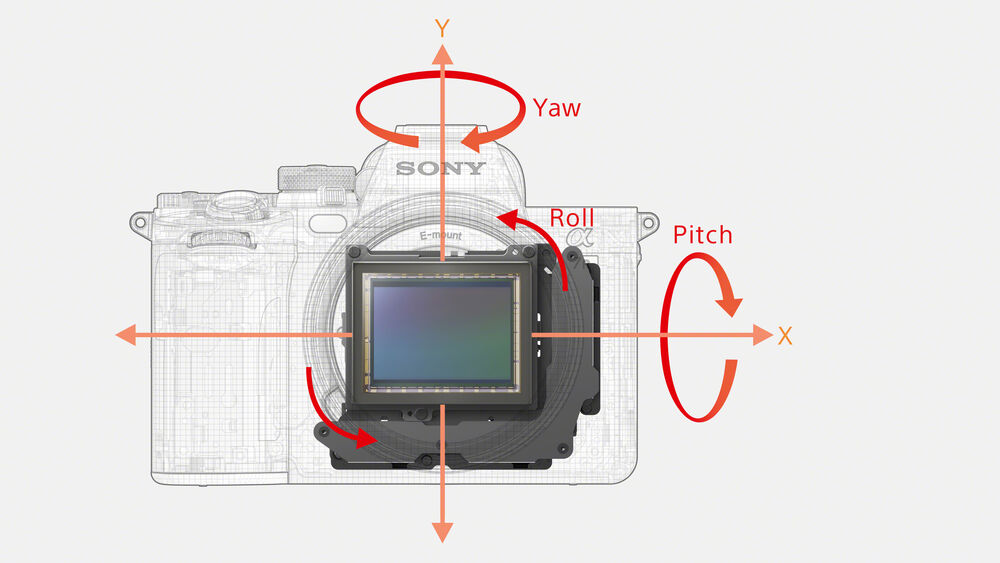
Updated 5-Axis Image Stabilization
- Updated for the a7R V, the in-body image stabilization system has been revised to support up to 8 stops of camera shake compensation. This 5-axis stabilization system combines a high-performance gyro sensor with an optimized algorithm for more precise shake control and improved communication between the camera body and lens.
- Additionally, specifically for video, there is also an Active IS mode that adds even more precise stabilization methods for even smoother footage straight out of camera. Also, this digital stabilization system has been updated with a new algorithm that offers the best stabilization performance when paired with select OSS-enabled lenses.
Pixel Shift Multi Shooting
This unique compositing mode allows you to achieve even greater resolution than the 61MP sensor affords. Working in conjunction with the sensor-shift image stabilization, this mode shifts the sensor while making 16 consecutive exposures in order to acquire approximately 240.8MP of information for greater color accuracy and detail than possible with a single exposure, along with an impressive image size of 19,008 x 12,672-pixels. These files can then be merged together during post-production by using the Sony Imaging software suite.
Accurate Exposure and Color
- New auto-exposure algorithm can detect skin area in faces in order to more accurately balance exposures for portraits. This AE method is approximately 20% more reliable, even in backlit or direct sunlight situations, or even when the subject is not directly facing the camera.
- Deep learning technology, along with external visible light and IR sensors, also contributes to more accurate color reproduction and auto white balance processing.
Next Generation AI-Based Autofocus
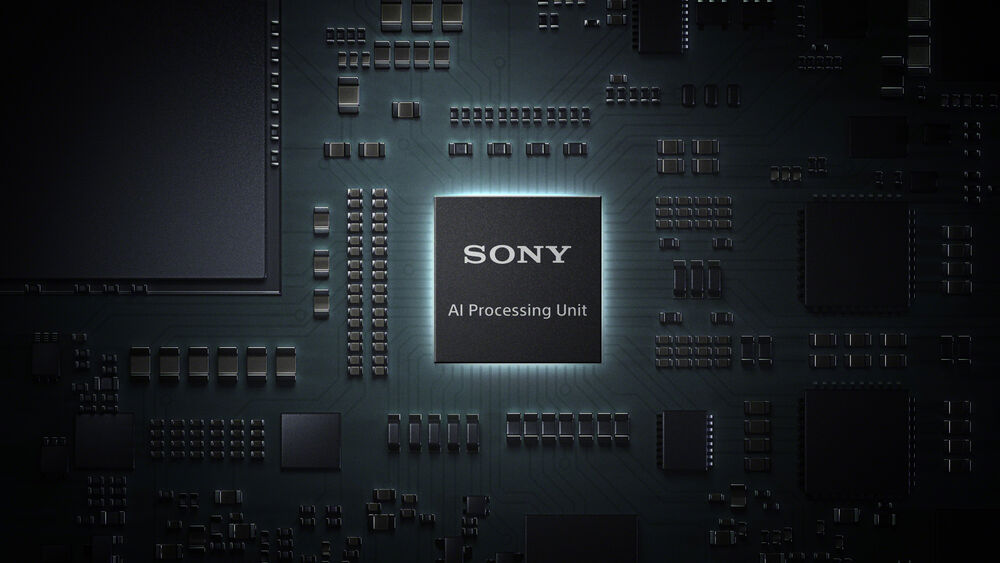
AI Processing Unit
Using dedicated processing, the a7R V's autofocus is greatly benefitted by more intelligent subject tracking and recognition capabilities along with the reliable hybrid AF system Alpha cameras are known for. Real-time Recognition AF works with seven different selectable target types:

- Human, which tracks body and head positions for accurate portraits. Real-time Eye AF performance has also been improved by 60% thanks to the human pose estimation capabilities.
- Animal, Bird, and Animal/Bird modes are now 40% more accurate for tracking and recognizing a variety of animal types. Recognition of these subjects includes dogs, cats, birds and more, with the ability to pinpoint focus on eyes and recognize animal bodies and heads.
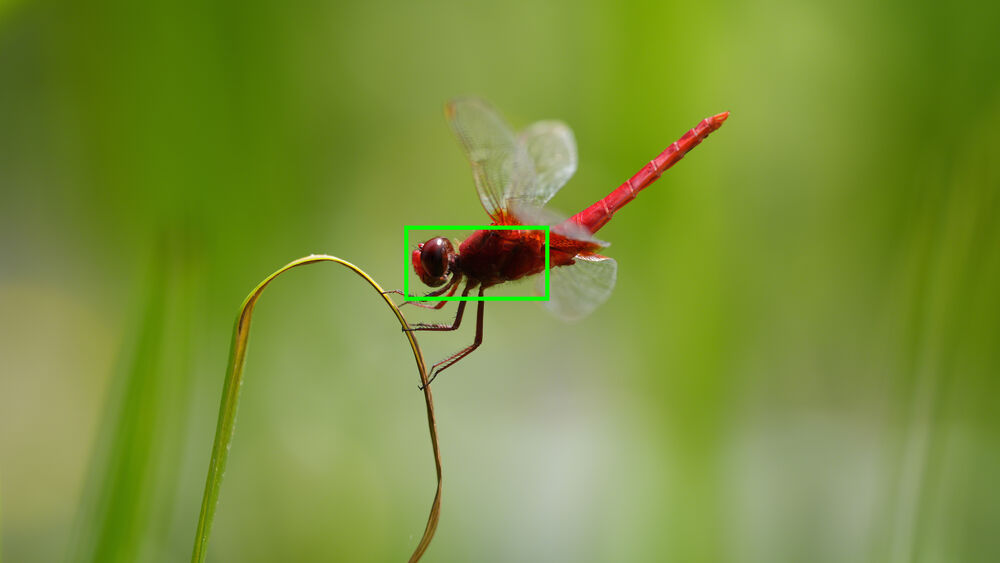
- Insect recognition offers even finer performance with the ability to detect the head or entire insect subject.
- Car/Train and Airplane recognition means the camera can detect the front part of a train, nose of an airplane, or easily detect the entire fast-moving subject.
Real-time Tracking benefits from AI-based subject recognition for following moving subjects, making it particularly well-suited to sports and action subjects. Also, Human pose estimation allows the camera to distinguish between multiple people and maintain focus on the targeted subject; even if someone crosses in front, the camera maintains focus on the key person.
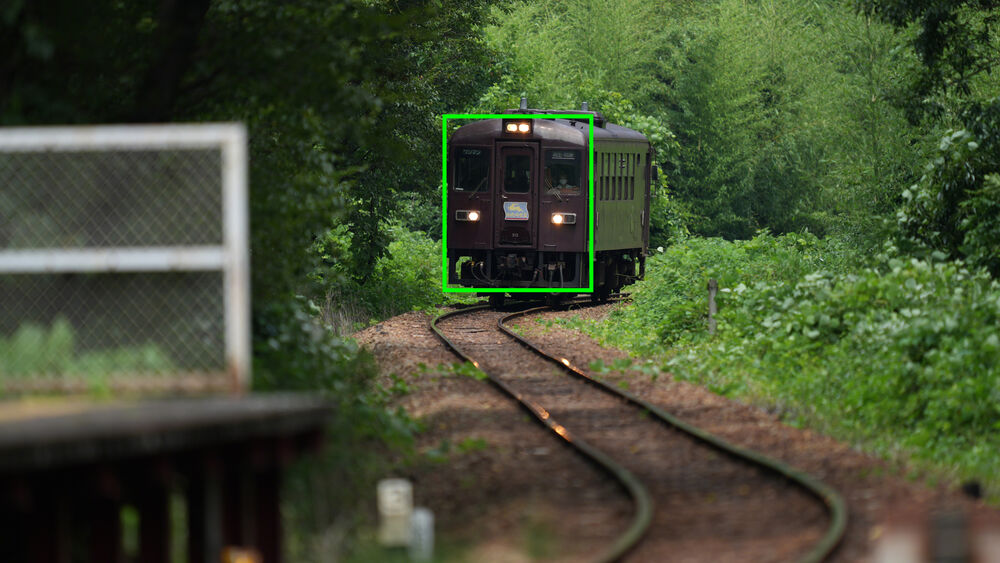
Advanced Fast Hybrid AF
- Covering 79% of the full-frame image area, or 100% of the APS-C cropped area, a Fast Hybrid AF system incorporates a dense 693 phase-detection point grid for quick and precise focusing in a variety of lighting conditions with sensitivity down to -4 EV. This focusing system is available for use in all recording modes, to benefit both video and stills applications.
- Full-time DMF (Direct Manual Focus) enables using the lens's focus ring for manual focus control at any time, making it easier to switch focus to a different subject even when working with AF.
- For photographic moving subjects, this AF system keeps up with the top 10 fps continuous shooting speeds, offering full-time AF tracking between each consecutive frame.
- In-camera Focus Bracketing is possible, with the ability to record up to 299 frames with sequentially shifted focus points for creating composite images during post-production with greater-than-possible depth of field.
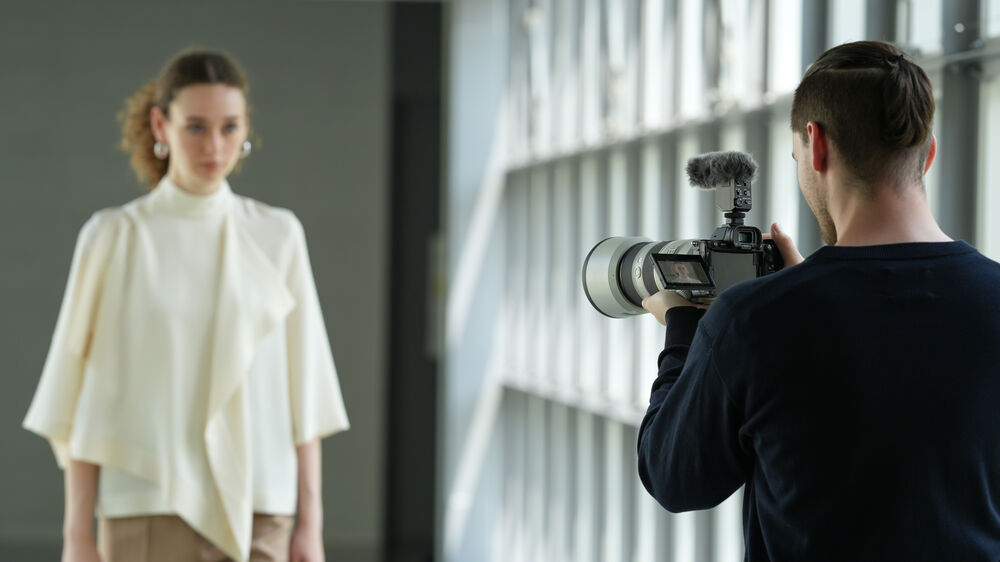
AF During Video Recording
- Real-time Eye AF is fully supported during video recording, for subject detection and tracking of human, animal, and bird eyes while shooting.
- Focus Map is a unique way of visualizing depth of field and functions in a similar way to peaking with a colorful overlay of the scene that indicates which parts of the scene are in front of and behind the focus point depending on the chosen aperture.
- A feature carried over from the FX6 digital cine camera, AF Assist lets you intuitively switch over to manual focus control for adjusting focus position when working with AF. This is a quick way to shift selective focus between various subjects in a scene while recording.
- A unique solution to compensate for how certain lenses perform when racking focus, Focus Breathing compensation will automatically smooth focus transitions and maintain a consistent field of view when changing the focus position during a shot. This mode crops into the image slightly and corrects for any detected shifts in composition when focusing is happening. This function is compatible with select E-mount lenses,
Video Recording
8K 24p and 4K 60p Support
- Making use of the high-resolution sensor and fast processing capabilities, UHD 8K 24p and UHD 4K 60p XAVC HS 10-bit video recording is possible using the full width of the sensor with full pixel readout for impressive sharpness and realism.
- If using a Super 35 crop, full pixel readout recording is possible at up to UHD 4K at frame rates up to 30p or 6.2K oversampling can be used for greater sharpness and detail.
- Internal 10-bit 4:2:2 sampling is possible at up to 4K 60p in XAVC HS and XAVC S-I and, if recording externally via the full-size HDMI A port, 16-bit raw output can be used for even greater tonal reproduction and post-production flexibility.
- Raw output is supported at up to 4K 60p and simultaneous internal 4K recording is possible, too.
Recording Flexibility
- The a7R V employs a pair of codecs to suit different workflows: XAVC HS, which uses HEVC/H.265 encoding to retain more detail at smaller bitrates and XAVC S-I, which is an intraframe codec for consistent performance and quality at higher bitrates.
- If recording in Full HD, high-speed, 120 fps recording enables 4x and 5x slow-motion movie recording with the frame rate playback set to either 30p or 24p.
- No recording time limit allows for unlimited clip lengths and the camera's physical design features an improved heat-dissipating structure to promote longer possible recording times.
Advanced Color Control
- S-Cinetone can be used to deliver distinct colors and healthy-looking skin tone rendering that matches the FX9, FX6, a1, and a7S III cameras and is based on technology from the professional Cinema Line cameras, such as the VENICE. This color profile offers natural mid-tones, soft colors, and especially well-controlled highlights.
- Affording extensive customizable color and gamma controls, the you can adjust the gamma, black level, knee, color level, and more. Also, users can use the same S-Log2 Gamma Curve that is found on high end Sony Cinema cameras that squeezes up to 1300% more dynamic range into the video signal then traditional REC709, for increased post-production flexibility.
- HLG (Hybrid Log-Gamma) support is also available, along with the BT.2020 color space, for recording within a wide color gamut and, in addition to S-Log2, S-Log3 is also available for producing a 15+-stop dynamic range with increased grading control in the shadow to mid-tone regions of the image.
Body Design and Connectivity
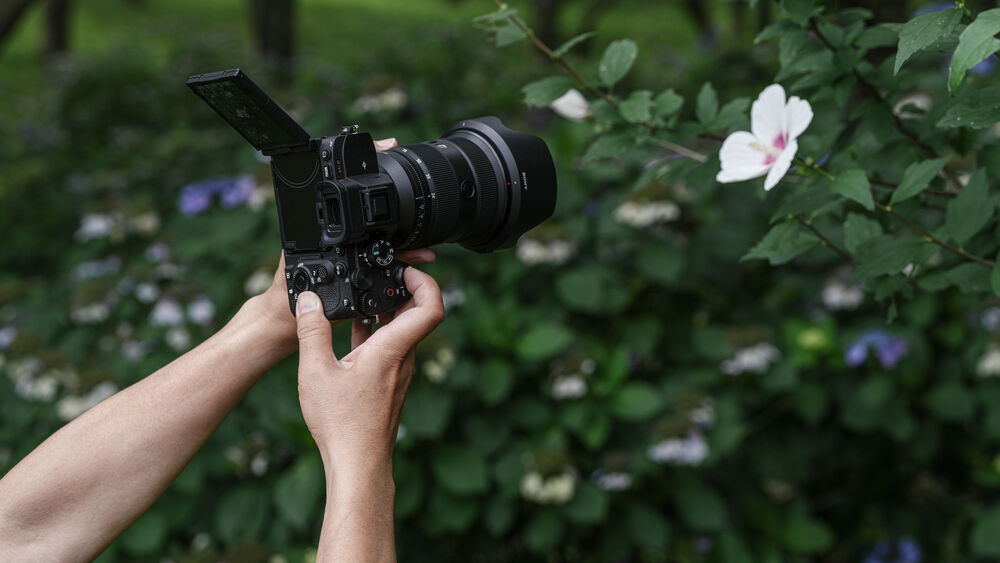
9.44m-Dot EVF and 4-Axis Multi-Angle LCD
- Sporting a new, more functional LCD design, the a7R V has a 4-axis multi-angle LCD monitor that combines the best assets of both tilting and side-open/flip-out vari-angle designs.
- This 3.2" 2.1m-dot LCD also has a touchscreen design and a DCI-P3 wide gamut for accurate color monitoring.
- An impressive QXGA OLED Tru-Finder EVF features a high 9.44m-dot resolution and 0.9x magnification for exceptionally bright, clear, and detailed eye-level viewing.
- The EVF permits 120 fps playback for smooth motion rendering and the finder's physical design has a long 25mm eye point, 41° field of view, and features a fluorine coating on the outermost viewfinder element to benefit cleaning.
Versatile and Durable Design
- Dual memory card slots both accept either CFexpress Type A or SD-type memory cards. The dual slot design allows for flexible file saving and handling and can be configured to partition file types or can be used for overflow recording. Additionally, both of the card slots are rated to support UHS-II memory cards for faster transfer speeds.
- Accepts the high-capacity NP-FZ100 rechargeable lithium-ion battery, which provides approximately 440 shots/90 minutes of recording per charge when using the viewfinder or 530 shots/100 minutes of recording per charge when using the rear LCD.
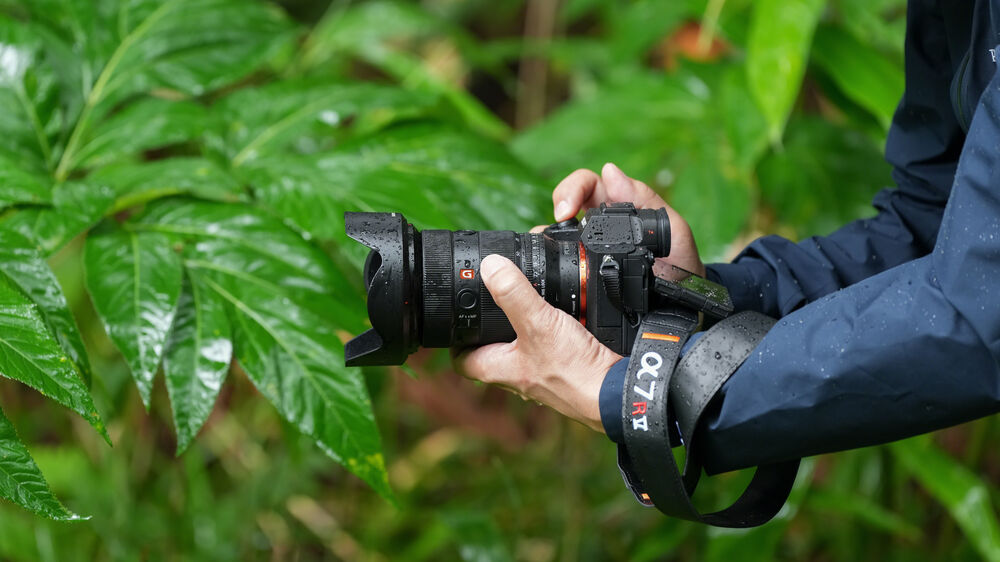
- Magnesium alloy chassis assures rigidity, durability, and stability while remaining lightweight. The lens mount has also been improved to better support heavy lenses, and the grip rigidity has been improved for more comfortable hand-holding.
- Extensive weather-sealing, including enhanced sealing around the battery cover, terminal cover, and chassis joints, has been employed to resist dust and moisture for reliable operation in harsh weather conditions.
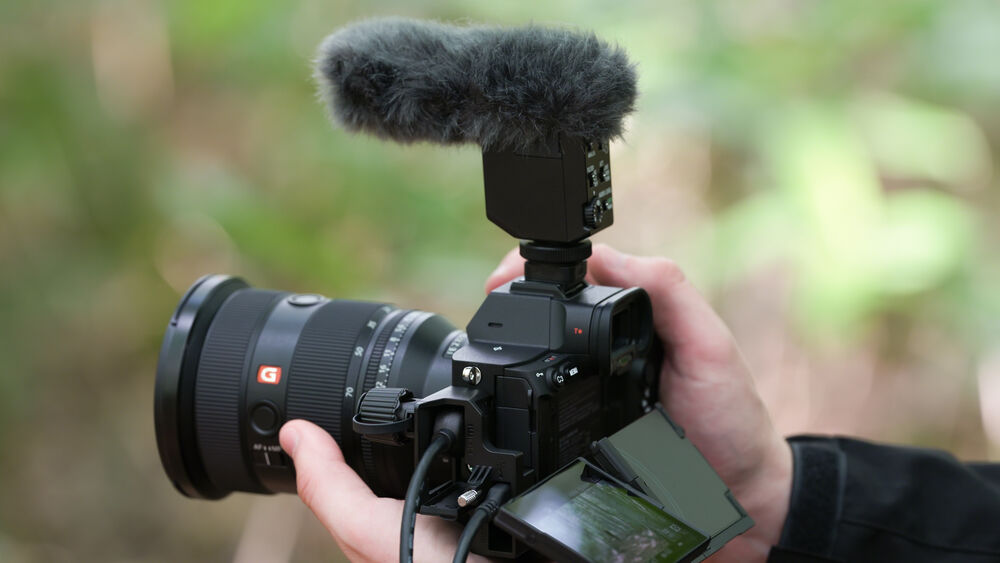
Ports and Interface
- Full-size HDMI A port offers a more reliable connection when working with external recorders.
- A USB-C 3.2 Gen 2 port has been added, in addition to a micro-USB port, for faster, more reliable tethering support. The USB-C connection allows the camera to be charged or powered from the host power source while connected.
- PC sync terminal for wired flash sync with strobe packs or wireless radio remotes.
- Both 3.5mm headphone and external microphone ports facilitate greater control over audio recording.
- Multi Interface Shoe supports working with the optional ECM-B1M Shotgun Microphone or XLR-K3M XLR Adapter Kit, which provide improved, clear audio recording sound by sending a digital audio signal to the camera, opposed to an analog signal.

Connectivity
- Built-in Wi-Fi and NFC enables the a7R V to instantly share imagery to mobile devices for direct sharing online, and support for both 2.4 and 5 GHz bands also enables wireless tethered shooting support. Also, the 5 GHz band supports 2x2 MIMO for fast communication speeds and dual antennas ensure a reliable connection.
- Bluetooth connectivity allows for location data acquisition.
- Supports 4K webcam use and is UVC/UAC compliant for simple operation. Internal recording is also supported while live streaming.
- USB-C port, when used in conjunction with an optional USB-Ethernet adapter, offers up to 1000BASE-T speeds for quick wired LAN sharing and remote operation.
- Imaging Edge Remote for desktop supports PC Remote shooting via the Wi-Fi connection or tethered by the wired USB-C port. An updated data transfer control also makes it possible to transfer files from an SD card over Wi-Fi using the Imaging Edge Mobile app even when the camera is powered off.
Sony ZV-1F Overview
Key Features
- 20.1MP 1" Exmor RS BSI CMOS Sensor
- BIONZ X Image Processor
- ZEISS 20mm-Equivalent f/2-f/8 Lens
- UHD 4K30p Video Recording
- 3.0" Side Flip-Out Touchscreen LCD
- Background Defocus & Face Priority AE
- 5x Slow Motion & 60x Hyperlapse Modes
- Directional 3-Capsule Mic & Mic Jack
- High-Quality Livestreaming
- Easy Smartphone Connection
Specifically designed for vloggers and online content creators, the Sony ZV-1F Vlogging Camera is a pocket-sized camera with a large 1" sensor and a 20mm-equivalent wide-angle lens. The camera allows you to snap a group selfie with an expansive view of the background scenery and get everything in the frame, even at arm's length. The lens captures a wider field of view than the human eye, enabling you to take images with eye-popping depth and perspective both indoors and outdoors. Small and lightweight, the camera is meant to be taken out and about so you can capture everyday life with ease and grab content on the go. Featuring a flip-out 3.0" touchscreen and a directional 3-capsule microphone perfect for front-facing recording, the ZV-1F also caters to those who appreciate the camera's unique Product Showcase setting, background Defocus function, real-time Eye AF (autofocus), Face Priority AE (auto-exposure), plus a new touchscreen interface, making it easier to use.
Fast and Intelligent Autofocus
Offering 425 contrast detection AF points to cover a wide area of the captured image, the ZV-1F provides high precision focusing to make sure your footage stays razor sharp. And with Eye AF mode, the camera automatically recognizes human faces and eyes, making sure your subject stays in focus in front of the lens. And switching the focus to another focal point is as easy as touching the screen. There's no need to worry about lighting either, as Face Priority AE will automatically brighten you or your subject's face.
Easy Bokeh at the Touch of a Button
With just a press of the bokeh switch, the ZV-1F lets you get beautiful defocused backgrounds like a pro. The camera's large 1" image sensor and wide f/2 aperture lens allows for true optical bokeh. Select defocus to make the main subject stand out against the defocused background bokeh, or select clear to keep the entire image in focus.
Impressive Colors to Match Your Style
Capture beautiful images to match your personal style. Choose from one of 10 available creative style presets for pro-level footage without worrying about complicated editing. Creative styles can instantly enhance contrast, highlights, shadows, saturation, sharpness, and clarity.
Beautiful Skin Tones for Everyone
Look your best any time you're shooting. Without any special settings, the camera accurately captures skin tones, ensuring a healthy and natural look. There's also a Soft Skin Effect mode to adjust skin smoothness.
Steady Footage While Walking
Showing your viewers the world around you makes for engaging content, but shaky footage can be distracting. The ZV-1F allows you to capture video clearly even while walking. Active Mode image stabilization helps to minimize image blur from handheld shooting for steadier shots.
Slow Motion & Speed
Capture touching moments in slow motion or ramp up the energy for dramatic scenes without any editing. With the ZV-1F you can easily adjust the footage speed just by pressing the Slow and Quick button. Shoot smooth video at speeds up to 5x slower, or use hyperlapse shooting to make the video up to 60x faster and bring your vision to life.
Product Showcase Setting
Put your products center stage with a single touch. Just activate the Product Showcase setting, and simply hold a product in the center of the frame. The camera will automatically focus on it with no additional gestures needed, letting your viewers concentrate on what counts.
Select the Best Scenes
The ZV-1F lets you transfer the scenes you need, saving time and storage space. By adding a Shot Mark while shooting or replaying a video, you can cut out a 15, 30, or 60 second clip to send straight to your smartphone. Shot Marks also allow you to easily find the scenes you want to use, cutting down on time searching through footage later.
Vertical Video Made Simple
Shoot vertical videos for social media just like you do on your smartphone. The ZV-1F also gives you the option of rotating horizontal video in-camera with no extra editing required. What's more, vertical videos are automatically tagged so you can transfer them straight to your smartphone, letting you get your content out to the world quickly.
Clear Voice Recording
Indoors or outdoors, the ZV-1F is designed to capture your voice clearly no matter where you're shooting. The built-in directional 3-capsule microphone collects sound from the front of the camera, giving you high-quality audio, so you can put your energy into creativity instead of worrying about the sound while recording. Additionally, when shooting outdoors and battling the wind, the camera can still record your voice clearly thanks to the supplied wind screen that drastically reduces wind noise.
Easy Smartphone Connectivity
Transfer all your recorded images and videos to your smartphone over Wi-Fi through the Imaging Edge Mobile Plus app. The app also turns your phone into a remote control for remote shooting.
Intuitive Controls
First-time camera users can easily jump straight into shooting. Control icons are displayed on the screen and are easily adjustable with just a touch, so there's no need to study complex settings.
Simple Streaming
Transform the ZV-1F into a high-quality web camera by simply connecting a compatible device via USB. The 1" image sensor and Creative Look mode ensure vibrant visuals, while the directional 3-capsule microphone gives you excellent audio.
Low Light Performance
The ZV-1F lets you capture clear video with little noise even when shooting in dimly-lit locations. While shooting in Intelligent Auto mode, you can now shoot video with the background blurred to the maximum possible extent, allowing the main subject to be captured more clearly and giving your videos extra impact.
Step-Controlled Step Zoom
With just a touch of the LCD panel, you can easily zoom into your preferred view. You can select from 1x, 1.5x, 2x, and 4x to quickly change the angle of view to make sure you capture your best side.
Recording Lamp
Say goodbye to accidentally missing the action. When you press record, the recording lamp glows red and a red frame appears on the screen, letting you instantly know that you're capturing what counts.
Self-Timer Countdown
From dance videos to action shots, the ZV-1F lets you start shooting when you're ready without a panic. The large self-timer countdown appears in the center of the screen so you can clearly see when it's time to begin.
Long Battery Life
With the ZV-1F you can enjoy shooting on the go without worrying about running out of battery power. The camera includes a rechargeable battery that can be charged via the camera's USB-C port, giving you plenty of options for powering on through a shoot.
Optional Shooting Grip
Compatible with the optional GP-VPT2BT shooting grip, this device enables you to grab more stable shots and also doubles as a tripod. The grip easily rotates to have the zoom lever and recording button on either side, so you don't have to stretch around the camera body to reach key buttons.
Optional External Microphones
Raise your audio quality even further through connecting external microphones. Compatible with the ECM-G1 vlogger microphone, this mic captures sound directly in the front of the camera and minimizes unwanted noise from elsewhere. You can also record your voice from a distance with the optional ECM-W2BT wireless microphone.
Sony ZV-1F Overview
Key Features
- 20.1MP 1" Exmor RS BSI CMOS Sensor
- BIONZ X Image Processor
- ZEISS 20mm-Equivalent f/2-f/8 Lens
- UHD 4K30p Video Recording
- 3.0" Side Flip-Out Touchscreen LCD
- Background Defocus & Face Priority AE
- 5x Slow Motion & 60x Hyperlapse Modes
- Directional 3-Capsule Mic & Mic Jack
- High-Quality Livestreaming
- Easy Smartphone Connection
Specifically designed for vloggers and online content creators, the Sony ZV-1F Vlogging Camera is a pocket-sized camera with a large 1" sensor and a 20mm-equivalent wide-angle lens. The camera allows you to snap a group selfie with an expansive view of the background scenery and get everything in the frame, even at arm's length. The lens captures a wider field of view than the human eye, enabling you to take images with eye-popping depth and perspective both indoors and outdoors. Small and lightweight, the camera is meant to be taken out and about so you can capture everyday life with ease and grab content on the go. Featuring a flip-out 3.0" touchscreen and a directional 3-capsule microphone perfect for front-facing recording, the ZV-1F also caters to those who appreciate the camera's unique Product Showcase setting, background Defocus function, real-time Eye AF (autofocus), Face Priority AE (auto-exposure), plus a new touchscreen interface, making it easier to use.
Fast and Intelligent Autofocus
Offering 425 contrast detection AF points to cover a wide area of the captured image, the ZV-1F provides high precision focusing to make sure your footage stays razor sharp. And with Eye AF mode, the camera automatically recognizes human faces and eyes, making sure your subject stays in focus in front of the lens. And switching the focus to another focal point is as easy as touching the screen. There's no need to worry about lighting either, as Face Priority AE will automatically brighten you or your subject's face.
Easy Bokeh at the Touch of a Button
With just a press of the bokeh switch, the ZV-1F lets you get beautiful defocused backgrounds like a pro. The camera's large 1" image sensor and wide f/2 aperture lens allows for true optical bokeh. Select defocus to make the main subject stand out against the defocused background bokeh, or select clear to keep the entire image in focus.
Impressive Colors to Match Your Style
Capture beautiful images to match your personal style. Choose from one of 10 available creative style presets for pro-level footage without worrying about complicated editing. Creative styles can instantly enhance contrast, highlights, shadows, saturation, sharpness, and clarity.
Beautiful Skin Tones for Everyone
Look your best any time you're shooting. Without any special settings, the camera accurately captures skin tones, ensuring a healthy and natural look. There's also a Soft Skin Effect mode to adjust skin smoothness.
Steady Footage While Walking
Showing your viewers the world around you makes for engaging content, but shaky footage can be distracting. The ZV-1F allows you to capture video clearly even while walking. Active Mode image stabilization helps to minimize image blur from handheld shooting for steadier shots.
Slow Motion & Speed
Capture touching moments in slow motion or ramp up the energy for dramatic scenes without any editing. With the ZV-1F you can easily adjust the footage speed just by pressing the Slow and Quick button. Shoot smooth video at speeds up to 5x slower, or use hyperlapse shooting to make the video up to 60x faster and bring your vision to life.
Product Showcase Setting
Put your products center stage with a single touch. Just activate the Product Showcase setting, and simply hold a product in the center of the frame. The camera will automatically focus on it with no additional gestures needed, letting your viewers concentrate on what counts.
Select the Best Scenes
The ZV-1F lets you transfer the scenes you need, saving time and storage space. By adding a Shot Mark while shooting or replaying a video, you can cut out a 15, 30, or 60 second clip to send straight to your smartphone. Shot Marks also allow you to easily find the scenes you want to use, cutting down on time searching through footage later.
Vertical Video Made Simple
Shoot vertical videos for social media just like you do on your smartphone. The ZV-1F also gives you the option of rotating horizontal video in-camera with no extra editing required. What's more, vertical videos are automatically tagged so you can transfer them straight to your smartphone, letting you get your content out to the world quickly.
Clear Voice Recording
Indoors or outdoors, the ZV-1F is designed to capture your voice clearly no matter where you're shooting. The built-in directional 3-capsule microphone collects sound from the front of the camera, giving you high-quality audio, so you can put your energy into creativity instead of worrying about the sound while recording. Additionally, when shooting outdoors and battling the wind, the camera can still record your voice clearly thanks to the supplied wind screen that drastically reduces wind noise.
Easy Smartphone Connectivity
Transfer all your recorded images and videos to your smartphone over Wi-Fi through the Imaging Edge Mobile Plus app. The app also turns your phone into a remote control for remote shooting.
Intuitive Controls
First-time camera users can easily jump straight into shooting. Control icons are displayed on the screen and are easily adjustable with just a touch, so there's no need to study complex settings.
Simple Streaming
Transform the ZV-1F into a high-quality web camera by simply connecting a compatible device via USB. The 1" image sensor and Creative Look mode ensure vibrant visuals, while the directional 3-capsule microphone gives you excellent audio.
Low Light Performance
The ZV-1F lets you capture clear video with little noise even when shooting in dimly-lit locations. While shooting in Intelligent Auto mode, you can now shoot video with the background blurred to the maximum possible extent, allowing the main subject to be captured more clearly and giving your videos extra impact.
Step-Controlled Step Zoom
With just a touch of the LCD panel, you can easily zoom into your preferred view. You can select from 1x, 1.5x, 2x, and 4x to quickly change the angle of view to make sure you capture your best side.
Recording Lamp
Say goodbye to accidentally missing the action. When you press record, the recording lamp glows red and a red frame appears on the screen, letting you instantly know that you're capturing what counts.
Self-Timer Countdown
From dance videos to action shots, the ZV-1F lets you start shooting when you're ready without a panic. The large self-timer countdown appears in the center of the screen so you can clearly see when it's time to begin.
Long Battery Life
With the ZV-1F you can enjoy shooting on the go without worrying about running out of battery power. The camera includes a rechargeable battery that can be charged via the camera's USB-C port, giving you plenty of options for powering on through a shoot.
Optional Shooting Grip
Compatible with the optional GP-VPT2BT shooting grip, this device enables you to grab more stable shots and also doubles as a tripod. The grip easily rotates to have the zoom lever and recording button on either side, so you don't have to stretch around the camera body to reach key buttons.
Optional External Microphones
Raise your audio quality even further through connecting external microphones. Compatible with the ECM-G1 vlogger microphone, this mic captures sound directly in the front of the camera and minimizes unwanted noise from elsewhere. You can also record your voice from a distance with the optional ECM-W2BT wireless microphone.
FUJIFILM X-H2 Overview
Key Features
- 40MP APS-C X-Trans5 BSI Sensor
- 7-Stop In-Body Image Stabilization
- 8K 30p, 4K 60p, FHD 240p 10-Bit Video
- 5.76m-Dot OLED Electronic Viewfinder
- 160MP Pixel Shift Multi-Shot
- 20 fps E-Shutter, 15 fps Mech. Shutter
- CFexpress Type B & SD UHS-II Card Slots
- ProRes Raw, Blackmagic Raw via HDMI
- Intelligent Hybrid Autofocus
FUJIFILM X-H2: Life in Detail
Pushing the boundaries of APS-C imaging, the FUJIFILM X-H2 is a high-resolution mirrorless crop-sensor camera featuring a groundbreaking 40MP BSI sensor and an arsenal of cutting-edge features packed into a small and durable X-series body. Standing atop the X-System lineup, this high performing camera inherits many of the GFX system's advances in digital capture technology to provide image quality, detail, and color rendition never before seen in a crop-sensor camera, while retaining its characteristic compact form factor and sleek design that has garnered the X-System a loyal following worldwide.
Backside-Illuminated Sensor and 64-Bit Processing

X-Trans 5 BSI Sensor
Ideal for architectural, travel, and landscape photographers, the X-H2 sports a backside-illuminated, APS-C-format 40MP X-Trans 5 HR sensor, which ups the resolution and improves low-light performance compared to previous generations. First, as an X-Trans sensor, it uses the unique color filter array that inherently minimizes moiré and contributes to more natural color rendering; next, the BSI design helps reduce noise and improve tonality and clarity; and, finally, the design greatly reduces rolling shutter and other motion distortion to better suit high-speed video and photo applications. The remarkable resolution allows for 2x digital zoom and has up to 13 stops of dynamic range.
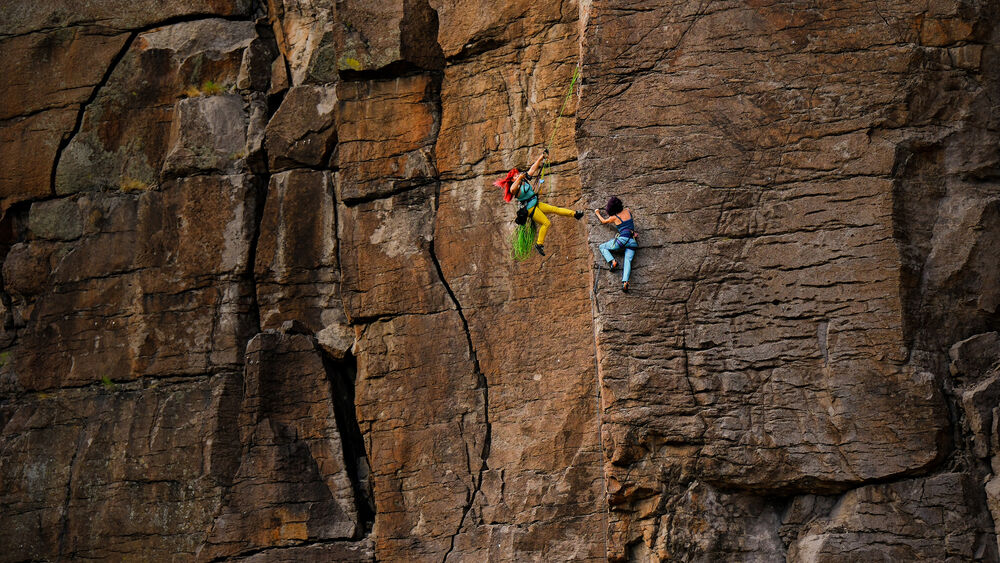
X-Processor 5
Partner to the newly designed sensor is a fresh engine—the X-Processor 5—which uses 64-bit processing to realize 3x faster speeds for both video and photo tasks compared to the X-T4. On the video side, this enables recording at bit rates of up to 720 mb/s.
On the stills end, this quick processing means faster shooting to suit photographing moving subjects. When working with an electronic shutter, shooting at up to 20 fps is possible, with a buffer of 202 consecutive uncompressed raw frames. With the mechanical shutter, shooting speeds of up to 15 fps are possible, along with the ability to shoot upwards of 1000 raw frames in a single burst.
Benefitting both video and stills applications, this processing also benefits the sophisticated and AI-backed autofocus system, helps achieve a 14-stop dynamic range, and enables an enhanced sensitivity range from ISO 125-12800.
4K 120p and 8K 30p Internal Recording
Despite its focus on photography, the X-H2 has an impressive video system capable of 4:2:2 10-bit internal recording in 8K at 30fps and in both DCI/UHD 4K at up to 60 fps and Full HD at up to 240p. A variety of codecs are supported as well, including H.265 and three tiers of ProRes: the high bitrate 422 HQ, the standard 422, and the more compressed 422 LT. Also, continuous recording times up to 160 minutes are possible at all frame rates and resolutions and can be extended to 240 minutes with the external clip-on fan.
External Raw Recording
Using the full-size HDMI port, 12-bit raw video recording is possible when paired with a compatible external recorder. Both ProRes RAW and Blackmagic RAW recording is possible, along with the ability to work with F-Log or F-Log 2 profiles, and either format supports working in resolutions up to the open-gate 8K.
Improved Autofocus and Image Stabilization

Hybrid AF with Deep Learning AI
Benefitted by the improved processing, autofocus performance is noticeably faster and more intelligent. This hybrid focusing system uses 425 phase-detection points and is now sensitive down to -7 EV for working in truly low-light conditions. Also, backed by deep learning, an AI adaptive algorithm means this focusing system is better suited to automatically detect and track a variety of subject types.
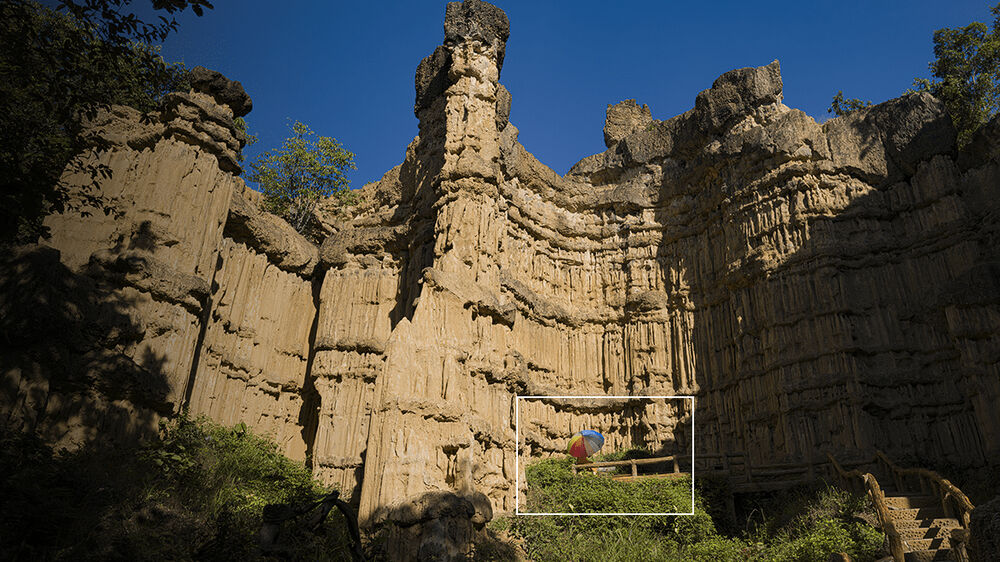
Pixel Shift Multishot
Pixel Shift Multishot takes multiple exposures in rapid succession, each one precisely shifting the image sensor by half a pixel, capturing the subject on a different part of the image sensor each time and yielding a single 160-Megapixel image with the help of the Pixel Shift Combiner software.
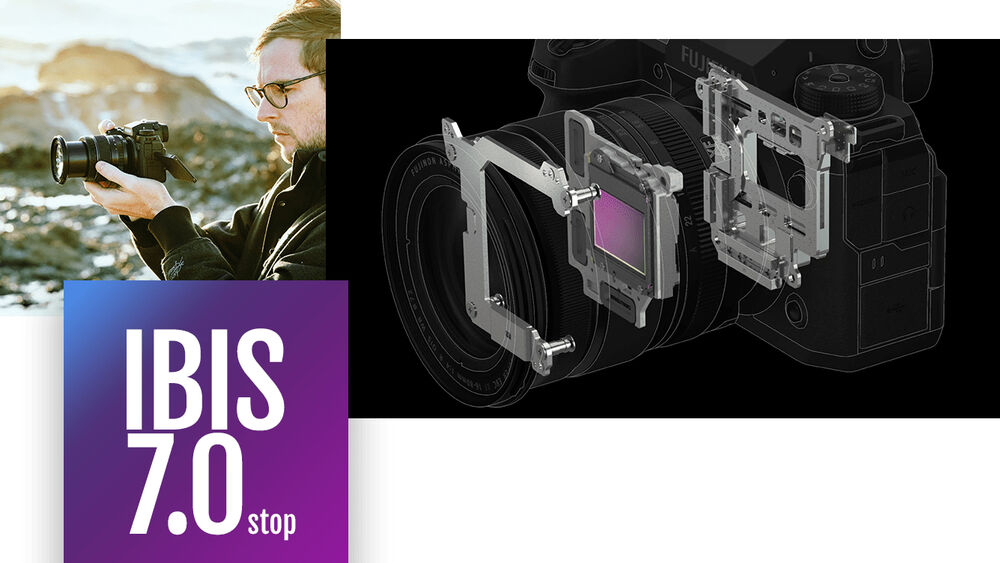
In-Body Image Stabilization
Built-in 5-axis sensor-shift image stabilization helps to minimize the appearance of camera shake by up to 7 stops. This system works in conjunction with most X Series lenses, including non-stabilized ones, and benefits working with slower shutter speeds and when shooting in difficult lighting conditions. Additionally, digital image stabilization can also be used during video recording to further aid in steadying footage, especially when recording handheld.
Body Design
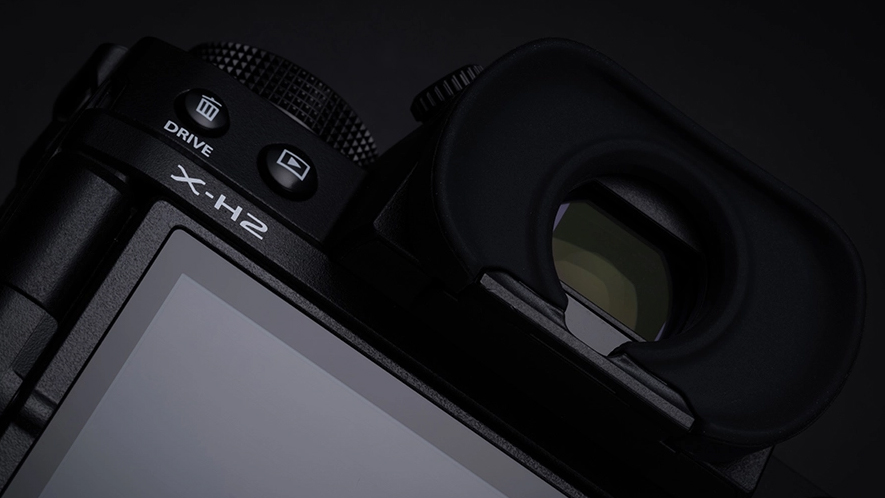
Practical and Durable Design
- Large OLED electronic viewfinder features a crisp 5.76m-dot resolution and a 0.8x magnification for bright, clear, and detailed eye-level viewing.
- Rear 3.0" LCD has a high 1.62m-dot resolution and a touchscreen interface for intuitive control. Also, its vari-angle design means the screen can be flipped out to the side, tilted up or down, and closed with the screen against the body for protection.
- 1.28" monochrome LCD screen on the top plate is a simple means for quickly reviewing shooting settings.
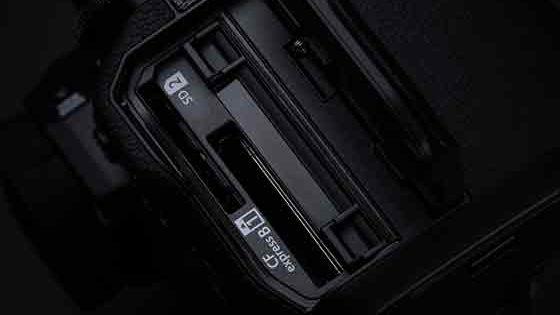
- Dual memory card slots include one CFexpress Type B slot and one SD UHS-II slot for file-saving flexibility. The CFexpress Type B slot should be prioritized for higher bitrate video recording and fast continuous shooting, and the SD slot is a convenient alternative for backups or less speed-critical shooting.
- NP-W235 battery provides approximately 720 frames per charge when working with the EVF in Economy Mode, or approximately 580 frames in Normal Mode.
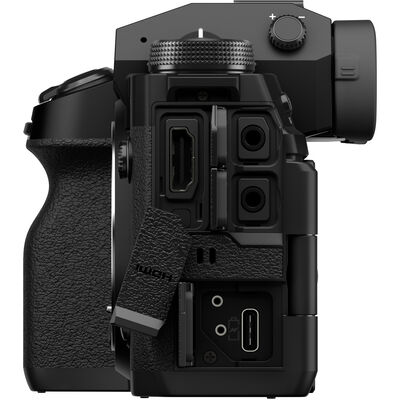
Connectivity
- Full-size HDMI Type A port for outputting video to an external recorder or monitor.
- USB 3.2 Gen 2 Type-C port supports tethering, data transfer, and in-camera battery charging.
- 3.5mm headphone and external microphone ports for greater control over audio recording.
- PC sync port for flash sync.
- 2.5mm remote port for using wired remote controllers.
- Integrated Bluetooth and Wi-Fi connectivity allows for wirelessly sharing images to a mobile device or to use the device to remotely control the camera.
Film Simulation Modes
Film Simulation modes allow you to reproduce the look and feel of several of FUJIFILM's film types, including Provia, Velvia, Astia, Classic Chrome, Classic Neg., Nostalgic Neg., Pro Neg. Hi, Pro Neg. Standard, Eterna, Eterna Bleach Bypass, Acros, Monochrome, and Sepia. Additionally, Grain Effect can be adjusted as well as Color Chrome effect to fine-tune the look of imagery.


Canon EOS R7 Overview
Key Features
- 32.5MP APS-C CMOS Sensor
- Dual Pixel CMOS AF II
- 4K60 10-Bit Video, HDR-PQ & C-Log 3
- 30 fps E. Shutter, 15 fps Mech. Shutter
- 2.36m-Dot OLED EVF
- 1.6m-Dot Vari-Angle Touchscreen LCD
- Sensor-Shift 5-Axis Image Stabilization
- Dual UHS-II Memory Card Slots
- Multi-Function Shoe, Wi-Fi and Bluetooth
EOS R7: Time to Level Up
An ideal blend of performance and portability, the EOS R7 represents Canon's move into APS-C with the mirrorless R system. Featuring a 32.5MP CMOS sensor and DIGIC X processing, this sleek powerhouse is capable of high-speed 30 fps shooting for sports and wildlife and features the renowned Dual Pixel CMOS AF II focusing system to keep up with and track fast-moving subjects. And, for the multimedia image-maker, 4K video is supported at up to 60p, or 30p when oversampled from a 7K area, as well as Full HD at up to 120 fps.
32.5MP APS-C CMOS Sensor and DIGIC X Processing
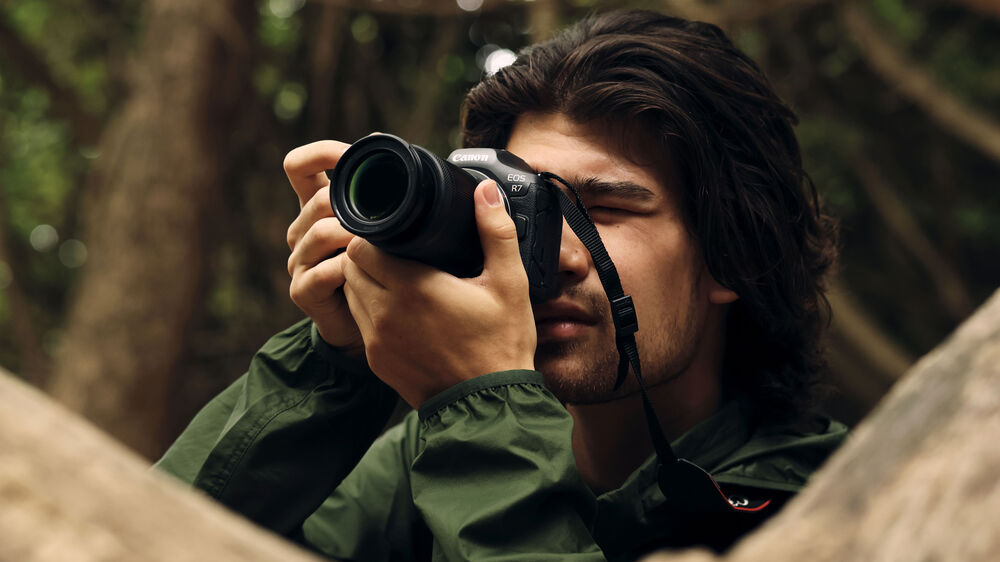
APS-C Comes to EOS R
Balancing resolution, speed, and low-light performance, the 32.5MP APS-C CMOS sensor is a versatile chip perfect for both photo and video applications. As one of the first APS-C sensors in the EOS R system, the R7's high-resolution design benefits photographers as well as 4K video by providing a 7K area for oversampling footage, which yields improved sharpness and quality.

DIGIC X Processor
Borrowed from the R3, the R7 sports a DIGIC X image processor to perform a variety of high-speed tasks, ranging from quick continuous shooting to high-resolution video recording. In terms of high-speed shooting, the R7 supports up to 30 fps continuous shooting with a silent electronic shutter or 15 fps with a mechanical shutter, with AF and AE readings before each frame. The processor also helps to realize a broad sensitivity range from ISO 100-32000, which is expandable up to ISO 51200 for working in difficult lighting conditions.
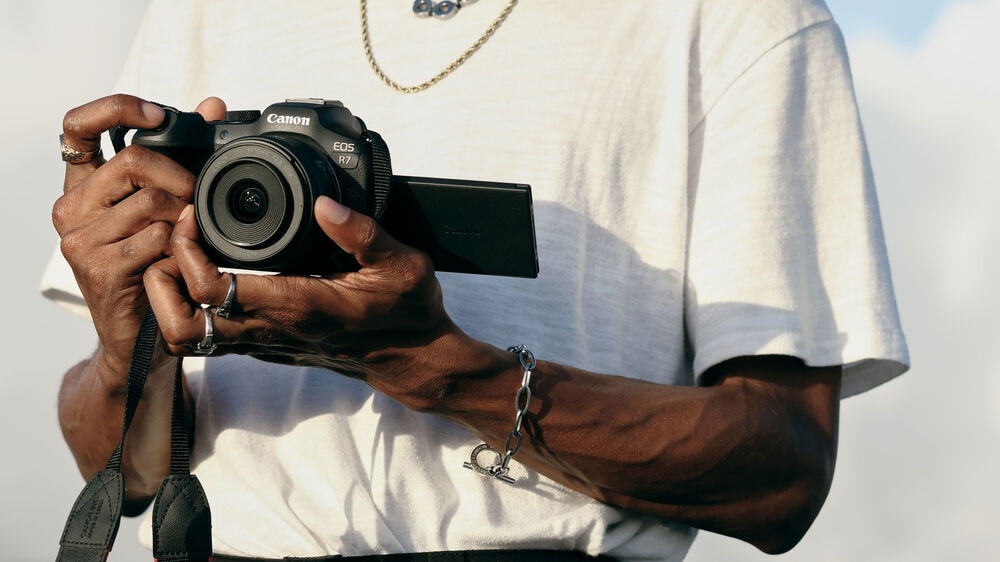
UHD 4K Video Recording
Beyond stills, the R7's sensor also offers high-res UHD 4K 60p internal video using the full width of the sensor and the ability to work with 10-bit sampling with Canon Log 3. A 7K recording area can also be used for oversampled 4K shooting at 30p for improved sharpness, reduced moiré, and lower noise. And, for slow-motion playback, 120p recording is supported at up to Full HD resolution.
HDR-PQ recording is possible, too, for in-camera HDR production and external recording, via the micro-HDMI port, which supports a clean 4K output at up to 60 fps. Also, unlimited recording times are possible, too, and the R7 features both mic and headphone ports, as well as a multi-function shoe for wide accessories compatibility.
Autofocus and Image Stabilization

Dual Pixel CMOS AF II
Carried over from the EOS R3, the advanced Dual Pixel CMOS AF II system features 651 automatic AF points that covers the entire sensor area, for faster, more responsive, and more precise focusing performance. This phase-detection focusing system also has enhanced subject detection and tracking, with the ability to intelligently recognize people, animals, and vehicles and tracking will automatically lock onto these subjects and maintain sharp focus throughout burst captures. Dual Pixel AF II's low-luminance limit focuses down to an impressive -5 EV for accurate focusing even in nighttime conditions.

Sensor-Shift Image Stabilizer
An In-Body Image Stabilizer (IBIS) corrects up to 7 stops of unwanted camera shake when shooting handheld, helping to shoot handheld in low-light conditions and reduce shake when recording videos. This 5-axis system can be also used in conjunction with lenses featuring optical image stabilization to compensate for up to 8 stops of camera shake depending on the specific lens in use.
Body Design
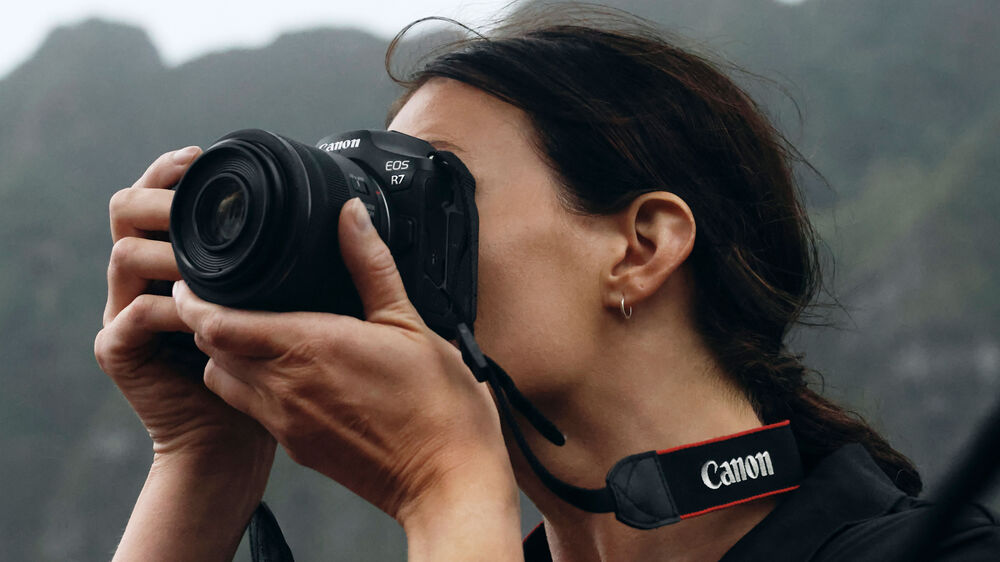
2.36m-Dot EVF and Vari-Angle Touchscreen LCD
A bright, clear 2.36m-dot OLED electronic viewfinder is featured for high-resolution eye-level viewing. This 1.15x-magnification finder is benefitted by the fast processing for virtually no lag and a quick 120-fps refresh rate can be used for vivid, realistic motion portrayal.
In addition to the EVF, a 3.0" vari-angle LCD is also available and benefits working high, low, and front-facing angles. The flexible position is complemented by a touchscreen interface and the clear 1.62m-dot resolution allows for vivid playback and live view monitoring.
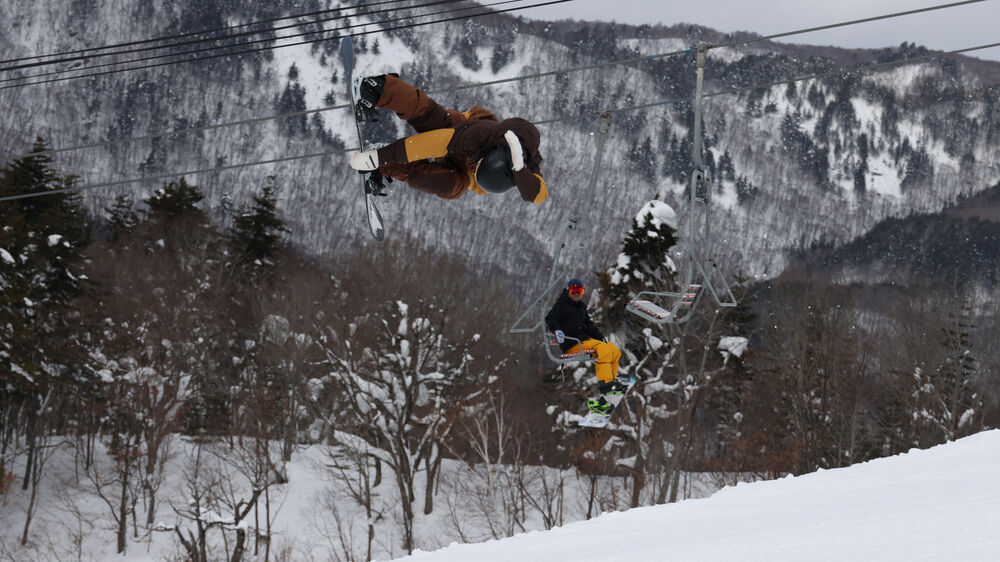
Reliable and Intuitive Construction
- Referencing the professional-grade EOS R3, the R7 is modeled after its robust physical design and sports a dust- and moisture-sealed body construction that's suitable for working in inclement conditions.
- Redesigned rear controls include a combined AF point selector and rear control wheel, which puts two of the most oft-used controls in a single intuitive-to-reach spot.
- Dual SD memory card slots offer file-saving flexibility and both are rated for UHS-II card speeds to support fluent 4K video recording and high-speed continuous shooting.
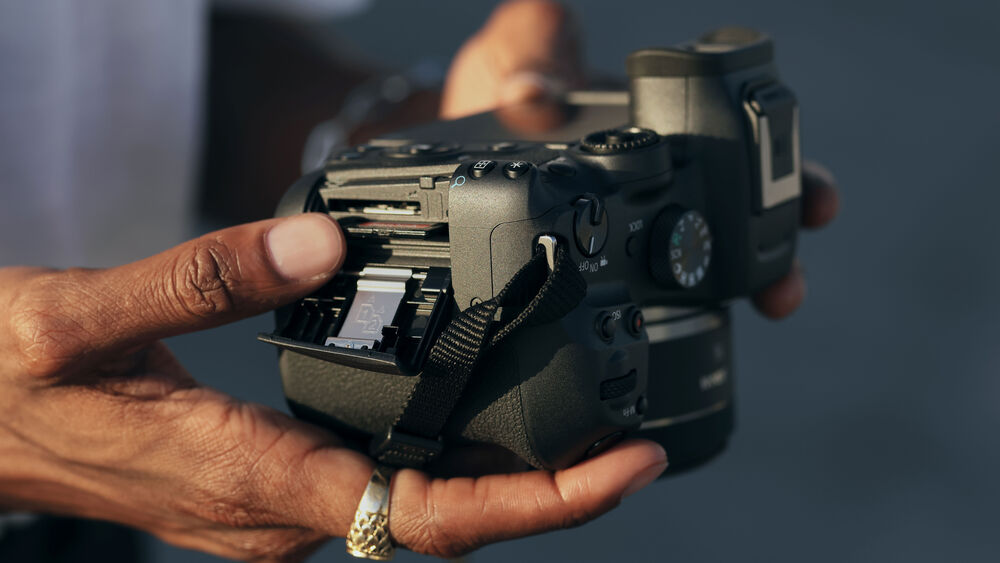
Flexible Connectivity
Wired and wireless connectivity options are available, allowing for multiple methods of transferring photos and videos, as well as for remotely controlling the camera. Physically, the camera features a USB Type-C 3.2 Gen 2 port along and a micro-HDMI port, along with 3.5mm headphone and microphone ports to benefit video recording. In terms of wireless, 2.4GHz Wi-Fi and Bluetooth is available for transferring and remote camera control.
Next-Generation Multi-Function Shoe
An update to a conventional hot shoe, the Multi-Function Shoe adds a row of pins at the front of the design to permit greater accessory functionality as well as provide power to select accessory types that traditionally rely on separate batteries. This updated shoe is compatible with select accessories, including the ST-E10 Speedlite Transmitter, DM-E1D Stereo Microphone, and AD-P1 Smartphone Link Adapter, as well as the AD-E1 Multi-Function Shoe Adapter to provide compatibility with legacy shoe-mounted accessories.
Canon R10 Overview
Key Features
- 24.2MP APS-C CMOS Sensor
- Dual Pixel CMOS AF II
- 4K30 Video, 4K60 with Crop; HDR-PQ
- 23 fps E. Shutter, 15 fps Mech. Shutter
- 2.36m-Dot OLED EVF
- 1.04m-Dot Vari-Angle Touchscreen LCD
- Multi-Function Shoe, Wi-Fi and Bluetooth
- RF-S 18-150mm f/3.5-6.3 IS STM Lens
EOS R10: Compact and Capable, for Content Creators
Emphasizing portability without sacrificing on capability, the Canon EOS R10 is a sleek mirrorless camera with a hybrid ethos. Adept in both photo and video worlds, the R10 brings an APS-C sensor to the R system, along with high-speed shooting, intelligent AF, and impressive 4K video recording to complement a multimedia workflow.
24.2MP APS-C CMOS Sensor and DIGIC X Processing
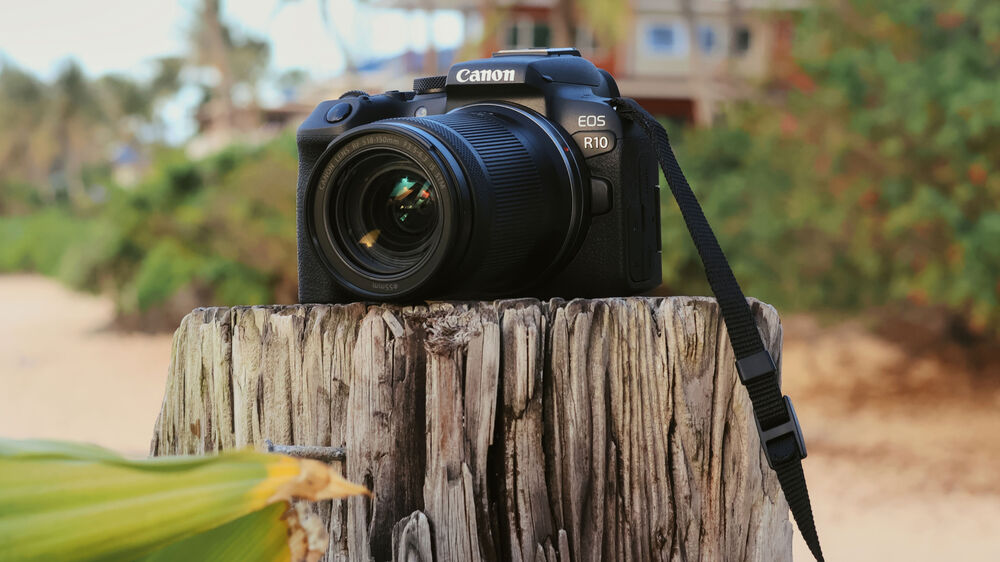
APS-C Comes to EOS R
Sitting at a sweet-spot in terms of resolution, the 24.2MP APS-C CMOS sensor strikes a fine balance between resolution, file size, speed, and low-light performance. This sensor is suitable for general photo tasks along with UHD 4K recording, as the file sizes are manageable enough to allow for quick continuous burst shooting and extended video recording.

DIGIC X Processor
Borrowed from the R3, the R10 sports a DIGIC X image processor to perform a variety of high-speed tasks, ranging from continuous shooting to high-resolution video recording. In terms of high-speed shooting, the R10 supports up to 23 fps continuous shooting with a silent electronic shutter or 15 fps with a mechanical shutter, with AF and AE readings before each frame. The processor also helps to realize a broad sensitivity range from ISO 100-32000, which is expandable up to ISO 51200 for working in difficult lighting conditions.

UHD 4K Video Recording
Beyond stills, the R10's sensor also offers high-res UHD 4K 8-bit recording, with the ability to record at up to 60p using a cropped portion of the sensor or at 30p when using an oversampled 6K recording area for improved sharpness, reduced moiré, and lower noise. And, for slow-motion playback, 120p recording is supported at up to Full HD resolution.
HDR-PQ recording is possible, too, for in-camera HDR production in 10-bit and external recording, via the micro-HDMI port, which supports a clean 4K output. Also, unlimited recording times are possible, too, and the R10 features an external microphone port as well as a multi-function shoe for wide accessories compatibility.
Dual Pixel CMOS AF II

Carried over from the EOS R3, the advanced Dual Pixel CMOS AF II system features 651 automatic AF points that covers the entire sensor area, for faster, more responsive, and more precise focusing performance. This phase-detection focusing system also has enhanced subject detection and tracking, with the ability to intelligently recognize people, animals, and vehicles and tracking will automatically lock onto these subjects and maintain sharp focus throughout burst captures. Dual Pixel AF II's low-luminance limit focuses down to an impressive -4 EV for accurate focusing even in nighttime conditions.
Body Design
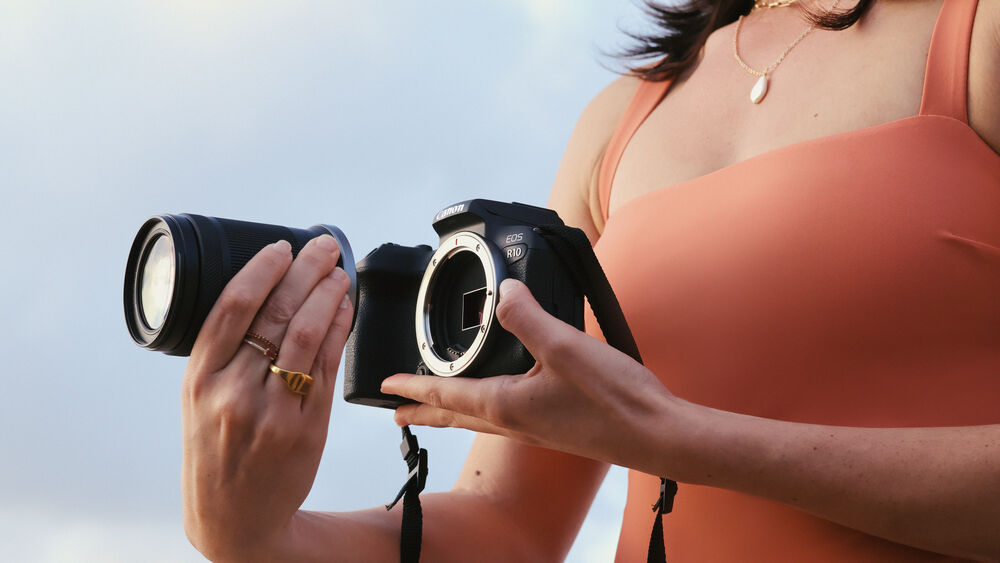
Intuitive Construction
- Bright, clear 2.36m-dot OLED electronic viewfinder is featured for high-resolution eye-level viewing. This 0.95x-magnification finder is benefitted by the fast processing for virtually no lag and a quick 120-fps refresh rate can be used for vivid, realistic motion portrayal.
- A 3.0" vari-angle LCD is also available and benefits working high, low, and front-facing angles. The flexible position is complemented by a touchscreen interface and the clear 1.04m-dot resolution allows for vivid playback and live view monitoring.
- Single SD memory card slot is rated for UHS-II card speeds to support fluent 4K video recording and high-speed continuous shooting.

Flexible Connectivity
Wired and wireless connectivity options are available, allowing for multiple methods of transferring photos and videos, as well as for remotely controlling the camera. Physically, the camera features a USB Type-C port along and a micro-HDMI port, as well as a 3.5mm microphone port to benefit video recording. In terms of wireless, 2.4GHz Wi-Fi and Bluetooth is available for transferring and remote camera control.
Next-Generation Multi-Function Shoe
An update to a conventional hot shoe, the Multi-Function Shoe adds a row of pins at the front of the design to permit greater accessory functionality as well as provide power to select accessory types that traditionally rely on separate batteries. This updated shoe is compatible with select accessories, including the ST-E10 Speedlite Transmitter, DM-E1D Stereo Microphone, and AD-P1 Smartphone Link Adapter, as well as the AD-E1 Multi-Function Shoe Adapter to provide compatibility with legacy shoe-mounted accessories.
RF-S 18-150mm f/3.5-6.3 IS STM Lens
Designed to be an all-around lens for APS-C R Series mirrorless cameras, this 18-150mm zoom offers an equivalent focal length range of 28.8-240mm, which covers wide-angle to telephoto perspectives. The all-in-one zoom uses an UD elements along with two aspherical elements to create aberration-free imagery. A Super Spectra Coating further helps by minimizing ghosting and flaring.
Users will be able to make use of a customizable Control Ring for either manual focus or a programmable setting. Autofocus is smooth and quiet, great for stills and video, thanks to a lead screw-type STM stepping AF motor. Additionally, the lens has an Optical Image Stabilizer that will compensate for up to 4.5 stops of camera shake.
Canon R10 Overview
Key Features
- 24.2MP APS-C CMOS Sensor
- Dual Pixel CMOS AF II
- 4K30 Video, 4K60 with Crop; HDR-PQ
- 23 fps E. Shutter, 15 fps Mech. Shutter
- 2.36m-Dot OLED EVF
- 1.04m-Dot Vari-Angle Touchscreen LCD
- Multi-Function Shoe, Wi-Fi and Bluetooth
- RF-S 18-45mm f/4.5-6.3 IS STM Lens
EOS R10: Compact and Capable, for Content Creators
Emphasizing portability without sacrificing on capability, the Canon EOS R10 is a sleek mirrorless camera with a hybrid ethos. Adept in both photo and video worlds, the R10 brings an APS-C sensor to the R system, along with high-speed shooting, intelligent AF, and impressive 4K video recording to complement a multimedia workflow.
24.2MP APS-C CMOS Sensor and DIGIC X Processing

APS-C Comes to EOS R
Sitting at a sweet-spot in terms of resolution, the 24.2MP APS-C CMOS sensor strikes a fine balance between resolution, file size, speed, and low-light performance. This sensor is suitable for general photo tasks along with UHD 4K recording, as the file sizes are manageable enough to allow for quick continuous burst shooting and extended video recording.

DIGIC X Processor
Borrowed from the R3, the R10 sports a DIGIC X image processor to perform a variety of high-speed tasks, ranging from continuous shooting to high-resolution video recording. In terms of high-speed shooting, the R10 supports up to 23 fps continuous shooting with a silent electronic shutter or 15 fps with a mechanical shutter, with AF and AE readings before each frame. The processor also helps to realize a broad sensitivity range from ISO 100-32000, which is expandable up to ISO 51200 for working in difficult lighting conditions.

UHD 4K Video Recording
Beyond stills, the R10's sensor also offers high-res UHD 4K 8-bit recording, with the ability to record at up to 60p using a cropped portion of the sensor or at 30p when using an oversampled 6K recording area for improved sharpness, reduced moiré, and lower noise. And, for slow-motion playback, 120p recording is supported at up to Full HD resolution.
HDR-PQ recording is possible, too, for in-camera HDR production in 10-bit and external recording, via the micro-HDMI port, which supports a clean 4K output. Also, unlimited recording times are possible, too, and the R10 features an external microphone port as well as a multi-function shoe for wide accessories compatibility.
Dual Pixel CMOS AF II

Carried over from the EOS R3, the advanced Dual Pixel CMOS AF II system features 651 automatic AF points that covers the entire sensor area, for faster, more responsive, and more precise focusing performance. This phase-detection focusing system also has enhanced subject detection and tracking, with the ability to intelligently recognize people, animals, and vehicles and tracking will automatically lock onto these subjects and maintain sharp focus throughout burst captures. Dual Pixel AF II's low-luminance limit focuses down to an impressive -4 EV for accurate focusing even in nighttime conditions.
Body Design

Intuitive Construction
- Bright, clear 2.36m-dot OLED electronic viewfinder is featured for high-resolution eye-level viewing. This 0.95x-magnification finder is benefitted by the fast processing for virtually no lag and a quick 120-fps refresh rate can be used for vivid, realistic motion portrayal.
- A 3.0" vari-angle LCD is also available and benefits working high, low, and front-facing angles. The flexible position is complemented by a touchscreen interface and the clear 1.04m-dot resolution allows for vivid playback and live view monitoring.
- Single SD memory card slot is rated for UHS-II card speeds to support fluent 4K video recording and high-speed continuous shooting.

Flexible Connectivity
Wired and wireless connectivity options are available, allowing for multiple methods of transferring photos and videos, as well as for remotely controlling the camera. Physically, the camera features a USB Type-C port along and a micro-HDMI port, as well as a 3.5mm microphone port to benefit video recording. In terms of wireless, 2.4GHz Wi-Fi and Bluetooth is available for transferring and remote camera control.
Next-Generation Multi-Function Shoe
An update to a conventional hot shoe, the Multi-Function Shoe adds a row of pins at the front of the design to permit greater accessory functionality as well as provide power to select accessory types that traditionally rely on separate batteries. This updated shoe is compatible with select accessories, including the ST-E10 Speedlite Transmitter, DM-E1D Stereo Microphone, and AD-P1 Smartphone Link Adapter, as well as the AD-E1 Multi-Function Shoe Adapter to provide compatibility with legacy shoe-mounted accessories.
RF-S 18-45mm f/4.5-6.3 IS STM Lens
An all-around lens for APS-C R Series mirrorless cameras, this compact 18-45mm zoom offers an equivalent focal length range of 28.8-72mm, which covers wide-angle to portrait-length perspectives. Plus, a retractable design makes it ideal for everyday carry where you want to stuff the camera in a bag.
Canon has taken care with the optical design, using two aspherical elements and the Super Spectra Coating to minimize aberrations and reduce ghosting and flare. An Optical Image Stabilizer will help ensure sharp imagery, providing up to 4 stops of shake correction. Additionally, the lead screw-type STM AF system is fast enough to keep up with speedy continuous focus while being smooth and quiet enough to work for video.
Canon R10 Overview
Key Features
- 24.2MP APS-C CMOS Sensor
- Dual Pixel CMOS AF II
- 4K30 Video, 4K60 with Crop; HDR-PQ
- 23 fps E. Shutter, 15 fps Mech. Shutter
- 2.36m-Dot OLED EVF
- 1.04m-Dot Vari-Angle Touchscreen LCD
- Multi-Function Shoe, Wi-Fi and Bluetooth
EOS R10: Compact and Capable, for Content Creators
Emphasizing portability without sacrificing on capability, the Canon EOS R10 is a sleek mirrorless camera with a hybrid ethos. Adept in both photo and video worlds, the R10 brings an APS-C sensor to the R system, along with high-speed shooting, intelligent AF, and impressive 4K video recording to complement a multimedia workflow.
24.2MP APS-C CMOS Sensor and DIGIC X Processing
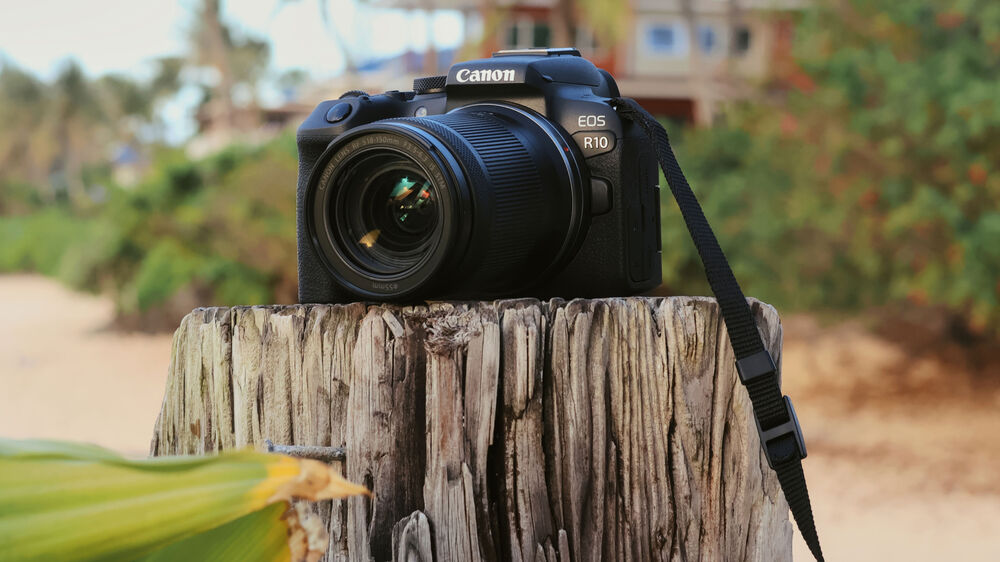
APS-C Comes to EOS R
Sitting at a sweet-spot in terms of resolution, the 24.2MP APS-C CMOS sensor strikes a fine balance between resolution, file size, speed, and low-light performance. This sensor is suitable for general photo tasks along with UHD 4K recording, as the file sizes are manageable enough to allow for quick continuous burst shooting and extended video recording.

DIGIC X Processor
Borrowed from the R3, the R10 sports a DIGIC X image processor to perform a variety of high-speed tasks, ranging from continuous shooting to high-resolution video recording. In terms of high-speed shooting, the R10 supports up to 23 fps continuous shooting with a silent electronic shutter or 15 fps with a mechanical shutter, with AF and AE readings before each frame. The processor also helps to realize a broad sensitivity range from ISO 100-32000, which is expandable up to ISO 51200 for working in difficult lighting conditions.

UHD 4K Video Recording
Beyond stills, the R10's sensor also offers high-res UHD 4K 8-bit recording, with the ability to record at up to 60p using a cropped portion of the sensor or at 30p when using an oversampled 6K recording area for improved sharpness, reduced moiré, and lower noise. And, for slow-motion playback, 120p recording is supported at up to Full HD resolution.
HDR-PQ recording is possible, too, for in-camera HDR production in 10-bit and external recording, via the micro-HDMI port, which supports a clean 4K output. Also, unlimited recording times are possible, too, and the R10 features an external microphone port as well as a multi-function shoe for wide accessories compatibility.
Dual Pixel CMOS AF II

Carried over from the EOS R3, the advanced Dual Pixel CMOS AF II system features 651 automatic AF points that covers the entire sensor area, for faster, more responsive, and more precise focusing performance. This phase-detection focusing system also has enhanced subject detection and tracking, with the ability to intelligently recognize people, animals, and vehicles and tracking will automatically lock onto these subjects and maintain sharp focus throughout burst captures. Dual Pixel AF II's low-luminance limit focuses down to an impressive -4 EV for accurate focusing even in nighttime conditions.
Body Design
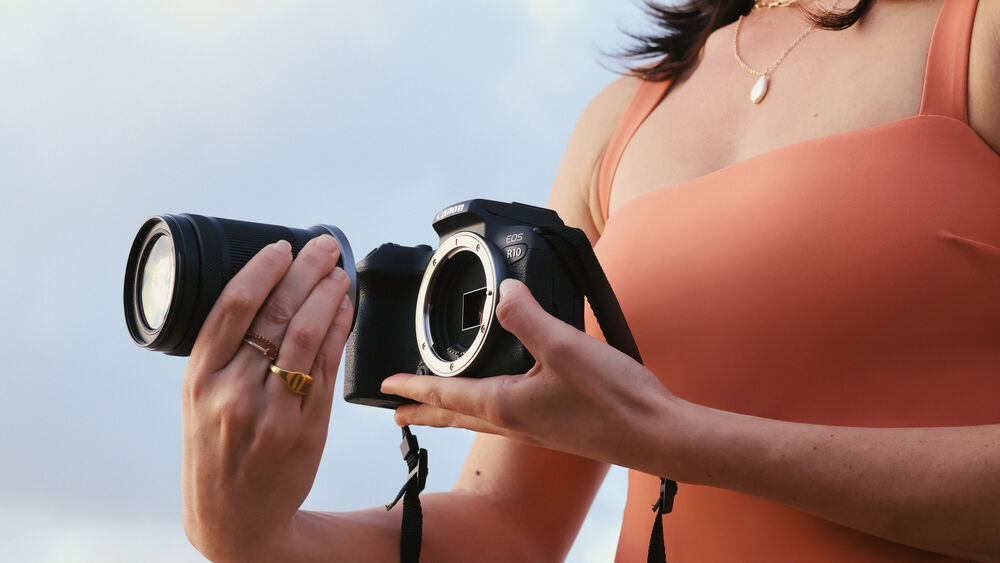
Intuitive Construction
- Bright, clear 2.36m-dot OLED electronic viewfinder is featured for high-resolution eye-level viewing. This 0.95x-magnification finder is benefitted by the fast processing for virtually no lag and a quick 120-fps refresh rate can be used for vivid, realistic motion portrayal.
- A 3.0" vari-angle LCD is also available and benefits working high, low, and front-facing angles. The flexible position is complemented by a touchscreen interface and the clear 1.04m-dot resolution allows for vivid playback and live view monitoring.
- Single SD memory card slot is rated for UHS-II card speeds to support fluent 4K video recording and high-speed continuous shooting.

Flexible Connectivity
Wired and wireless connectivity options are available, allowing for multiple methods of transferring photos and videos, as well as for remotely controlling the camera. Physically, the camera features a USB Type-C port along and a micro-HDMI port, as well as a 3.5mm microphone port to benefit video recording. In terms of wireless, 2.4GHz Wi-Fi and Bluetooth is available for transferring and remote camera control.
Next-Generation Multi-Function Shoe
An update to a conventional hot shoe, the Multi-Function Shoe adds a row of pins at the front of the design to permit greater accessory functionality as well as provide power to select accessory types that traditionally rely on separate batteries. This updated shoe is compatible with select accessories, including the ST-E10 Speedlite Transmitter, DM-E1D Stereo Microphone, and AD-P1 Smartphone Link Adapter, as well as the AD-E1 Multi-Function Shoe Adapter to provide compatibility with legacy shoe-mounted accessories.
Nikon Z30 Mirrorless Camera
Key Features
- 20.9MP DX-Format CMOS Sensor
- UHD 4K30p and Full HD 120p Video
- Live Stream at 60p, In-Camera Time-Lapse
- Vlogging-Optimized Design
- Hybrid AF with Eye and Face Detection
- 3" 1.04m-Dot Free-Angle Touchscreen LCD
- ISO 100-51200, Up to 11 fps Shooting
- Built-In Stereo Mic, Ext. Mic Compatible
- Tally Lamp and Dedicated Selfie Controls
- NIKKOR Z DX 16-50mm f/3.5-6.3 VR Lens
Compact, connected, and designed for creators, the Nikon Z30 is a purpose-built mirrorless camera optimized for vloggers and live streamers. Pairing Nikon's noteworthy image quality, 4K video recording, and a large 20.9MP DX-format sensor with a specialized feature-set and design, the Z30 is designed to elevate your content and tag along on your everyday adventures.
4K Video Recording and Sensor Design
At the heart of the camera is a DX-format 20.9MP CMOS sensor, which benefits not only video production needs but also makes the Z30 a highly capable stills camera, too.
- UHD 4K recording up to 30p is supported for crisp, high-resolution video needs. Full HD 120p recording is available, too, for slow-motion playback.
- Continuous recording for up to 2 hours 15 minutes is possible for documenting events or any other situation that requires longer continuous takes.
- Live streaming is possible at up to Full HD 60p or 4K 30p, and the Z30 is compatible with a variety of web conferencing apps, meaning it can easily function as a high-quality webcam, too.
- For longer takes, streaming, and other instances where you need constant power, the Z30 can be powered via the USB Type-C port.
Photo Capabilities
- Versatile 20.9MP resolution suits stills needs, too, and means the Z30 is a perfect tool for capturing stills during productions or for photographing higher-resolution thumbnails and promotional images.
- The large DX-format sensor benefits working in low-light conditions by producing imagery with low noise, high clarity, and a useful sensitivity range from ISO 100-51200, or up to ISO 25600 when recording video.
- For photographing fast-moving action, a top continuous shooting speed up to 11 fps is available.
- Merging stills and video, in-camera time-lapse production is possible.
- Built-in presets and filters can also be used to refine your photos and videos straight from the camera.
Vlogging Essentials
Purpose-built for vlogging and content creation, the Z30 incorporates a series of physical touches and operational functions perfect for creators:
- Compact body design incorporates a 3.0" 1.04m-dot free-angle LCD screen. This positionable screen can face forward for accurate selfie compositions and can close inward to protect the screen from scratches and fingerprints when not in use.
- Selfie-style controls permit changing the focus position and exposure, as well as setting the self-timer, via the touchscreen when the screen is facing forward.
- Front red tally lamp clearly indicates when the camera is recording.
- Special attention is given to audio recording with the inclusion of a top stereo microphone along with the inclusion of a 3.5mm external microphone port for working with an optional mic. Also, there is an optional dedicated Wind Muff to cut wind noise and improve quality when using the onboard mic.
- Steady your handheld videos using the digital e-VR image stabilization, which helps to reduce unwanted wobbles and shakes while recording.
Fast, Reliable Autofocus
Hybrid autofocus system uses both phase-detection and contrast-detection methods to quickly and accurately acquire focus for both stills and video applications.
- Eye Detection AF uses facial recognition to help lock focus onto subjects' eyes.
- Face and eye tracking can recognize people, dogs, and cats, and can lock onto these subjects and track focus as they move around the scene.
- Ideal for product close-ups, the AF system quickly and naturally shifts focus as you hold something up to the camera and then re-shifts focus to the subject as the product is moved away.
Connectivity and Operation
- Wi-Fi and Bluetooth compatibility work with the Snapbridge app for mobile devices, enabling remote camera control as well as wireless transferring of photos and videos to your smartphone or tablet.
- Intuitive design includes a '?' button to provide a clear explanation of all camera settings, there is a dedicated Auto mode for times when you'd rather the camera optimize the shooting settings, and there's a customizable 'i' menu for quick access to your essential settings.
Nikon NIKKOR Z DX 16-50mm f/3.5-6.3 VR Lens (Black)
Compact and versatile, the Nikon NIKKOR Z DX 16-50mm f/3.5-6.3 VR is a 24-75mm-equivalent zoom designed for DX-format Z-mount mirrorless cameras. Covering a wide-angle to portrait-length zoom range, this lens is well-suited to everyday shooting situations. Its optical design incorporates aspherical and extra-low dispersion elements, which help to reduce a variety of aberrations for sharper, clearer image quality throughout the zoom range. A Super Integrated Coating has also been applied to minimize ghosting and flare for increased contrast and color accuracy in bright and backlit conditions.
The lens's flexible focal length range is complemented by Vibration Reduction image stabilization, which minimizes the appearance of camera shake by up to 4.5 stops for sharper handheld shooting. A stepping motor provides quick, quiet, and precise autofocus performance along with full-time manual focus override to suit both stills and video applications. Also, a programmable control ring can be set for intuitive adjustment over a variety of camera and exposure settings.
Standard zoom is designed for DX-format Nikon Z-mount mirrorless cameras and provides a 24-75mm equivalent focal length range.
One extra-low dispersion element reduces color fringing and chromatic aberrations for improved clarity and color accuracy.
Four aspherical elements minimize spherical aberrations and distortion throughout the zoom range for greater sharpness and accurate rendering.
Super Integrated Coating suppresses flare and ghosting for improved contrast and color fidelity when working in strong lighting conditions.
Stepping motor delivers impressively smooth, quiet, and fast autofocus performance that is well-suited to both stills and video applications. Full-time manual focus override is also possible and an internal focusing design is used, where only the internal lens groups are moved during focusing, to maintain the overall length of the lens during use and to promote faster focusing speeds.
Vibration Reduction image stabilization minimizes the appearance of camera shake by up to 4.5 stops for sharper handheld shooting.
Programmable Control Ring is, by default, set to adjust manual focus but can also be used to control aperture or exposure compensation.
Specialized electromagnetic aperture mechanism provides greater exposure control stability that is especially beneficial when working with fast continuous shooting rates.
Rounded seven-blade diaphragm promotes a pleasing out of focus quality that benefits the use of shallow depth of field techniques.
Fujifilm X-T4 Mirrorless Digital Camera with XF 18-55mm Lens (Black)
Key Features
- 26.1MP APS-C X-Trans BSI CMOS 4 Sensor
- X-Processor 4 Image Processor
- 5-Axis In-Body Image Stabilization
- DCI/UHD 4K at 60 fps, Full HD at 240 fps
Athabasca Square Filter ARK II Starter Pack
1. Athabasca A3 Holder SET
-Athabasca Holder A3 x 1 pc
-HD CPL x 1 pc
-Adapter A3 - 67mm x 1 pc
-Adapter A3 - 72mm x 1 pc
-Adapter A3 - 77mm x 1 pc
-Adapter A3 - 82mm x 1 pc
2. GND8 (0.9) x 1 pc
3. ND64 (6 Stops) x 1 pc
Fujifilm X-T4 Overview
Addressing the needs of multimedia image-makers, the black Fujifilm X-T4 is a versatile mirrorless camera that blends advanced stills and video capabilities along with enhanced workflow and assistive functionality. Utilizing a proven and well-regarded APS-C-format 26.1MP X-Trans CMOS 4 sensor, the X-T4 is capable of high-resolution recording along with support for DCI/UHD 4K video at 60 fps, Full HD recording up to 240 fps, sensitivity from ISO 160-12800, and continuous shooting up to 15 fps with the mechanical shutter. The BSI design of the sensor affords reduced noise and greater overall clarity and is paired with the X-Processor 4 to achieve fast performance and improved responsiveness. The sensor's design also enables a hybrid autofocus system that combines 425 phase-detection points with a contrast-detection system for quick and accurate AF performance. Additionally, complementing all aspects of image production, the X-T4 also incorporates a 6.5 stop-effective sensor-shift image stabilization system to reduce the appearance of camera shake with almost any mounted lens.
Beyond the sensor and processor capabilities, Fujifilm's cameras are also beloved for their physical design, and the X-T4 has an updated design for improved handling and shooting efficiency. A large, bright 3.69m-dot electronic viewfinder can be set to a 100 fps refresh rate for notable smoothness when panning or tracking subjects. Conversely, the rear 3.0" 1.62m-dot touchscreen LCD now features a vari-angle design to suit working from high, low, and front-facing angles; or it can be closed against the body if just working with the EVF. Dual SD UHS-II memory card slots offer file-saving flexibility and the X-T4 supports the updated, high capacity NP-W235 battery that provides approximately 600 shots per charge. Additionally, built-in Wi-Fi and Bluetooth enables wireless remote camera control and image sharing to a mobile device.
26.1MP APS-C X-Trans BSI CMOS 4 Sensor and X-Processor 4
Revolving around a highly versatile sensor, the X-T4 features an APS-C-format 26.1MP X-Trans CMOS 4 sensor, which has a back-illuminated design to afford smooth tonal rendering, improved low-light performance, and a wide native sensitivity Range of ISO 160-12800. As an X-Trans sensor, it utilizes a randomized pixel array, too, which provides a high degree of image quality and sharpness due to the omission of an optical low-pass filter. Versus conventional pixel patterns, the X-Trans design more closely mimics the organic nature of film in order to produce nuanced colors and tonal transitions, while also reducing moiré and aliasing.
The sensor's design also includes an expanded phase-detection autofocus system, which has 425 Selectable points that cover nearly the entire sensor area. This AF system delivers faster, more accurate focusing performance in a variety of lighting conditions down to -6 EV. Complementing the imaging and focusing capabilities, an updated X-Processor 4 is also featured, which has a quad-core CPU, and delivers faster, more responsive performance throughout the camera system, including a full-resolution 15 fps shooting rate with the mechanical shutter, 20 fps rate with an electronic shutter, or a 30 fps rate with an electronic shutter and a 1.25x crop.
In-Body Image Stabilization
Built-in 5-axis sensor-shift image stabilization helps to minimize the appearance of camera shake by up to 6.5 stops. This system works in conjunction with most X Series lenses, including non-stabilized ones, and benefits working with slower shutter speeds and when shooting in difficult lighting conditions. Additionally, 4-axis digital image stabilization can also be used during video recording to further aid in steadying footage, especially when recording handheld.
UHD and DCI 4K Video Recording
Expanding its capabilities beyond stills, the X-T4 offers a versatile array of video capabilities, including internal DCI/UHD 4K recording at up to 60 fps and Full HD recording up to 240 fps for ultra slow-motion playback. Greatly benefitting overall video performance, the speed of the X-Processor 4 enables fast read speeds when recording video and helps to reduce rolling shutter distortion when filming moving subjects. Also, a micro-HDMI port enables 10-bit 4:2:2 recording to an optional external recorder.
In addition to the supported 10-bit color depth, the X-T4 also includes the F-Log gamma setting, which provides a flat picture for use in advanced color grading software during editing. This maximizes the potential dynamic Range in difficult scenes and image adjustments can be made, as well, to highlight tone, shadow tone, color, and sharpness.
Also, the camera features a 3.5mm microphone jack and 2.5mm remote port with included headphone adapter for more advanced audio solutions.
Body Design
- Bright, high-resolution 3.69m-dot OLED electronic viewfinder has a 0.75x magnification and the EVF's refresh rate can be pushed to 100 fps to reduce lag for smoother panning and tracking movements.
- Vari-angle 3.0" 1.62m-dot LCD has a touchscreen design for intuitive operation and playback, and the articulating design greatly benefits working from high and low shooting angles. This vari-angle design also means you can close the screen against the camera body, hiding it from view for distraction-free shooting.
- The top plate incorporates a series of locking dials and levers for fast, intuitive control over exposure settings, including dedicated shutter speed, ISO, and exposure compensation dials that offer direct settings adjustment, even when the camera is off. This exposure compensation dial also has a C position to afford an expanded +/- 5 EV Range when working with the command dials.
- Front and rear command dials integrate a push function for easier use and settings Selection.
- Rear joystick is available for intuitive Selecting and switching of AF points as well as menu navigation and image playback.
- Redeveloped mechanical shutter has improved durability and is rated for 300,000 actuations.
- Integrated Bluetooth and Wi-Fi connectivity allows for wirelessly sharing images to a mobile device or to use the device to remotely control the camera.
- Dual SD memory card slots both support up to the UHS-II standard for fast and flexible file storage.
- Included NP-W235 battery provides approximately 600 frames per charge when working with the EVF.
Film Simulation Modes
- Taking advantage of Fujifilm's vast history in traditional film-based photography, the X-T4 integrates several Film Simulation modes, which mimic the look and feel of some of Fujifilm's classic film types:
- Provia: The standard contrast and normal saturation color transparency film
- Velvia: High contrast, high color saturation, and vivid color transparency film
- Astia: Subdued contrast and color saturation with a look that is ideal for portraits
- Classic Chrome: Delivers muted tones and deep color reproduction, similar to a dated slide film
- Classic Neg: Muted contrast but vibrant colors with a vintage filmic feel
- PRO NegâÂÂAvailable with both Hi and Std. contrast options, this mimics the punchy-but-natural feeling of their professional-grade color negative film
- Eterna: for a cinematic look, this provides a flat color, low saturation look well-suited to post-production color grading
- Eterna Bleach Bypass: Refines the standard Eterna look with a higher key, higher contrast feeling while maintaining the overall desaturated look
- Acros: Based on the popular B&W film, this monochrome mode has a distinct tonality and graininess and can be used along with Yellow, Red, and Green contrast filter effects
- B&W: Straightforward and classic black and white effect with Yellow, Red, and Green contrast filter options
- Sepia: Everyone's favorite old-timey look mimicking the popular alternative process
In addition to simulating specific film types, a Grain Effect mode is also available to replicate the look of old film photos with an organic textured appearance, which is especially noticeable when printing. Color Chrome and Color Chrome Blue effects are also available to deepen color, tonal response, and gradation with higher saturation colors.
ÃÂ
Fujifilm XF 18-55mm f/2.8-4 R LM OIS Lens
Bundled with the camera body is a versatile zoom that covers many different scenarios. The XF 18-55mm f/2.8-4 R LM OIS lens features a 27-84mm equivalent focal length that covers wide angle to telephoto perspectives with ease. The f/2.8-4 maximum aperture Range ensures both speed and compactness in terms of design and it features three aspherical and one extra low dispersion element for combating aberrations. Also, a linear autofocus motor ensures fast performance while an optical image stabilizer will limit the effects of camera shake.
FUJIFILM X-H2S Overview
Key Features
- 26.1MP APS-C X-Trans Stacked BSI Sensor
- 4K 120p, 6.2K 30p, FHD 240p 10-Bit Video
- Internal ProRes 422 HQ and F-Log 2
- 7-Stop In-Body Image Stabilization
- 5.76m-Dot OLED Electronic Viewfinder
- 3" 1.62m-Dot Vari-Angle Touchscreen LCD
- 40 fps E. Shutter, 15 fps Mech. Shutter
- 425-Pt. Hybrid AF, AI Subject Detection
- ProRes & Blackmagic RAW via HDMI
- CFexpress Type B & SD UHS-II Card Slots
X-H2S: The New FUJIFILM Hybrid
Balancing strong photo and video capabilities, the FUJIFILM X-H2S is a multimedia mirrorless camera featuring a newly developed X-Trans stacked sensor, refined AF and subject detection, and impressive 6.2K video recording. Topping the X System, this camera mixes the intuitiveness, design, and image quality FUJIFILM is known for with a fresh, speedy approach to video and continuous shooting applications.
Stacked Sensor and 64-Bit Processing
X-Trans 5 Stacked BSI Sensor
The first X Series camera to feature a stacked sensor, the X-H2S sports an APS-C-format 26.1MP X-Trans 5 stacked BSI sensor, which ups the readout speeds and improves low-light performance compared to previous generations. First, as an X-Trans sensor, it uses the unique color filter array that inherently minimizes moiré and contributes to more natural color rendering; next, the BSI design helps reduce noise and improve tonality and clarity; and, finally, the stacked design greatly reduces rolling shutter and other motion distortion to better suit high-speed video and photo photo applications.
X-Processor 5
Partner to the newly designed sensor is a fresh engine—the X-Processor 5—which uses 64-bit processing to realize 3x faster speeds for both video and photo tasks compared to the X-T4. On the video side, this enables recording at up to 6.2K with high bitrates like ProRes 422 HQ or at high speeds, like with 240 fps recording at Full HD.
On the stills end, this quick processing means faster shooting to suit photographing moving subjects. When working with an electronic shutter, shooting at up to 40 fps is possible, with a buffer of 140 consecutive uncompressed raw frame. With the mechanical shutter, shooting speeds up to 15 fps are possible, along with the ability to shoot upwards of 1000 raw frames in a single burst.
Benefitting both video and stills applications, this processing also benefits the sophisticated and AI-backed autofocus system, helps achieve a 14-stop dynamic range, and enables a broad sensitivity range from ISO 160-12800.
Powerful Video Capabilities
4K 120p and 6.2K 30p Internal Recording
With a penchant for video, the X-H2S has a well-rounded recording system that places this camera squarely in the 'hybrid' category and performs equally well for video as it does for video. Internal 4:2:2 10-bit recording is possible in both DCI/UHD 4K at up to 120p and Full HD at up to 240p as well as an open-gate 3:2 6.2K setting that's suitable for anamorphic applications. A variety of codecs are supported as well, including H.265 and three tiers of ProRes: the high bitrate 422 HQ, the standard 422, and the more compressed 422 LT. Also, continuous recording times up to 90 minutes are possible at all frame rates and resolutions.
External Raw Recording
Using the full-size HDMI port, raw video recording is possible when paired with a compatible external recorder. Both ProRes RAW and Blackmagic RAW recording is possible, along with the ability to work with F-Log or F-Log 2 profiles, and either format supports working in resolutions up to the open-gate 6.2K.
Improved Autofocus and Image Stabilization
Hybrid AF with Deep Learning AI
Benefitted by the improved processing, autofocus performance is noticeably faster and more intelligent. This hybrid focusing system uses 425 phase-detection points and is now sensitive down to -7 EV for working in truly low-light conditions. Also, backed by deep learning, an AI adaptive algorithm means this focusing system is better suited to automatically detect and track a variety of subject types. Compared to previous focusing systems, the X-H2S's Face and Eye Detection capabilities have been refined for greater accuracy and to account for unique features, like glasses, face coverings, and hairlines. Also, the range of recognized subjects types has been expanded to include cars, planes, trains, motorcyclists, birds, horses, dogs, cats and more.
In-Body Image Stabilization
Built-in 5-axis sensor-shift image stabilization helps to minimize the appearance of camera shake by up to 7 stops. This system works in conjunction with most X Series lenses, including non-stabilized ones, and benefits working with slower shutter speeds and when shooting in difficult lighting conditions. Additionally, digital image stabilization can also be used during video recording to further aid in steadying footage, especially when recording handheld.
Body Design
Practical and Durable Design
- Large OLED electronic viewfinder features a crisp 5.76m-dot resolution and a 0.8x magnification for bright, clear, and detailed eye-level viewing.
- Rear 3.0" LCD has a high 1.62m-dot resolution and a touchscreen interface for intuitive control. Also, its vari-angle design means the screen can be flipped out to the side, tilted up or down, and closed with the screen against the body for protection.
- 1.28" monochrome LCD screen on the top plate is a simple means for quickly reviewing shooting settings.
- Dual memory card slots include one CFexpress Type B slot and one SD UHS-II slot for file-saving flexibility. The CFexpress Type B slot should be prioritized for higher bitrate video recording and fast continuous shooting, and the SD slot is a convenient alternative for backups or less speed-critical shooting.
- NP-W235 battery provides approximately 720 frames per charge when working with the EVF in Economy Mode, or approximately 580 frames in Normal Mode.
Connectivity
- Full-size HDMI Type A port for outputting video to an external recorder or monitor.
- USB 3.2 Gen 2 Type-C port supports tethering, data transfer, and in-camera battery charging.
- 3.5mm headphone and external microphone ports for greater control over audio recording.
- PC sync port for flash sync.
- 2.5mm remote port for using wired remote controllers.
- Integrated Bluetooth and Wi-Fi connectivity allows for wirelessly sharing images to a mobile device or to use the device to remotely control the camera.
Film Simulation Modes
Film Simulation modes allow you to reproduce the look and feel of several of FUJIFILM's film types, including Provia, Velvia, Astia, Classic Chrome, Classic Neg., Nostalgic Neg., Pro Neg. Hi, Pro Neg. Standard, Eterna, Eterna Bleach Bypass, Acros, Monochrome, and Sepia. Additionally, Grain Effect can be adjusted as well as Color Chrome effect to fine-tune the look of imagery.


Sony A7 IV Overview
Key Features
- 33MP Full-Frame Exmor R CMOS Sensor
- Up to 10 fps Shooting, ISO 100-51200
- 4K 60p Video in 10-Bit, S-Cinetone
- 3.68m-Dot EVF with 120 fps Refresh Rate
- 3" 1.03m-Dot Vari-Angle Touchscreen LCD
- 759-Pt. Fast Hybrid AF, Real-time Eye AF
- Focus Breathing Compensation
- 5-Axis SteadyShot Image Stabilization
- Creative Looks and Soft Skin Effect
- FE 28-70mm f/3.5-5.6 OSS Lens
- Sony FE 35mm f/1.4 GM Lens
Sony a7 IV Mirrorless Camera
Sony a7 IV: Beyond Basic
An all-arounder that pushes beyond basic, the Sony a7 IV does double duty with strong stills and video performance. An advanced hybrid mirrorless camera, the a7 IV has the resolution and AF performance that appeals to photographers along with robust 4K 60p video recording for filmmakers and content creators.
Sensor and Processor

33MP Exmor R BSI CMOS Sensor
Newly developed 33MP Exmor R full-frame sensor features a back-illuminated design that promotes high clarity, low noise, and vivid color rendering. This design benefits working in low-light conditions and works in conjunction with a broad sensitivity range of ISO 100-51200. The sensor's design also achieves an impressive dynamic range of approximately 15 stops and files can be recorded in raw, JPEG, or the 10-bit HEIF format.
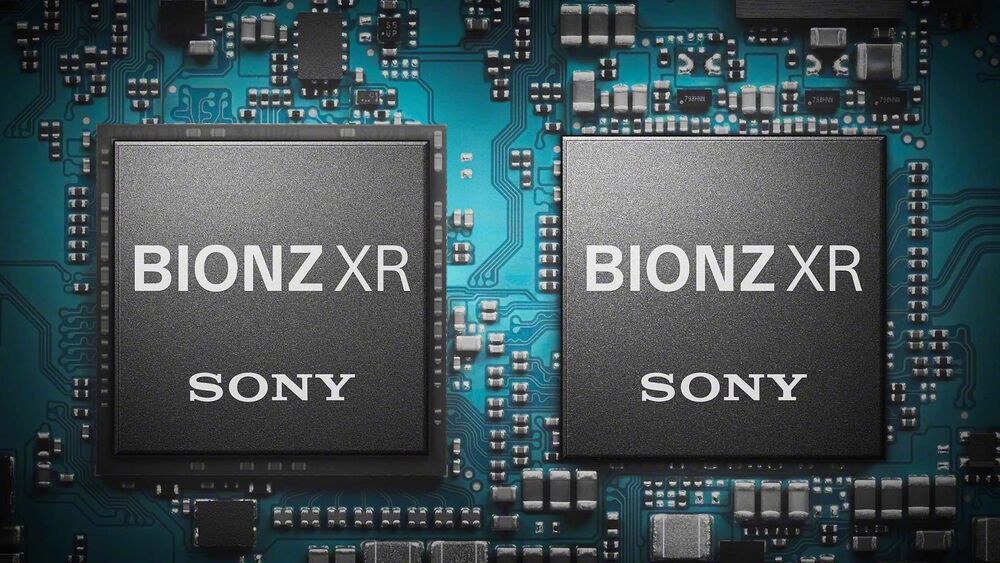
BIONZ XR Processor
Using the flagship-class BIONZ XR engine, high-speed image processing capabilities are available for fast continuous shooting, 4K video recording, and advanced AF tracking performance. The quick processing also helps to reduce rolling shutter and other motion distortions for clean rendering of moving subjects.
In terms of shooting speeds, the sensor and processor enable up to 10 fps shooting, using either the mechanical or electronic shutter and with AF/AE enabled. Also, the buffer permits recording up to 828 consecutive uncompressed raw + JPEG frames when using a CFexpress Type A card.
Video Recording
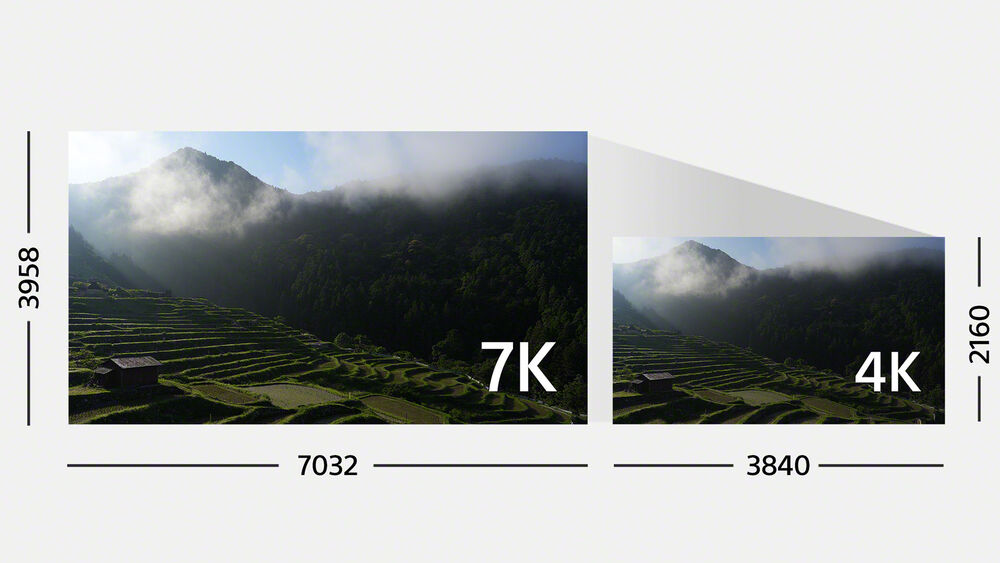
4K 60p Video Recording in 10-Bit
- Making full use of the high-resolution 33MP sensor and fast processing capabilities, UHD 4K 30p XAVC HS 10-bit recording is possible using the full width of the sensor, offering 7K oversampling for impressive sharpness and realism.
- There is also oversampled 4K recording, via a 4.6K capture area, with a Super 35 crop, that offers UHD 4K output up to 60p in 10-bit.
- No recording time limit allows for unlimited clip lengths and the camera's physical design features an improved heat-dissipating structure to promote longer possible recording times; longer than one hour of continuous 4K 60p 10-bit 4:2:2 recording, for example.
- The a7 IV employs a pair of codecs to suit different workflows: XAVC HS, which uses HEVC/H.265 encoding to retain more detail at smaller bitrates and XAVC S-I, which is an intraframe codec for consistent performance and quality at bitrates up to 600 Mb/s.
S-Cinetone, S-Log3, and Other Color and Gamma Controls
- S-Cinetone can be used to deliver distinct colors and healthy-looking skin tone rendering that matches the FX9 and FX6 cameras, along with the a1 and a7S III, and is based on technology from the professional Cinema Line cameras, such as the VENICE. This color profile offers natural mid-tones, soft colors, and especially well-controlled highlights.
- HLG (Hybrid Log-Gamma) support permits recording within a wide color gamut for producing HDR-ready content directly from the camera.
- S-Log3 is also available for producing a 15+-stop dynamic range with increased grading control in the shadow to mid-tone regions of the image.
Fast Hybrid AF System
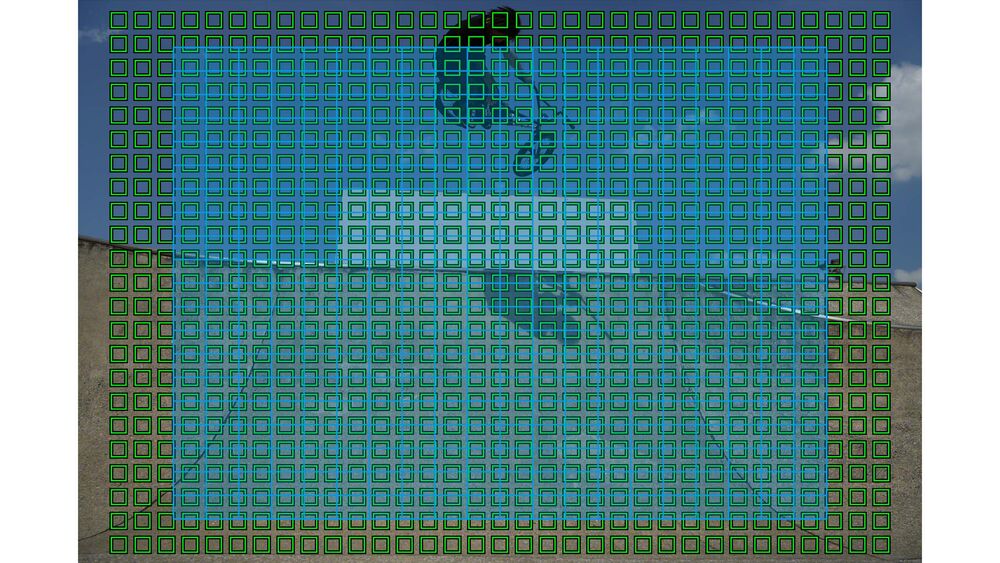
AI-Based Autofocus
Covering approximately 94% of the image area, a Fast Hybrid AF system incorporates 759 phase-detection points for quick and precise focusing in a variety of lighting conditions with sensitivity down to -4 EV. This focusing system is available for use in all recording modes, to benefit both video and stills applications.
Real-time Tracking and Real-time Eye AF
Borrowing from the flagship AF system, the a7 IV has tuned tracking and subject detection capabilities that lock onto subjects quickly and refines focus accurately on recognized eyes and faces of subjects:
- Real-time Tracking is an AI-based subject recognition system that recognizes color, pattern, and subject distance information for high accuracy and focusing speed.
- Beyond just tracking subjects, Real-time Eye AF fine-tunes the focusing accuracy and recognizes human, animal, and bird's eyes for critical sharpness. Real-time Eye AF even maintains focus on a subject's eye when they leave and re-enter the frame, allowing for working in more spontaneous shooting situations.
AF During Video Recording and Additional Focusing Modes
- Real-time Eye AF is fully supported during video recording, for subject detection and tracking of human, animal, and bird eyes while shooting.
- For more control over how focus shifts appear during recording, seven-step AF transition speeds and five-step AF subject shift sensitivity controls let you refine how quickly focus shifts from point to point and how smoothly focusing shifts occur.
- Focus Map is a unique way of visualizing depth of field and functions in a similar way to peaking with a colorful overlay of the scene that indicates which parts of the scene are in front of and behind the focus point depending on the chosen aperture.
- A feature carried over from the FX6 digital cine camera, AF Assist lets you intuitively switch over to manual focus control for adjusting focus position when working with AF. This is a quick way to shift selective focus between various subjects in a scene while recording.
- A unique solution to compensate for how certain lenses perform when racking focus, Focus Breathing compensation will automatically smooth focus transitions and maintain a consistent field of view when changing the focus position during a shot. This mode crops into the image slightly and corrects for any detected shifts in composition when focusing is happening. This function is compatible with select E-mount lenses, check Breathing Compensation lens compatibility here.
Body Design, Connectivity, and Streaming
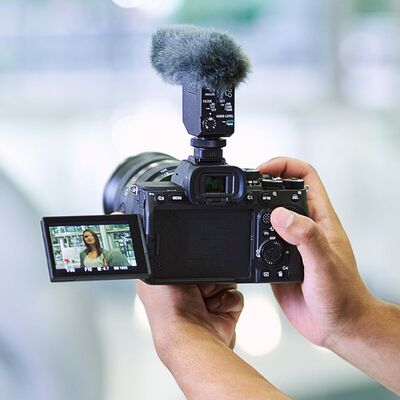
Viewfinder and LCD Screen
- An improved QVGA OLED Tru-Finder EVF features a 3.68m-dot resolution that is approximately 1.6x higher in resolution than its predecessor for sharper, clearer viewing. This viewfinder supports both standard 60 fps and 120 fps frame rates for smooth motion rendering and its physical design has a long 23mm eye point, 0.78x-magnification, and 37.3° field of view.
- Perfect for vlogging or other self-recording needs, the side-opening 3.0" 1.03m-dot vari-angle articulating screen can be used in a front-facing orientation or can be tilted up or down to suit working from high or low shooting angles. This LCD is a touchscreen, too, for intuitive shooting control and menu navigation.
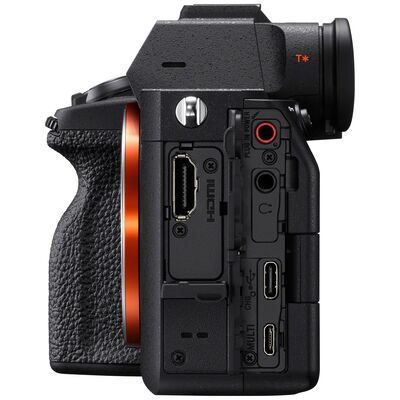
Ports and Interface
- Full-size HDMI A port offers a more reliable connection when working with external recorders.
- A USB 3.2 Gen 2 Type-C port has been added, in addition to a micro-USB port, for faster, more reliable tethering support. The USB Type-C connection allows the camera to be charged or powered from the host power source while connected.
- Both 3.5mm headphone and external microphone ports facilitate greater control over audio recording.
- Multi Interface Shoe supports working with the optional ECM-B1M Shotgun Microphone or XLR-K3M XLR Adapter Kit, which provide improved, clear audio recording sound by sending a digital audio signal to the camera, opposed to an analog signal.
- USB Type-C port can be paired with an optional Ethernet wired LAN adapter to provide 1000BASE-T connectivity, wired remote shooting, or FTP transferring.
5-Axis SteadyShot INSIDE Image Stabilization
- Enhanced 5.5-stop effective 5-axis SteadyShot INSIDE image stabilization system compensates for five different types of camera shake encountered during handheld shooting of stills and video and allows users to confidently use any lens, even adapted lenses, for critical shooting without encountering blur from camera shake.
- For long focal lengths, the system will correct for pitch and yaw adjustments. Macro and high-magnification imagery, on the other hand, will benefit from the inclusion of horizontal and vertical shift compensation. All shooting styles will get usage out of the roll compensation. All 5 axes of stabilization will function at all times, even when used with third-party lenses and adapters or lenses with built-in optical stabilization.
- Additionally, specifically for video, there is also an Active IS mode that adds even more precise stabilization methods for even smoother footage straight out of camera.

Advanced External Flash Control
Suiting working with flash while photographing fast-moving subjects, P-TTL flash metering is possible in between each exposure when working with lo, mid, or even hi-speed continuous shooting modes. This helps to maintain stable illumination if making low-light bursts and greatly benefits working in changing light or low-light conditions. The updated flash control system also helps to reduce flash trigger lag, uses the camera's AWB information for natural color rendering, and supports adjusting select flash and transmitter units directly from the camera's interface.
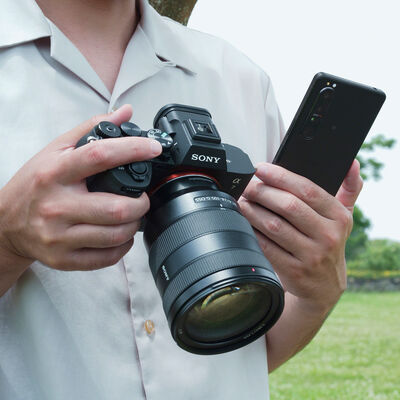
Wireless Connectivity and Streaming
- Built-in Wi-Fi enables the remote camera control and instant sharing of imagery to mobile devices for direct sharing online, and support for both 2.4 and 5 GHz bands also enables wireless tethered shooting support. This connectivity also provides remote camera control.
- Use of the Imaging Edge mobile app is benefitted by Bluetooth to maintain a reliable connection between the camera and mobile device.
- Supports Visual Story for easy cloud-based deliver of photos and videos immediately after shooting.

- Live streaming is possible directly from the camera simply by connecting the camera to a computer or compatible mobile device via USB, allowing the camera's video and audio capabilities to be used for live social media and video conferencing.
- 4K 15p, FHD 60p/30p, and HD 30p recording settings are available and there are also internal Creative Look and Soft Skin effects for a refined image quality straight from the camera.
- Internal recording is supported to a memory card while live streaming.
- UVC and UAC standards are supported for improved picture and sound quality during streaming.
Sony FE 28-70mm f/3.5-5.6 OSS Lens
A Versatile Standard
A top pick for users looking for a lightweight all-around zoom, the FE 28-70mm f/3.5-5.6 OSS Lens from Sony is a great go-to for full-frame E-mount shooters. The lens has a compact, portable design that is ideal for everyday, walkaround use and its versatile wide-angle to portrait-length range suits working with a variety of subject types.
Optical Design
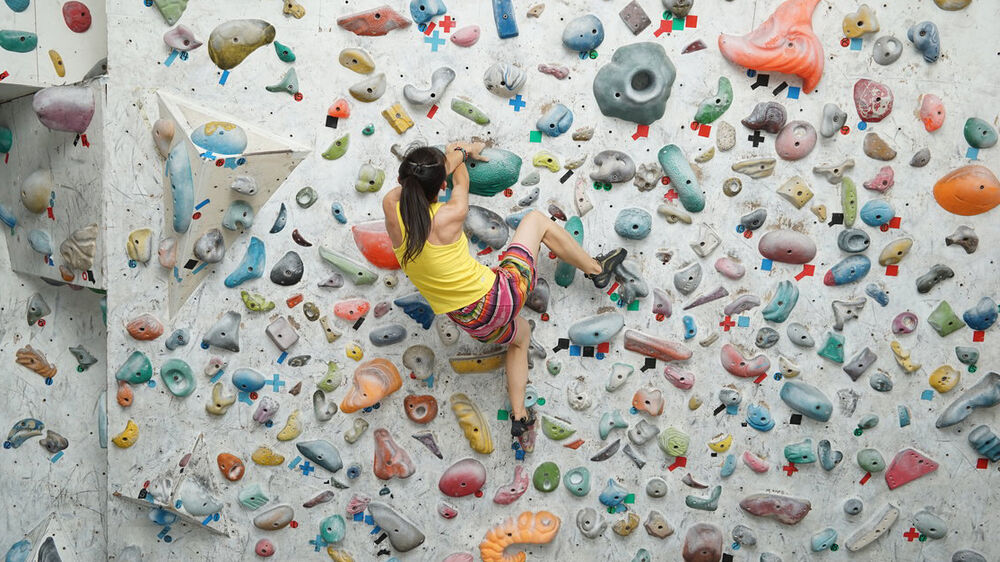
- One extra-low dispersion glass element is featured in the lens design to help reduce chromatic aberrations and color fringing for improved clarity and color neutrality.
- Three aspherical elements are incorporated in the lens design to reduce astigmatism, field curvature, coma, and other monochromatic aberrations.
- Rounded seven-blade diaphragm contributes to a pleasing bokeh quality when employing selective focus techniques.
Autofocus, Image Stabilization, and Design

- An internal focus mechanism and linear motor contribute to faster, more responsive system and easier handling.
- Optical SteadyShot image stabilization helps to minimize the appearance of camera shake for sharper imagery when shooting handheld with slower shutter speeds. This stabilization system can be combined with select camera's sensor-shift type image stabilization for more effective control of camera blur.
- Dust- and moisture-sealed design better permits working in inclement conditions and rubberized control rings benefit handling in colder temperatures.
Sony NP-FZ100 Rechargeable Lithium-Ion Battery (2280mAh)
The 7.2 VDC, 2280mAh NP-FZ100 Rechargeable Lithium-Ion Battery from Sony is a high-capacity Z-series power source for select digital cameras. This battery has InfoLITHIUM support for displaying the remaining charge of the battery on the camera's LCD screen.
Compatible Cameras
Alpha a9 II
Alpha a9
Alpha a7R IV
Alpha a7R III
Alpha a7 III
Alpha a6600
a7S III
a7R IIIA
a7R IVA
Alpha 1
Sony FE 35mm f/1.4 GM Overview
Key Features
- E-Mount Lens/Full-Frame Format
- Aperture Range: f/1.4 to f/16
- Two XA Elements, One ED Element
- Nano AR II and Fluorine Coatings
- Dual XD Linear AF Motors, Internal Focus
- Focus Hold Button, AF/MF Switch
- Physical Aperture Ring; De-Click Switch
- Dust and Moisture-Resistant Construction
- Rounded 11-Blade Diaphragm
Sony Alpha a7 III Mirrorless Digital Camera with 28-70mm Lens
Key Features
- 24MP Full-Frame Exmor R BSI CMOS Sensor
- BIONZ X Image Processor & Front-End LSI
- 693-Point Hybrid AF System
- UHD 4K30p Video with HLG & S-Log3 Gammas
- 2.36m-Dot Tru-Finder OLED EVF
- 3.0" 922k-Dot Tilting Touchscreen LCD
- 5-Axis SteadyShot INSIDE Stabilization
- ISO 204800 and 10 fps Shooting
- Built-In Wi-Fi and NFC, Dual SD Slots
- FE 28-70mm f/3.5-5.6 OSS Lens
Sony a7 III Mirrorless Camera
Well-Rounded Perfection
Distinguished by its updated sensor design, the Sony a7 III is a well-rounded camera suitable for both photo and video applications in a variety of working situations. Refined for improved speed and low-light performance, a new 24.2MP Exmor R BSI CMOS sensor and BIONZ X processor benefit image quality, video capabilities, and AF performance. The a7 III also sports a revised body design, with a new touchscreen LCD, improved EVF, larger battery, and dual memory card slots.
Full-Frame BSI Sensor and BIONZ X Processor
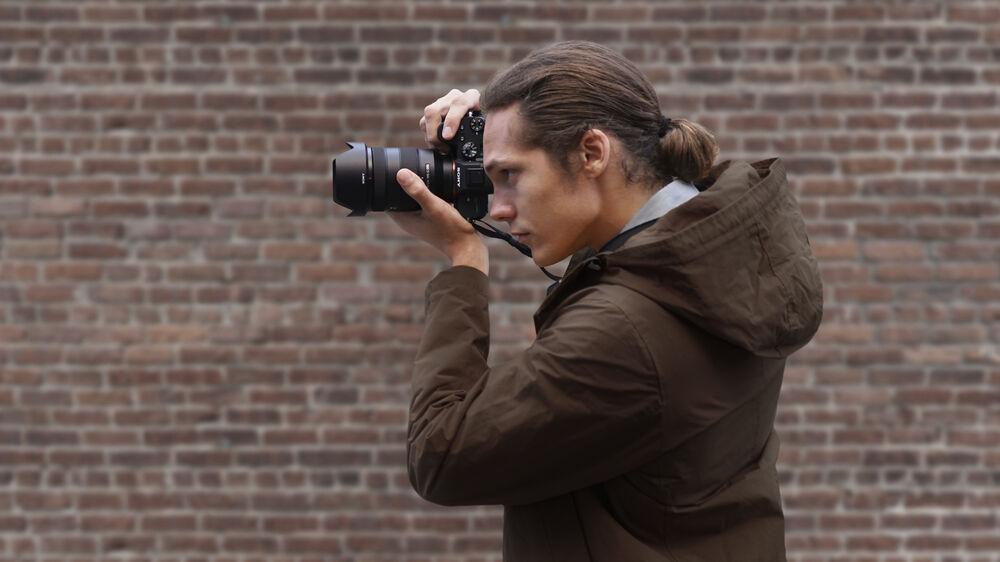
Featuring a back-illuminated design, the full-frame 24.2-megapixel Exmor R CMOS sensor works with the BIONZ X image processor to offer high-resolution stills and video while minimizing noise and improving speed. The BSI design also dramatically improves data transmission speed for creating 14-bit, high-resolution stills with a native sensitivity range from ISO 100-51200, which can be further expanded to ISO 50-204800. Also, it enables internal UHD 4K video recording with a wide dynamic range using the full width of the full-frame sensor. The BIONZ X processor also works in conjunction with a high-speed front-end LSI to realize faster processing times along with the ability to capture an impressive 15-stop dynamic range at low sensitivity values.
The sensor and processor combination also avails fast continuous shooting at up to 10 fps at full resolution, for up to 177 consecutive frames, and with full-time AF/AE when working with either a mechanical shutter or an electronic shutter. If shooting in live view mode, a continuous shooting rate of up to 8 fps is also possible.
UHD 4K Video Recording in XAVC S Format
Internal recording of UHD 4K movies is possible in multiple frame rates up to 30 fps and uses 2.4x oversampling, which renders greater detail, and full pixel readout is possible, too, for higher quality imagery with reduced moiré and aliasing. Full HD 1080p recording is also supported in frame rates up to 120 fps, and both 4K and FHD resolutions utilize the 100 Mb/s XAVC S format contained within an MP4 wrapper with 4:2:0 sampling.
The high-speed, 120 fps recording also enables 4x and 5x slow-motion movie recording with the frame rate set to either 30p or 24p. In addition to high-resolution internal recording, uncompressed HDMI output also enables the use of an optional external recorder for clean 4K recording with 4:2:2 sampling.
S-Log3, HLG, and Other Color and Gamma Controls
Affording extensive customizable color and gamma controls, the a7 III allows users to adjust the gamma, black level, knee, color level, and more. Shooters can use the same S-Log2 Gamma Curve that is found on high end Sony Cinema cameras that squeezes up to 1300% more dynamic range into the video signal then traditional REC709, for increased post-production flexibility.
HLG (Hybrid Log-Gamma) support is available, along with the BT.2020 color space, for recording within a wide color gamut and, in addition to S-Log2, S-Log3 is also available for producing an effective 14-stop dynamic range with increased grading control in the shadow to mid-tone regions of the image.
Autofocus and Image Stabilization
Fast Hybrid AF System
An evolved 4D FOCUS system now employs a combination of 693 phase-detection points, which cover approximately 93% of the frame, along with 425 contrast-detection areas for reliable and quick autofocus and subject tracking performance. This Fast Hybrid AF System now achieves twice the focusing speed and more reliable tracking compared to previous a7 models, as well as improved low-light focusing.
- Lock-on AF maintains focus on moving subjects through the use of a configurable frame that is set over the desired moving subject
- Expand Flexible Spot employs neighboring focus points to retain focus on moving subjects even if the originally selected point loses focus
- Eye AF can be used to base focus on recognized subjects' eyes for portraits and is available in both AF-S and AF-C modes
- Focus Magnifier function can be used for critical focus when homing in on minute subject details
- Rear touchscreen can also be used for Touch Focus control and a Touchpad Focus Control mode lets you use the rear screen intuitively while keeping your eye to the viewfinder
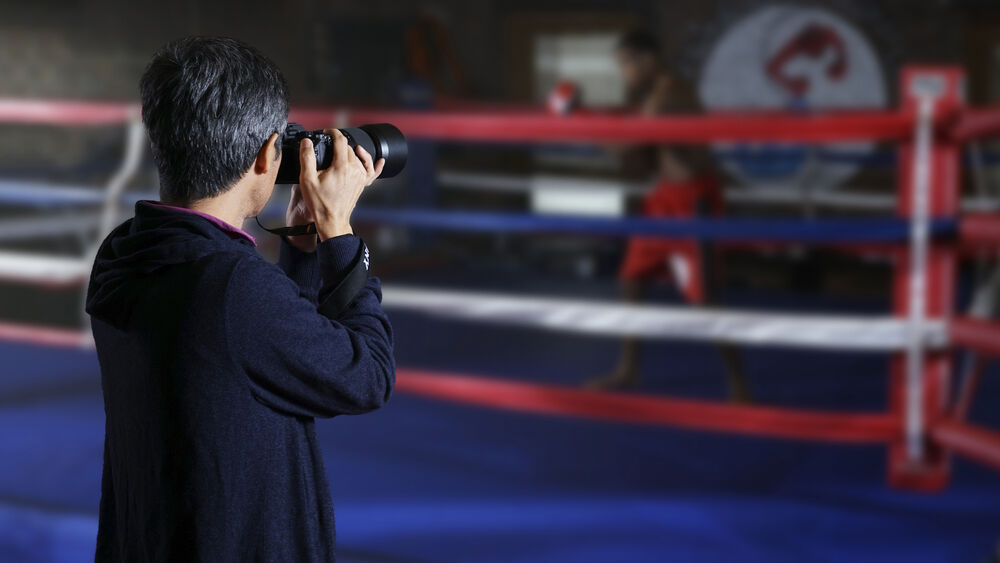
5-Axis SteadyShot INSIDE Image Stabilization
Packed into the robust a7 III is a 5-stop effective 5-axis SteadyShot INSIDE image stabilization system that compensates for five different types of camera shake encountered during handheld shooting of stills and video. This allows users to confidently use any lens, even adapted lenses, for critical imaging without encountering blur from camera shake.
For long focal lengths, the system will correct for pitch and yaw adjustments. Macro and high-magnification imagery, on the other hand, will benefit from the inclusion of horizontal and vertical shift compensation. All shooting styles will get usage out of the roll compensation. All 5 axes of stabilization will function at all times, even when used with third-party lenses and adapters or lenses with built-in optical stabilization.
Body Design and Connectivity
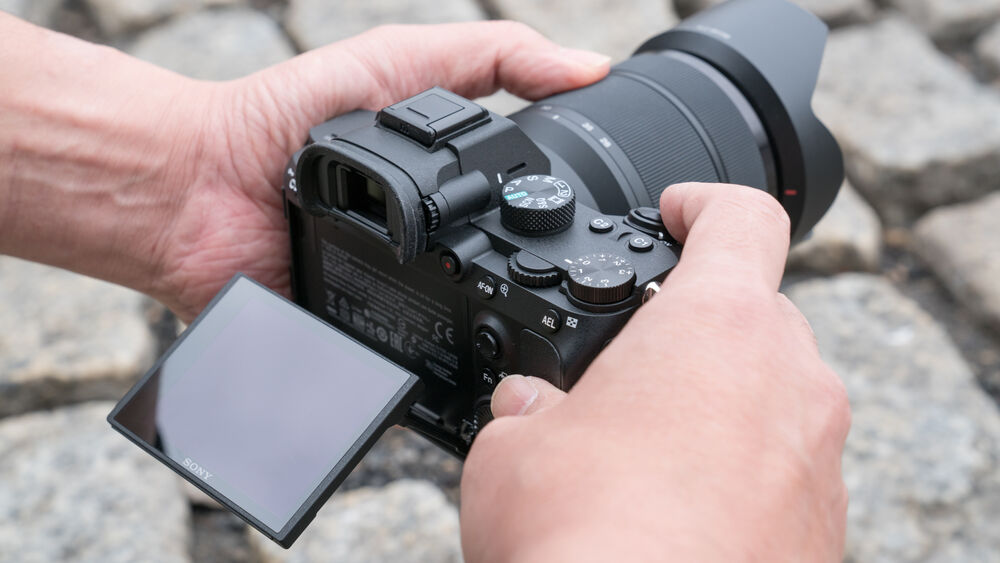
- The XGA OLED Tru-Finder EVF features a 2.36m-dot resolution and 0.78x magnification for bright, clear viewing in high detail.
- In addition to the EVF, a 3.0" 922k-dot rear LCD is also available, which has a touch panel design for intuitive operation and focusing control. The screen also tilts upward 107° and downward 41° to benefit working from high and low angles.
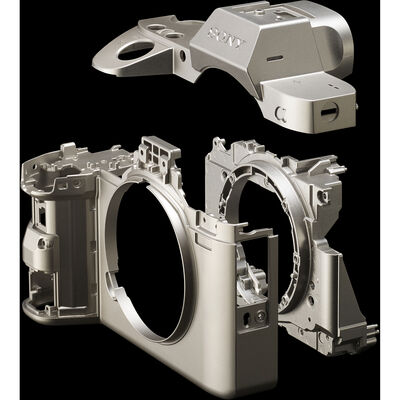
- Magnesium-alloy chassis assures rigidity, durability, and stability while remaining lightweight. The lens mount has also been improved to better support heavy lenses and the grip rigidity has been improved for more comfortable hand-holding.
- Weather-sealing has been employed to resist dust and moisture for reliable operation in harsh weather conditions.
- Using the NP-FZ100 battery, the a7 III has improved battery life and is now rated for approximately 710 shots per charge.
- Dual SD memory card slots allow for flexible file saving and handling, and can be configured to partition raw and JPEG files or can be used for overflow recording. One of the card slots is rated to support UHS-II memory cards.
- A USB 3.0 Type-C port has been added, in addition to a micro-USB port, for faster, more reliable tethering support. The USB Type-C connection allows the camera to be charged from the host power source while connected.
- Built-in Wi-Fi enables the a7 III to instantly share imagery to mobile devices for direct sharing online to social networking, via email, and to cloud storage sites.
- NFC (Near Field Communication) is also supported, which allows for one-touch connection between the camera and compatible mobile devices; no complex set-up is required. Once connected, the linked mobile device can also display a live view image on its screen and remotely control the camera's shutter.
- Bluetooth connectivity allows for location data acquisition.
Sony FE 28-70mm f/3.5-5.6 OSS Lens
A Versatile Standard
A top pick for users looking for a lightweight all-around zoom, the FE 28-70mm f/3.5-5.6 OSS Lens from Sony is a great go-to for full-frame E-mount shooters. The lens has a compact, portable design that is ideal for everyday, walkaround use and its versatile wide-angle to portrait-length range suits working with a variety of subject types.
Optical Design

- One extra-low dispersion glass element is featured in the lens design to help reduce chromatic aberrations and color fringing for improved clarity and color neutrality.
- Three aspherical elements are incorporated in the lens design to reduce astigmatism, field curvature, coma, and other monochromatic aberrations.
- Rounded seven-blade diaphragm contributes to a pleasing bokeh quality when employing selective focus techniques.
Autofocus, Image Stabilization, and Design

- An internal focus mechanism and linear motor contribute to faster, more responsive system and easier handling.
- Optical SteadyShot image stabilization helps to minimize the appearance of camera shake for sharper imagery when shooting handheld with slower shutter speeds. This stabilization system can be combined with select camera's sensor-shift type image stabilization for more effective control of camera blur.
- Dust- and moisture-sealed design better permits working in inclement conditions and rubberized control rings benefit handling in colder temperatures.
Sony Sonnar T* FE 55mm f/1.8 ZA Overview
Key Features
- E-Mount Lens/Full-Frame Format
- Aperture Range: f/1.8 to f/22
- Three Aspherical Elements
- ZEISS T* Anti-Reflective Coating
- Linear Autofocus Motor; Internal Focus
- Minimum Focus Distance: 1.6'
- Dust and Moisture-Resistant Construction
- Rounded 9-Blade Diaphragm
Sony Alpha a7 III Mirrorless Digital Camera with 28-70mm Lens
Key Features
24MP Full Frame Exmor R BSI CMOS Sensor
- BIONZ X Image Processor & Front-End LSI
- 693-Point Hybrid AF System
- UHD 4K30p Video with HLG & S-Log3 Gammas
Distinguished by its updated sensor design, the Alpha a7 III Mirrorless Digital Camera from Sony is a well-rounded camera suitable for both photo and video applications in a variety of working situations. Refined for improved speed and low-light performance, the Full Frame 24.2MP Exmor R BSI CMOS sensor and BIONZ X image processor pair to realize an impressive 10 fps continuous shooting rate and improved autofocus performance for faster, more reliable subject tracking along with wide frame coverage. This updated Fast Hybrid AF System employs a combination of 693 phase-detection points and 425 contrast-detection areas for quicker acquirement of focus in a variety of lighting conditions, and also maintains focus on subjects more effectively. In addition to speed and AF, the processing improvements also help to realize greater image clarity and reduced noise throughout the sensitivity Range from ISO 100-51200, which can further be expanded to ISO 50-204800. Video recording capabilities have also been extended for enhanced quality when recording UHD 4K video with the full width of the Full Frame sensor to minimize moiré and aliasing. Additionally, benefitting both stills and video operation, the a7 III utilizes a 5-axis SteadyShot INSIDE sensor-shift image stabilization, which is now effective to minimize the appearance of camera shake by up to 5 stops.
Beyond just updates to the imaging system, the a7 III's body design has also been revised to include a rear 3.0" 922k-dot touchscreen LCD, which has a tilting design to better support working from high and low angles. A 2.36m-dot Tru-Finder OLED EVF is also featured for bright and clear eye-level monitoring. for greater shooting flexibility, dual SD memory card slots are now featured, and a larger NP-FZ100 battery is also employed to achieve up to approximately 710 shots per charge. Suiting the camera's use in trying conditions, the magnesium-alloy chassis and weather-sealing also render the a7 III dust- and moisture-resistant.
24.2MP Exmor R BSI CMOS Sensor and BIONZ X Image Processor
Featuring a back-illuminated design, the Full Frame 24.2-megapixel Exmor R CMOS sensor works with the BIONZ X image processor to offer high-resolution stills and video while minimizing noise and improving speed. This sensor structure works with a gapless on-chip lens design and an anti-reflection coating to improve light collection and enhance detail. Also, the copper wiring layer dramatically improves data transmission speed for creating 14-bit, high-resolution stills with a native sensitivity Range from ISO 100-51200, which can be further expanded to ISO 50-204800. Also, it enables internal UHD 4K video recording with a wide dynamic Range using the full width of the Full Frame sensor. The BIONZ X processor also works in conjunction with a high-speed front-end LSI to realize faster processing times along with the ability to capture an impressive 15-stop dynamic Range at low sensitivity values.
The sensor and processor combination also avails fast continuous shooting at up to 10 fps at full resolution, for up to 177 consecutive frames, and with full-time AF/AE when working with either a mechanical shutter or an electronic shutter. If shooting in live view mode, a continuous shooting rate of up to 8 fps is also possible.
Fast Hybrid AF System
An evolved 4D FOCUS system now employs a combination of 693 phase-detection points, which cover approximately 93% of the frame, along with 425 contrast-detection areas for reliable and quick autofocus and subject tracking performance. This Fast Hybrid AF System now achieves twice the focusing speed and more reliable tracking compared to previous a7 models, as well as improved low-light focusing. The use of phase-detection points also enables the use of A-mount lenses via the optional LA-EA3 or LA-EA1 lens mount adapters with full continuous AF/AE tracking compatibility.
The apt focus system also lends itself to a variety of focusing functions for refined accuracy, including Lock-on AF, which maintains focus on moving subjects throughout the use of a configurable frame that is set over the desired moving subject, and Expand Flexible Spot, which employs neighboring focus points to retain focus on moving subjects even if the originally Selected point loses focus. Additionally, Eye AF can be used to base focus on recognized subjects' eyes for portraits and is available in both AF-S and AF-C modes. Autofocus can also be used in conjunction with the Focus Magnifier function for critical focus when homing in on minute subject details. The rear touchscreen can also be used for Touch Focus control, and a Touchpad Focus Control mode lets you use the rear screen intuitively while keeping your eye to the viewfinder.
5-Axis SteadyShot INSIDE Image Stabilization
Packed into the robust a7 III is a 5-stop effective 5-axis SteadyShot INSIDE image stabilization system that compensates for five different types of camera shake encountered during handheld shooting of stills and video. This allows users to confidently use any lens, even adapted lenses, for critical imaging without encountering blur from camera shake.
for long focal lengths, the system will correct for pitch and yaw adjustments. Macro and high-magnification imagery, on the other hand, will benefit from the inclusion of horizontal and vertical shift compensation. All shooting styles will get usage out of the roll compensation. All 5 axes of stabilization will function at all times, even when used with third-party lenses and adapters or lenses with built-in optical stabilization.
UHD 4K Video Recording in XAVC S format
Internal recording of UHD 4K movies is possible in multiple frame rates up to 30 fps and using 2.4x oversampling renders greater detail and full pixel readout is possible, that is void of pixel binning, for higher quality imagery with reduced moiré and aliasing. Full Frame 4K recording has also been dramatically improved for improved quality when working at mid to high sensitivities to permit full use of the entire sensor width. Full HD 1080p recording is also supported in frame rates up to 120 fps, and both resolutions utilize the 100 Mb/s XAVC S format contained within an MP4 wrapper with 4:2:0 sampling. The high-speed, 120 fps recording also enables 4x and 5x slow-motion movie recording with the frame rate set to either 30p or 24p. In addition to high-resolution internal recording, uncompressed HDMI output also enables the use of an optional external recorder for clean 4K recording with 4:2:2 sampling.
Affording extensive customizable color and gamma controls, the a7 III allows users to adjust the gamma, black level, knee, color level, and more. Also, users can use the same S-Log2 Gamma Curve that is found on high end Sony Cinema cameras that squeezes up to 1300% more dynamic Range into the video signal then traditional REC709, for increased post-production flexibility. HLG (Hybrid Log-Gamma) support is also available, along with the BT.2020 color space, for recording within a wide color gamut and, in addition to S-Log2, S-Log3 is also available for producing an effective 14-stop dynamic Range with increased grading control in the shadow to mid-tone regions of the image.
Body Design and Built-In Wi-Fi/Bluetooth
- An XGA OLED Tru-Finder EVF is featured, and has a 2.36m-dot resolution and 0.78x magnification for bright, clear viewing in high detail. This viewfinder design also affords the use of autofocus in the Focus Magnifier mode as well as improved focusing peaking to benefit manual focus operation.
- In addition to the EVF, a 3.0" 922k-dot rear LCD is also available, which has a touch panel design for intuitive operation and focusing control. The screen also tilts upward 107 and downward 41 to benefit working from high and low angles.
- Magnesium-alloy chassis assures rigidity, durability, and stability while remaining lightweight. The lens mount has also been improved to better support heavy lenses and the grip rigidity has been improved for more comfortable hand-holding.
- Weather-sealing has been employed to resist dust and moisture for reliable operation in harsh weather conditions.
- Using the NP-FZ100 battery, the a7 III has improved battery life and is now rated for approximately 710 shots per charge.
- Dual SD memory card slots allow for flexible file saving and handling, and can be configured to partition raw and JPEG files or can be used for overflow recording. One of the card slots is rated to support UHS-II memory cards.
- A USB 3.0 Type-C port has been added, in addition to a micro-USB port, for faster, more reliable tethering support. The USB Type-C connection allows the camera to be charged from the host power source while connected.
- Built-in Wi-Fi enables the a7 III to instantly share imagery to mobile devices for direct sharing online to social networking, via email, and to cloud storage sites. NFC (Near Field Communication) is also supported, which allows for one-touch connection between the camera and compatible mobile devices; no complex set-up is required. Once connected, the linked mobile device can also display a live view image on its screen and remotely control the camera's shutter.
- Bluetooth connectivity allows for location data acquisition.
Sony Sonnar T* FE 55mm f/1.8 ZA Overview
A perfect pairing for full-frame Sony E-mount cameras, the Sonnar T* FE 55mm f/1.8 ZA Lens offers excellent resolution and a fast f/1.8 aperture for photographers looking for a high-performing normal-length prime. By using three aspherical elements and Zeiss's legendary T* anti-reflective coating, this lens exhibits an absolute minimum of aberrations and flare. It also has a linear autofocus motor and internal focus design for fast, responsive AF and achieving a minimum focus distance of 1.6'. Additionally, the lens is dust and moisture resistant and uses a nine-blade circular diaphragm for smooth, rounded bokeh.
Sony A7S III Overview
Key Features
- 12MP Full-Frame Exmor R BSI CMOS Sensor
- UHD 4K 120p Video, 10-Bit 4:2:2 Internal
- 16-Bit Raw Output, HLG & S-Cinetone
- 759-Point Fast Hybrid AF
- 9.44m-Dot QXGA OLED EVF
- 3.0" 1.44m-Dot Vari-Angle Touchscreen
- 5-Axis SteadyShot Image Stabilization
- Extended ISO 40-409600, 10 fps Shooting
- Dual CFexpress Type A/SD Card Slots
Optimized video, optimized sensitivity, optimized speed, the Sony Alpha a7S III raises the bar for what a full-frame mirrorless camera is capable of. A revised 12.1MP Exmor R BSI CMOS sensor and updated BIONZ XR image processor offer faster performance, improved noise reduction, and a wider dynamic Range, along with UHD 4K 120p video recording and internal 10-bit 4:2:2 sampling.
Video is the primary application of the a7S III, and improvements to the sensor and processor enable faster readout speeds and greatly reduced rolling shutter, along with high-bitrate internal recording, 16-bit raw output via the full-size HDMI port, and flexible control over motion with variable frame rate Selection. The a7S III also does away with recording time limits and incorporates HLG for direct HDR production as well as S-Log2/S-Log3 gamma profiles for advanced HDR production with editing.
The updated sensor design also brings improved autofocus performance via 759 phase-detection points, which offer intelligent subject tracking and Real-time Eye AF to ensure critical focus on moving subjects in all recording modes. The sensor and BIONZ XR processor also facilitate impressive sensitivity, with an expanded Range from ISO 40-409600, as well as fast 10 fps continuous shooting for up to 1000 consecutive raw frames. Additionally, 5-axis SteadyShot INSIDE sensor-shift image stabilization is available, too, which minimizes the appearance of camera shake by up to 5.5 stops.
Complementing the imaging assets, Sony has also made some changes to the a7S III's physical design, including a rear LCD with a side-open articulating design and an impressive 9.44m-dot OLED electronic viewfinder. The camera's menu system has also been updated for more intuitive navigation and the body design helps to promote better heat dissipation for improved continuous recording capabilities. Additionally, dual memory card slots both support working with CFexpress Type A or SD UHS-II memory cards for flexible and high-speed file storage.
12.1MP Exmor RS BSI CMOS Sensor and BIONZ XR Image Processor
A redesigned 12.1MP full-frame CMOS sensor now features a back-illuminated Exmor RS design in order to achieve improved clarity and reduced noise along with the expectedly impressive sensitivity, from ISO 80-102400 with an extended ISO 40-409600 Range. The updated sensor design also yields 2x faster readout speeds than previous generations and, when coupled with the revised BIONZ XR image processor, greatly reduces rolling shutter by 3x and up to 8x faster processing and overall camera handling. The sensor and processor combination also helps to achieve a wide dynamic Range, of up to approximately 14 stops for stills and 15 stops for video, and 10 fps continuous shooting for up to 1000 uncompressed raw files for stills.
UHD 4K 120p Video, 10-Bit 4:2:2 Internal Recording
Recording up to UHD 4K is possible with frame rates up to 120p, using full 1:1 pixel readout without binning. Internal 10-bit 4:2:2 sampling is also possible in all recording modes and, if recording externally via the full-size HDMI A port, 16-bit raw output is also possible for even greater tonal reproduction and post-production flexibility. Additionally, two codecs have also been developed: XAVC HS, which uses HEVC/H.265 encoding to retain more detail at smaller bitrates, and XAVC S-I, which is an intraframe codec for consistent performance and quality at bitrates up to 600 Mb/s.
The high-speed, 120 fps recording also enables 4x and 5x slow-motion movie recording with the frame rate playback set to either 30p or 24p or, if moving down to Full HD resolution, an effective 240p frame rate is also available for even greater motion control. Additionally, suiting long-form recording, the a7S III does not have any recording time limits to allow for unlimited clip lengths. The camera's physical design also features an improved heat-dissipating structure to promote longer possible recording times, up to an approximate 60-minute recording time at 4K60p.
Affording extensive customizable color and gamma controls, the a7S III allows users to adjust the gamma, black level, knee, color level, and more. Also, users can use the same S-Log2 Gamma Curve that is found on high end Sony Cinema cameras that squeezes up to 1300% more dynamic Range into the video signal then traditional REC709, for increased post-production flexibility. HLG (Hybrid Log-Gamma) support is also available, along with the BT.2020 color space, for recording within a wide color gamut and, in addition to S-Log2, S-Log3 is also available for producing a 15+-stop dynamic Range with increased grading control in the shadow to mid-tone regions of the image.
Fast Hybrid AF System
Covering 92% of the image area, a Fast Hybrid AF system incorporates 759 phase-detection points along with 425 contrast-detection areas for quick and precise focusing in a variety of lighting conditions with sensitivity down to -6 EV. This focusing system is available for use in all recording modes, to benefit both video and stills applications. Additionally, it is able to lock onto subjects quickly and can use Real-time Tracking for AI-based tracking on moving subjects or touch tracking for manual Selection of the subject. Real-time Eye AF, suitable for both humans and animals, also ensures critical sharpness when shooting portraits. Helping to fine-tune how the focusing system performs, seven-step AF transition speed and five-step AF subject shift sensitivity controls let you refine how quickly focus shifts from point to point and how smoothly focusing shifts occur.
5-Axis SteadyShot INSIDE Image Stabilization
The a7S III incorporates an enhanced 5.5-stop effective 5-axis SteadyShot INSIDE image stabilization system, which compensates for five different types of camera shake encountered during handheld shooting of stills and video. This allows users to confidently use any lens, even adapted lenses, for critical imaging without encountering blur from camera shake.
for long focal lengths, the system will correct for pitch and yaw adjustments. Macro and high-magnification imagery, on the other hand, will benefit from the inclusion of horizontal and vertical shift compensation. All shooting styles will get usage out of the roll compensation. All 5 axes of stabilization will function at all times, even when used with third-party lenses and adapters or lenses with built-in optical stabilization.
Additionally, specifically for video, there is also an Active IS mode that adds even more precise stabilization methods for even smoother footage straight out of camera.
Body Design and Connectivity
- An impressive QXGA OLED Tru-Finder EVF features a high 9.44m-dot resolution and 0.9x magnification for exceptionally bright, clear, and detailed eye-level viewing. This viewfinder has a dedicated 120 fps High Quality setting for smooth motion rendering and the finder's physical design has a long 25mm eye point, 41° field of view, and features a fluorine coating on the outermost viewfinder element to benefit cleaning.
- A first for a7-series cameras, a side-opening 3.0" 1.44m-dot vari-angle articulating screen benefits working from high and low angles as well as a front-facing position for vlogging or other self-recording needs. This LCD is a touchscreen, too, for intuitive shooting control and menu navigation.
- Dual memory card slots both accept either CFexpress Type A or SD-type memory cards. The dual slot design allows for flexible file saving and handling and can be configured to partition file types or can be used for overflow recording. Additionally, both of the card slots are rated to support UHS-II memory cards for faster transfer speeds.
- Redesigned menu structure is more intuitive and complements having different workflows and settings Selections for movie recording and stills shooting. The menu system also works in conjunction with the touchscreen design of the rear LCD.
- Magnesium alloy chassis assures rigidity, durability, and stability while remaining lightweight. The lens mount has also been improved to better support heavy lenses, and the grip rigidity has been improved for more comfortable hand-holding.
- Extensive weather-sealing, including enhanced sealing around the battery cover, terminal cover, and chassis joints, has been employed to resist dust and moisture for reliable operation in harsh weather conditions.
- Accepts the high-capacity NP-FZ100 rechargeable lithium-ion battery, which provides approximately 510 shots/80 minutes of recording per charge when using the viewfinder or 600 shots/95 minutes of recording per charge when using the rear LCD.
- Full-size HDMI A port offers a more reliable connection when working with external recorders.
- A USB 3.2 Gen 1 Type-C port has been added, in addition to a micro-USB port, for faster, more reliable tethering support. The USB Type-C connection allows the camera to be charged or powered from the host power source while connected.
- Both 3.5mm headphone and external microphone ports facilitate greater control over audio recording.
- Multi Interface Shoe supports working with the optional ECM-B1M Shotgun Microphone or XLR-K3M XLR Adapter Kit, which provide improved, clear audio recording sound by sending a digital audio signal to the camera, opposed to an analog signal.
- Built-in Wi-Fi enables the remote camera control and instant sharing of imagery to mobile devices for direct sharing online, and support for both 2.4 and 5 GHz bands also enables wireless tethered shooting support. This connectivity also provides remote camera control
- USB Type-C port can be paired with an optional Ethernet wired LAN adapter to provide 1000BASE-T connectivity, wired remote shooting, or FTP transferring.
Sony FE 35mm f/1.4 GM Overview
Key Features
- E-Mount Lens/Full-Frame Format
- Aperture Range: f/1.4 to f/16
- Two XA Elements, One ED Element
- Nano AR II and Fluorine Coatings
- Dual XD Linear AF Motors, Internal Focus
- Focus Hold Button, AF/MF Switch
- Physical Aperture Ring; De-Click Switch
- Dust and Moisture-Resistant Construction
- Rounded 11-Blade Diaphragm
A classic wide-angle prime with an updated, sleek form factor, the Sony FE 35mm f/1.4 GM is further characterized by its speed and advanced optical design. The versatile focal length suits everything from street shooting to landscape and documentary subjects, and the fast maximum aperture excels in low light and for controlling depth of field.
Sony A7 IV Overview
Key Features
- 33MP Full-Frame Exmor R CMOS Sensor
- Up to 10 fps Shooting, ISO 100-51200
- 4K 60p Video in 10-Bit, S-Cinetone
- 3.68m-Dot EVF with 120 fps Refresh Rate
- 3" 1.03m-Dot Vari-Angle Touchscreen LCD
- 759-Pt. Fast Hybrid AF, Real-time Eye AF
- Focus Breathing Compensation
- 5-Axis SteadyShot Image Stabilization
- Creative Looks and Soft Skin Effect
- FE 28-70mm f/3.5-5.6 OSS Lens
Sony a7 IV Mirrorless Camera
An all-arounder that pushes beyond basic, the Sony a7 IV does double duty with strong stills and video performance. An advanced hybrid mirrorless camera, the a7 IV has the resolution and AF performance that appeals to photographers along with robust 4K 60p video recording for filmmakers and content creators.
Sensor and Processor

33MP Exmor R BSI CMOS Sensor
Newly developed 33MP Exmor R BSI CMOS full-frame sensor features a back-illuminated design that promotes high clarity, low noise, and vivid color rendering. This design benefits working in low-light conditions and works in conjunction with a broad sensitivity range of ISO 100-51200. The sensor's design also achieves an impressive dynamic range of approximately 15 stops and files can be recorded in raw, JPEG, or the 10-bit HEIF format.

BIONZ XR Processor
Using the flagship-class BIONZ XR engine, high-speed image processing capabilities are available for fast continuous shooting, 4K video recording, and advanced AF tracking performance. The quick processing also helps to reduce rolling shutter and other motion distortions for clean rendering of moving subjects.
In terms of shooting speeds, the sensor and processor enable up to 10 fps shooting, using either the mechanical or electronic shutter and with AF/AE enabled. Also, the buffer permits recording up to 828 consecutive uncompressed raw + JPEG frames when using a CFexpress Type A card.
Video Recording

4K 60p Video Recording in 10-Bit
- Making full use of the high-resolution 33MP sensor and fast processing capabilities, UHD 4K 30p XAVC HS 10-bit recording is possible using the full width of the sensor, offering 7K oversampling for impressive sharpness and realism.
- There is also oversampled 4K recording, via a 4.6K capture area, with a Super 35 crop, that offers UHD 4K output up to 60p in 10-bit.
- No recording time limit allows for unlimited clip lengths and the camera's physical design features an improved heat-dissipating structure to promote longer possible recording times; longer than one hour of continuous 4K 60p 10-bit 4:2:2 recording, for example.
- The a7 IV employs a pair of codecs to suit different workflows: XAVC HS, which uses HEVC/H.265 encoding to retain more detail at smaller bitrates and XAVC S-I, which is an intraframe codec for consistent performance and quality at bitrates up to 600 Mb/s.
S-Cinetone, S-Log3, and Other Color and Gamma Controls
- S-Cinetone can be used to deliver distinct colors and healthy-looking skin tone rendering that matches the FX9 and FX6 cameras, along with the a1 and a7S III, and is based on technology from the professional Cinema Line cameras, such as the VENICE. This color profile offers natural mid-tones, soft colors, and especially well-controlled highlights.
- HLG (Hybrid Log-Gamma) support permits recording within a wide color gamut for producing HDR-ready content directly from the camera.
- S-Log3 is also available for producing a 15+-stop dynamic range with increased grading control in the shadow to mid-tone regions of the image.
Fast Hybrid AF System

AI-Based Autofocus
Covering approximately 94% of the image area, a Fast Hybrid AF system incorporates 759 phase-detection points for quick and precise focusing in a variety of lighting conditions with sensitivity down to -4 EV. This focusing system is available for use in all recording modes, to benefit both video and stills applications.
Real-time Tracking and Real-time Eye AF
Borrowing from the flagship AF system, the a7 IV has tuned tracking and subject detection capabilities that lock onto subjects quickly and refines focus accurately on recognized eyes and faces of subjects:
- Real-time Tracking is an AI-based subject recognition system that recognizes color, pattern, and subject distance information for high accuracy and focusing speed.
- Beyond just tracking subjects, Real-time Eye AF fine-tunes the focusing accuracy and recognizes human, animal, and bird's eyes for critical sharpness. Real-time Eye AF even maintains focus on a subject's eye when they leave and re-enter the frame, allowing for working in more spontaneous shooting situations.
AF During Video Recording and Additional Focusing Modes
- Real-time Eye AF is fully supported during video recording, for subject detection and tracking of human, animal, and bird eyes while shooting.
- For more control over how focus shifts appear during recording, seven-step AF transition speeds and five-step AF subject shift sensitivity controls let you refine how quickly focus shifts from point to point and how smoothly focusing shifts occur.
- Focus Map is a unique way of visualizing depth of field and functions in a similar way to peaking with a colorful overlay of the scene that indicates which parts of the scene are in front of and behind the focus point depending on the chosen aperture.
- A feature carried over from the FX6 digital cine camera, AF Assist lets you intuitively switch over to manual focus control for adjusting focus position when working with AF. This is a quick way to shift selective focus between various subjects in a scene while recording.
- A unique solution to compensate for how certain lenses perform when racking focus, Focus Breathing compensation will automatically smooth focus transitions and maintain a consistent field of view when changing the focus position during a shot. This mode crops into the image slightly and corrects for any detected shifts in composition when focusing is happening. This function is compatible with select E-mount lenses, check Breathing Compensation lens compatibility here.
Body Design, Connectivity, and Streaming

Viewfinder and LCD Screen
- An improved QVGA OLED Tru-Finder EVF features a 3.68m-dot resolution that is approximately 1.6x higher in resolution than its predecessor for sharper, clearer viewing. This viewfinder supports both standard 60 fps and 120 fps frame rates for smooth motion rendering and its physical design has a long 23mm eye point, 0.78x-magnification, and 37.3° field of view.
- Perfect for vlogging or other self-recording needs, the side-opening 3.0" 1.03m-dot vari-angle articulating screen can be used in a front-facing orientation or can be tilted up or down to suit working from high or low shooting angles. This LCD is a touchscreen, too, for intuitive shooting control and menu navigation.

Ports and Interface
- Full-size HDMI A port offers a more reliable connection when working with external recorders.
- A USB 3.2 Gen 2 Type-C port has been added, in addition to a micro-USB port, for faster, more reliable tethering support. The USB Type-C connection allows the camera to be charged or powered from the host power source while connected.
- Both 3.5mm headphone and external microphone ports facilitate greater control over audio recording.
- Multi Interface Shoe supports working with the optional ECM-B1M Shotgun Microphone or XLR-K3M XLR Adapter Kit, which provide improved, clear audio recording sound by sending a digital audio signal to the camera, opposed to an analog signal.
- USB Type-C port can be paired with an optional Ethernet wired LAN adapter to provide 1000BASE-T connectivity, wired remote shooting, or FTP transferring.
5-Axis SteadyShot INSIDE Image Stabilization
- Enhanced 5.5-stop effective 5-axis SteadyShot INSIDE image stabilization system compensates for five different types of camera shake encountered during handheld shooting of stills and video and allows users to confidently use any lens, even adapted lenses, for critical shooting without encountering blur from camera shake.
- For long focal lengths, the system will correct for pitch and yaw adjustments. Macro and high-magnification imagery, on the other hand, will benefit from the inclusion of horizontal and vertical shift compensation. All shooting styles will get usage out of the roll compensation. All 5 axes of stabilization will function at all times, even when used with third-party lenses and adapters or lenses with built-in optical stabilization.
- Additionally, specifically for video, there is also an Active IS mode that adds even more precise stabilization methods for even smoother footage straight out of camera.

Advanced External Flash Control
Suiting working with flash while photographing fast-moving subjects, P-TTL flash metering is possible in between each exposure when working with lo, mid, or even hi-speed continuous shooting modes. This helps to maintain stable illumination if making low-light bursts and greatly benefits working in changing light or low-light conditions. The updated flash control system also helps to reduce flash trigger lag, uses the camera's AWB information for natural color rendering, and supports adjusting select flash and transmitter units directly from the camera's interface.

Wireless Connectivity and Streaming
- Built-in Wi-Fi enables the remote camera control and instant sharing of imagery to mobile devices for direct sharing online, and support for both 2.4 and 5 GHz bands also enables wireless tethered shooting support. This connectivity also provides remote camera control.
- Use of the Imaging Edge mobile app is benefitted by Bluetooth to maintain a reliable connection between the camera and mobile device.
- Supports Visual Story for easy cloud-based deliver of photos and videos immediately after shooting.

- Live streaming is possible directly from the camera simply by connecting the camera to a computer or compatible mobile device via USB, allowing the camera's video and audio capabilities to be used for live social media and video conferencing.
- 4K 15p, FHD 60p/30p, and HD 30p recording settings are available and there are also internal Creative Look and Soft Skin effects for a refined image quality straight from the camera.
- Internal recording is supported to a memory card while live streaming.
- UVC and UAC standards are supported for improved picture and sound quality during streaming.
Sony FE 28-70mm f/3.5-5.6 OSS Lens
A Versatile Standard
A top pick for users looking for a lightweight all-around zoom, the FE 28-70mm f/3.5-5.6 OSS Lens from Sony is a great go-to for full-frame E-mount shooters. The lens has a compact, portable design that is ideal for everyday, walkaround use and its versatile wide-angle to portrait-length range suits working with a variety of subject types.
Optical Design

- One extra-low dispersion glass element is featured in the lens design to help reduce chromatic aberrations and color fringing for improved clarity and color neutrality.
- Three aspherical elements are incorporated in the lens design to reduce astigmatism, field curvature, coma, and other monochromatic aberrations.
- Rounded seven-blade diaphragm contributes to a pleasing bokeh quality when employing selective focus techniques.
Autofocus, Image Stabilization, and Design

- An internal focus mechanism and linear motor contribute to faster, more responsive system and easier handling.
- Optical SteadyShot image stabilization helps to minimize the appearance of camera shake for sharper imagery when shooting handheld with slower shutter speeds. This stabilization system can be combined with select camera's sensor-shift type image stabilization for more effective control of camera blur.
- Dust- and moisture-sealed design better permits working in inclement conditions and rubberized control rings benefit handling in colder temperatures.
Sony A7 IV Overview
Key Features
- 33MP Full-Frame Exmor R CMOS BSI Sensor
- Up to 10 fps Shooting, ISO 100-51200
- 4K 60p Video in 10-Bit, S-Cinetone
- 3.68m-Dot EVF with 120 fps Refresh Rate
- 3" 1.03m-Dot Vari-Angle Touchscreen LCD
- 759-Pt. Fast Hybrid AF, Real-time Eye AF
- Focus Breathing Compensation
- 5-Axis SteadyShot Image Stabilization
- Creative Looks and Soft Skin Effect
- 4K 15p UVC/UAC Streaming via USB Type-C
Sony a7 IV: Beyond Basic
melakukan tugas ganda dengan gambar diam dan performa video yang kuat. Sebagai kamera mirrorless hybrid yang canggih, Sony a7 IV memiliki resolusi dan performa AF yang menarik bagi fotografer serta perekaman video 4K 60p yang tangguh untuk pembuat film dan pembuat konten.
Sensor and Processor

33MP Exmor R BSI CMOS Sensor
Sensor full-frame Exmor R BSI CMOS 33MP yang baru dikembangkan menampilkan desain bercahaya belakang yang menghasilkan kejernihan tinggi, noise rendah, dan rendering warna cerah. Desain ini bermanfaat untuk bekerja dalam kondisi cahaya redup dan bekerja bersama dengan rentang sensitivitas ISO 100-51200 yang luas. Desain sensor juga mencapai rentang dinamis yang mengesankan sekitar 15 stop dan file dapat direkam dalam format mentah, JPEG, atau HEIF 10-bit.

BIONZ XR Processor
Dengan menggunakan mesin BIONZ XR kelas unggulan, kemampuan pemrosesan gambar berkecepatan tinggi tersedia untuk pemotretan beruntun yang cepat, perekaman video 4K, dan performa pelacakan AF yang canggih. Pemrosesan cepat ini juga membantu mengurangi rana bergulir dan distorsi gerakan lainnya untuk menghasilkan gambar yang jernih pada subjek yang bergerak.
Dalam hal kecepatan pengambilan gambar, sensor dan prosesor memungkinkan pengambilan gambar hingga 10 fps, baik menggunakan rana mekanis atau elektronik dan dengan AF/AE yang diaktifkan. Selain itu, buffer memungkinkan perekaman hingga 828 frame mentah + JPEG yang tidak terkompresi berturut-turut saat menggunakan kartu CFexpress Tipe A.
Video Recording

4K 60p Video Recording in 10-Bit
- Memanfaatkan sepenuhnya sensor resolusi tinggi 33MP dan kemampuan pemrosesan yang cepat, perekaman UHD 4K 30p XAVC HS 10-bit dimungkinkan menggunakan lebar penuh sensor, menawarkan oversampling 7K untuk ketajaman dan realisme yang mengesankan.
- Ada juga perekaman 4K oversampled, melalui area pengambilan 4,6K, dengan pemotongan Super 35, yang menawarkan output UHD 4K hingga 60p dalam 10-bit.
- Tidak ada batasan waktu perekaman yang memungkinkan panjang klip tidak terbatas dan desain fisik kamera dilengkapi struktur pembuangan panas yang ditingkatkan untuk memungkinkan waktu perekaman yang lebih lama; misalnya, perekaman 4K 60p 10-bit 4:2:2 yang berlangsung lebih dari satu jam.
- a7 IV menggunakan sepasang codec untuk disesuaikan dengan alur kerja yang berbeda: XAVC HS, yang menggunakan pengkodean HEVC/H.265 untuk mempertahankan lebih banyak detail pada bitrate yang lebih kecil dan XAVC S-I, yang merupakan codec intraframe untuk kinerja dan kualitas yang konsisten pada bitrate hingga 600 Mb/dtk.
S-Cinetone, S-Log3, and Other Color and Gamma Controls
- S-Cinetone dapat digunakan untuk menghadirkan warna berbeda dan rendering rona kulit tampak sehat yang cocok dengan kamera FX9 dan FX6, bersama dengan a1 dan a7S III, dan didasarkan pada teknologi dari kamera Cinema Line profesional, seperti VENICE. Profil warna ini menawarkan rona tengah alami, warna lembut, dan highlight yang terkontrol dengan baik.
- Dukungan HLG (Hybrid Log-Gamma) memungkinkan perekaman dalam gamut warna lebar untuk menghasilkan konten siap HDR langsung dari kamera.
- S-Log3 juga tersedia untuk menghasilkan rentang dinamis 15+-stop dengan peningkatan kontrol gradasi pada area bayangan hingga nada tengah pada gambar.
Fast Hybrid AF System

AI-Based Autofocus
Mencakup sekitar 94% area gambar, sistem Fast Hybrid AF menggabungkan 759 titik deteksi fase untuk pemfokusan yang cepat dan tepat dalam berbagai kondisi pencahayaan dengan sensitivitas hingga -4 EV. Sistem pemfokusan ini tersedia untuk digunakan di semua mode perekaman, untuk menguntungkan aplikasi video dan gambar diam.
Real-time Tracking and Real-time Eye AF
Meminjam dari sistem AF andalan, a7 IV telah menyetel kemampuan pelacakan dan deteksi subjek yang mengunci subjek dengan cepat dan menyempurnakan fokus secara akurat pada mata dan wajah subjek yang dikenali:
- Pelacakan Real-time adalah sistem pengenalan subjek berbasis AI yang mengenali informasi warna, pola, dan jarak subjek untuk akurasi tinggi dan kecepatan pemfokusan.
- Selain hanya melacak subjek, Eye AF Real-time menyempurnakan akurasi pemfokusan dan mengenali mata manusia, hewan, dan burung untuk ketajaman kritis. Eye AF Real-time bahkan mempertahankan fokus pada mata subjek saat subjek keluar dan masuk kembali ke dalam bingkai, sehingga memungkinkan untuk bekerja dalam situasi pengambilan gambar yang lebih spontan.
AF During Video Recording and Additional Focusing Modes
- Eye AF Real-time didukung sepenuhnya selama perekaman video, untuk mendeteksi subjek dan melacak mata manusia, hewan, dan burung saat memotret.
- Untuk kontrol lebih besar terhadap tampilan pergeseran fokus selama perekaman, kecepatan transisi AF tujuh langkah dan kontrol sensitivitas pergeseran subjek AF lima langkah memungkinkan Anda menyempurnakan seberapa cepat peralihan fokus dari titik ke titik dan seberapa mulus pergeseran fokus terjadi.
- Peta Fokus adalah cara unik untuk memvisualisasikan kedalaman bidang dan fungsinya mirip dengan peaking dengan hamparan pemandangan berwarna-warni yang menunjukkan bagian pemandangan mana yang berada di depan dan di belakang titik fokus, bergantung pada aperture yang dipilih.
- Sebuah fitur yang dibawa dari kamera film digital FX6, AF Assist memungkinkan Anda secara intuitif beralih ke kontrol fokus manual untuk menyesuaikan posisi fokus saat bekerja dengan AF. Ini adalah cara cepat untuk mengalihkan fokus selektif antara berbagai subjek dalam suatu adegan saat merekam.
- A unique solution to compensate for how certain lenses perform when racking focus, Focus Breathing compensation will automatically smooth focus transitions and maintain a consistent field of view when changing the focus position during a shot. This mode crops into the image slightly and corrects for any detected shifts in composition when focusing is happening. This function is compatible with select E-mount lenses, check Breathing Compensation lens compatibility here.
Body Design, Connectivity, and Streaming

Viewfinder and LCD Screen
- QVGA OLED Tru-Finder EVF yang ditingkatkan memiliki resolusi 3,68m-dot yang kira-kira 1,6x lebih tinggi dalam resolusi dibandingkan pendahulunya untuk tampilan yang lebih tajam dan jernih. Jendela bidik ini mendukung kecepatan bingkai standar 60 fps dan 120 fps untuk rendering gerakan yang mulus dan desain fisiknya memiliki titik mata 23 mm, pembesaran 0,78x, dan bidang pandang 37,3°.
- Sempurna untuk vlogging atau kebutuhan perekaman mandiri lainnya, bukaan samping 3.0" Layar artikulasi vari-angle 1,03m-dot dapat digunakan dalam orientasi menghadap ke depan atau dapat dimiringkan ke atas atau ke bawah agar sesuai dengan sudut pengambilan gambar yang tinggi atau rendah. LCD ini juga merupakan layar sentuh, untuk kontrol pemotretan intuitif dan navigasi menu.

Ports and Interface
- Port HDMI A ukuran penuh menawarkan koneksi yang lebih andal saat bekerja dengan perekam eksternal.
- Port USB 3.2 Gen 2 Type-C telah ditambahkan, selain port micro-USB, untuk dukungan tethering yang lebih cepat dan andal. Koneksi USB Type-C memungkinkan kamera diisi atau diberi daya dari sumber daya host saat terhubung.
- Headphone 3,5 mm dan port mikrofon eksternal memfasilitasi kontrol lebih besar atas perekaman audio.
- Multi Interface Shoe mendukung penggunaan Mikrofon Shotgun ECM-B1M opsional atau Kit Adaptor XLR-K3M XLR, yang menghasilkan suara rekaman audio yang lebih baik dan jernih dengan mengirimkan sinyal audio digital ke kamera, bukan sinyal analog.
- Port USB Type-C dapat dipasangkan dengan adaptor LAN kabel Ethernet opsional untuk menyediakan konektivitas 1000BASE-T, pemotretan jarak jauh berkabel, atau transfer FTP.
5-Axis SteadyShot INSIDE Image Stabilization
- Sistem stabilisasi gambar SteadyShot INSIDE 5-sumbu 5,5-stop yang ditingkatkan dan efektif mengkompensasi lima jenis goyangan kamera berbeda yang ditemui selama pengambilan gambar diam dan video dengan genggaman dan memungkinkan pengguna dengan percaya diri menggunakan lensa apa pun, bahkan lensa yang disesuaikan, untuk pengambilan gambar kritis tanpa mengalami kekaburan dari kamera menggoyang.
- Untuk panjang fokus yang panjang, sistem akan mengoreksi penyesuaian pitch dan yaw. Sebaliknya, citra makro dan pembesaran tinggi akan mendapat manfaat dari penyertaan kompensasi pergeseran horizontal dan vertikal. Semua gaya pemotretan akan mendapatkan penggunaan kompensasi gulungan. Kelima sumbu stabilisasi akan berfungsi setiap saat, bahkan saat digunakan dengan lensa dan adaptor pihak ketiga atau lensa dengan stabilisasi optik internal.
- Selain itu, khusus untuk video, terdapat juga mode Active IS yang menambahkan metode stabilisasi yang lebih presisi untuk hasil rekaman yang lebih halus langsung dari kamera.

Advanced External Flash Control
Menyesuaikan bekerja dengan flash saat memotret subjek yang bergerak cepat, pengukuran flash P-TTL dimungkinkan di antara setiap eksposur saat bekerja dengan mode pemotretan beruntun kecepatan tinggi, sedang, atau bahkan tinggi. Hal ini membantu menjaga kestabilan pencahayaan jika terjadi semburan cahaya redup dan sangat bermanfaat saat bekerja dalam kondisi cahaya atau cahaya redup yang berubah-ubah. Sistem kontrol lampu kilat yang diperbarui juga membantu mengurangi kelambatan pemicu lampu kilat, menggunakan informasi AWB kamera untuk rendering warna alami, dan mendukung penyesuaian unit lampu kilat dan pemancar tertentu langsung dari antarmuka kamera.

Wireless Connectivity and Streaming
- Wi-Fi internal memungkinkan kontrol kamera jarak jauh dan berbagi citra secara instan ke perangkat seluler untuk dibagikan langsung secara online, dan dukungan untuk pita 2,4 dan 5 GHz juga memungkinkan dukungan pengambilan gambar tertambat secara nirkabel. Konektivitas ini juga menyediakan kontrol kamera jarak jauh.
- Penggunaan aplikasi seluler Imaging Edge diuntungkan oleh Bluetooth untuk menjaga koneksi yang andal antara kamera dan perangkat seluler.
- Mendukung Visual Story untuk kemudahan pengiriman foto dan video berbasis cloud segera setelah pengambilan gambar.

- Streaming langsung dapat dilakukan langsung dari kamera hanya dengan menyambungkan kamera ke komputer atau perangkat seluler yang kompatibel melalui USB, sehingga kemampuan video dan audio kamera dapat digunakan untuk media sosial langsung dan konferensi video.
- Tersedia pengaturan perekaman 4K 15p, FHD 60p/30p, dan HD 30p dan terdapat juga efek Creative Look internal dan Soft Skin untuk kualitas gambar yang lebih baik langsung dari kamera.
- Perekaman internal didukung ke kartu memori saat streaming langsung.
- Standar UVC dan UAC didukung untuk meningkatkan kualitas gambar dan suara selama streaming.

